Journal
The journal on portikus.de operates as an extension of the exhibitions at Portikus themselves. A wide spectrum of contributions including essays, interviews, fictional writing or photo- and video-contributions provide a closer look on artistic interests and reflect on topics that concern our society, politics and culture.
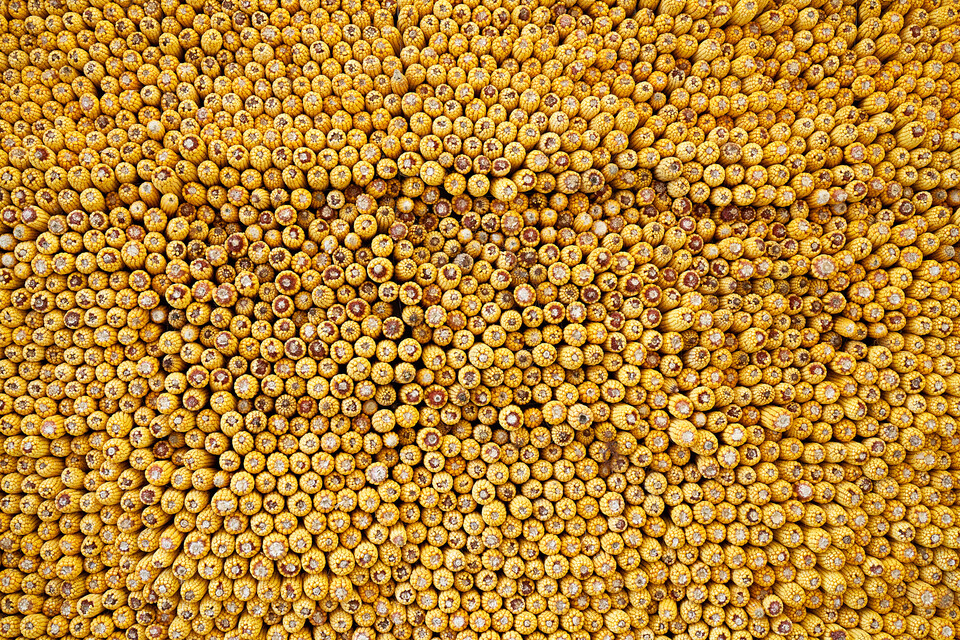
Ximena Garrido-Lecca, 'Inflorescence', Installation view, Portikus, Frankfurt am Main, 2023, photo: Jens Gerber
In 1956, the Chilean poet Pablo Neruda dedicated an ode to the corn plant. In this solemn poem form, he praised the metamorphoses of the grain and its influence on the human condition. The “green lance”, later covered by “golden corn”, is a symbol of the salient and precious plant, but also a reference to the changes in corn culture due to colonization: a weapon always means defense and pain – and gold awakens greed. From the 16th century onward, Spanish chroniclers reported supposed landscapes of gold in their accounts of Central and South America. But they had misunderstood the pre-colonial narrations, whose description referred not to the precious metal, but to cornfields. Even today, graffiti murals in Bogotá’s urban landscape address this misunderstanding of the golden landscapes, illustrating that wealth as a monetary value is based on Western world views and thus deviates strongly from Andean ideologies.
Already in the second paragraph of his Ode to Maize, Neruda formulated a temporal reversal when he admonishes himself to emphasize the “simple grain in the kitchens” instead of the “history in the shroud.” In Inflorescence, her exhibition at Portikus, the artist Ximena Garrido-Lecca (*1980, Lima) starts precisely there, in the kitchens, the everyday, and carries out a change of perspective that already resonates with Neruda. Over the two floors at Portikus, the cultural significance of corn plants can be traced from different perspectives. In doing so, the artist emphasizes how Central and South America, the regions of origin of corn culture, were often not given enough consideration in history and works against the tendency, dominant in colonial chronicles, to overlook the history of development of local plants and thus devalue the agricultural skills and achievements of indigenous cultures.
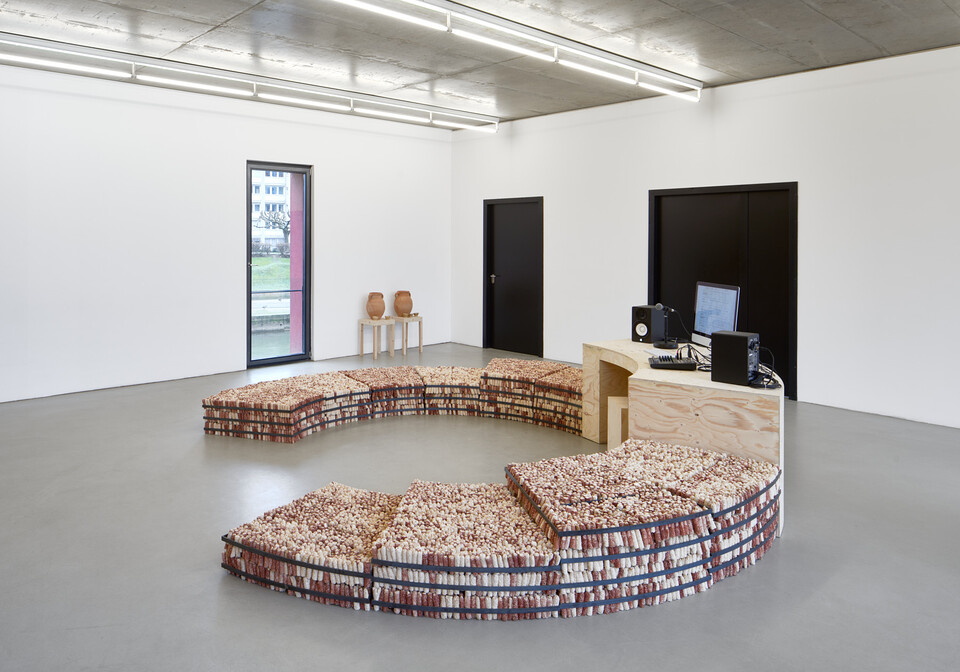
Ximena Garrido-Lecca, 'Inflorescence', Installation view, Portikus, Frankfurt am Main, 2023, photo: Jens Gerber
The flowering period of corn plants in Central Europe lasts from July to September. The grasses and cobs are harvested until late October. For her exhibition at Portikus, Garrido-Lecca responds to the local conditions of the crop plant, exhibiting it in a variety of forms. Whether plants standing upright in bundles or leaning against the wall, corn cobs sturdily set in metal frames that serve as seating, or a wall box filled with dried cobs, corn is the main motif and material of Inflorescence and thus serves as a means for the artist to reflect on the mutual influence of man and nature. The sculptures of bundled corn plants are topped by antennas, as they are known from telecommunications. Sticking out of the bundles, it appears as if they were part of the drying process themselves. Technology and nature can no longer be separated, but rather merge into one another. The challenges resulting from this neo-colonial entanglement are likewise discussed by the many voices that are part of the radio broadcasts accompanying the exhibition, and deepened with ecological, social, biological as well as political aspects: The desire for diversity of varieties and ecological cultivation measures on the one hand, and the ever-growing spread of genetically modified corn1 on the other hand, is a paradox whose magnitude becomes tangible as one listens. The antennas thus symbolically stand not only for global networking, far-reaching communication, and knowledge transfer, but, in their relationship to corn, also for clinging ambivalences. Partly radiant, sometimes lattice-like, their shimmering rods suggest an anthropological imbalance and from a material point of view it is evident that the aluminum will outlast the plant.
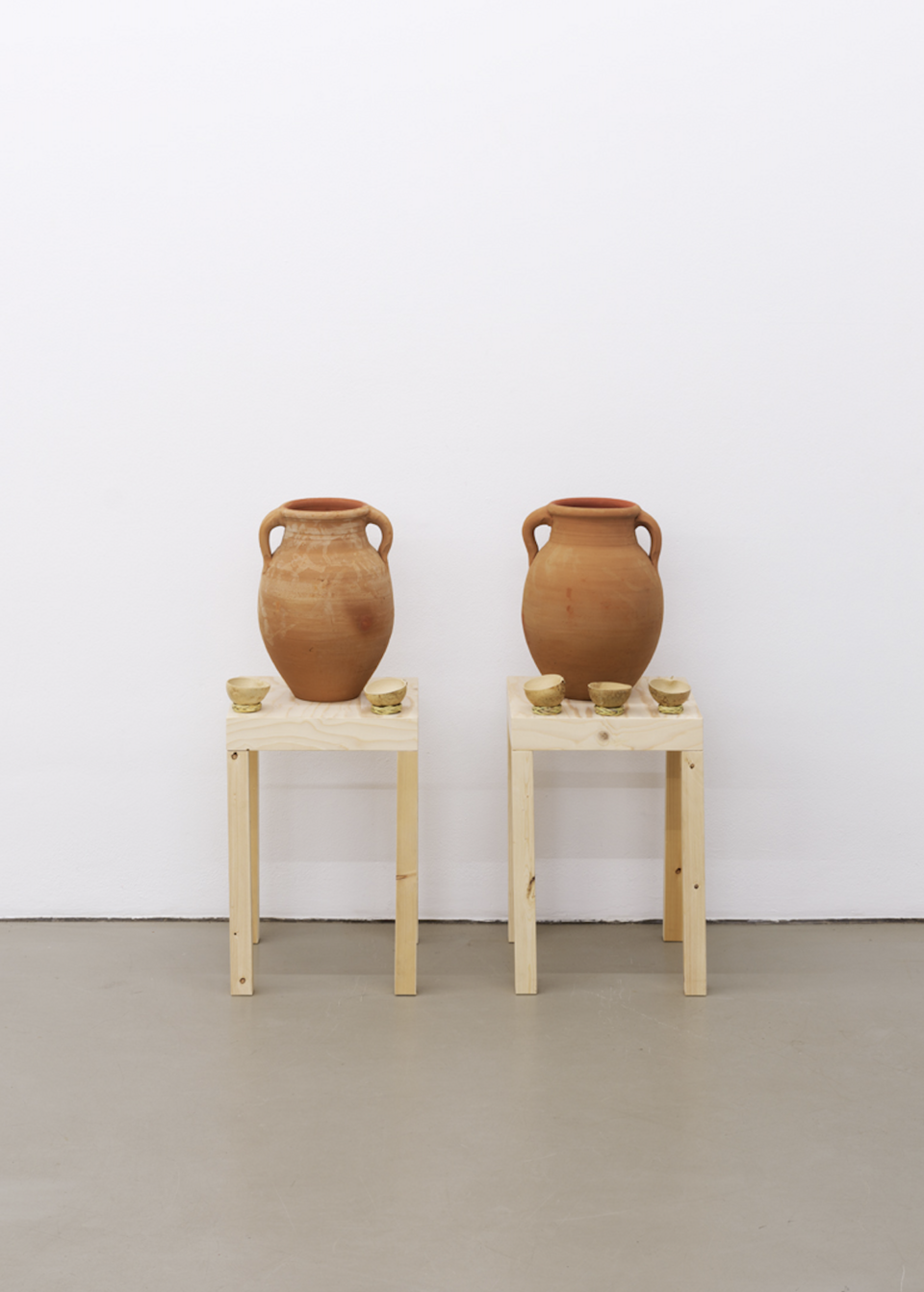
Ximena Garrido-Lecca, 'Inflorescence', Installation view, Portikus, Frankfurt am Main, 2023, photo: Max Creasy
The displaced temporality of nature and technology in capitalism also becomes clear in relation to the traditional use of corn in everyday life. Five thousand years ago, Mexico and Peru were the first countries and regions in which corn was domesticated. Since then, it has been deeply inscribed in the cultural history and culinary culture of both countries: Mexico, for example, is known for its corn tortillas, Peru for the nutritious cold drink chicha de jora, made from fermented corn. Aspects of these processes are materialized in Inflorescence through a millstone, or bowls, plates, vats, and jugs scattered throughout the floors. These utilitarian objects represent an ongoing practice of corn processing and incorporation as part of a present in which Latin American farmers are politically engaged in preserving their communities’ traditions, seed diversity, and the right to food sovereignty. Communal forms of organization, which have increased in recent decades, are resisting oppressive dynamics.

Ximena Garrido-Lecca, 'Inflorescence', Installation view, Portikus, Frankfurt am Main, 2023, photo: Max Creasy
Germany, on the other hand, cannot claim a tradition of maize cultivation. Only since the 1970s has corn been grown there on a large scale – mainly as a raw material, e.g., for animal feed, bioethanol, or glue. By detaching the corn from northern Hesse from precisely these processing methods for her sculptures, Garrido-Lecca links local and global aspects of the exhibition site, such as transport routes or seasonal conditions, and highlights the immense cultural and historical differences in the use of natural resources.
The geographical and temporal lens of Inflorescence helps navigate the postcolonial discourses surrounding corn. These include the question of territories and claims of ownership, but also the appropriation of cultural and culinary traditions built on corn as food. The artist’s arranging and staging of the plants and cobs is thus centered around the transhistorical and transcultural meaning of corn, which is largely ignored or not listened to in everyday life in Central Europe. This is one of the reasons why Garrido-Lecca equips the North Hessian corn plants with megaphones that acoustically occupy Portikus with a constant boom. As evidence of the millennia-old corn culture and its affiliation, a steady Morse code sparks a narrative from the Mexican Mayan culture into the exhibition space, stating that humans are descended from corn. But for the content to be identifiable as such, a key to understanding is needed, otherwise the morse content remains merely a background noise.
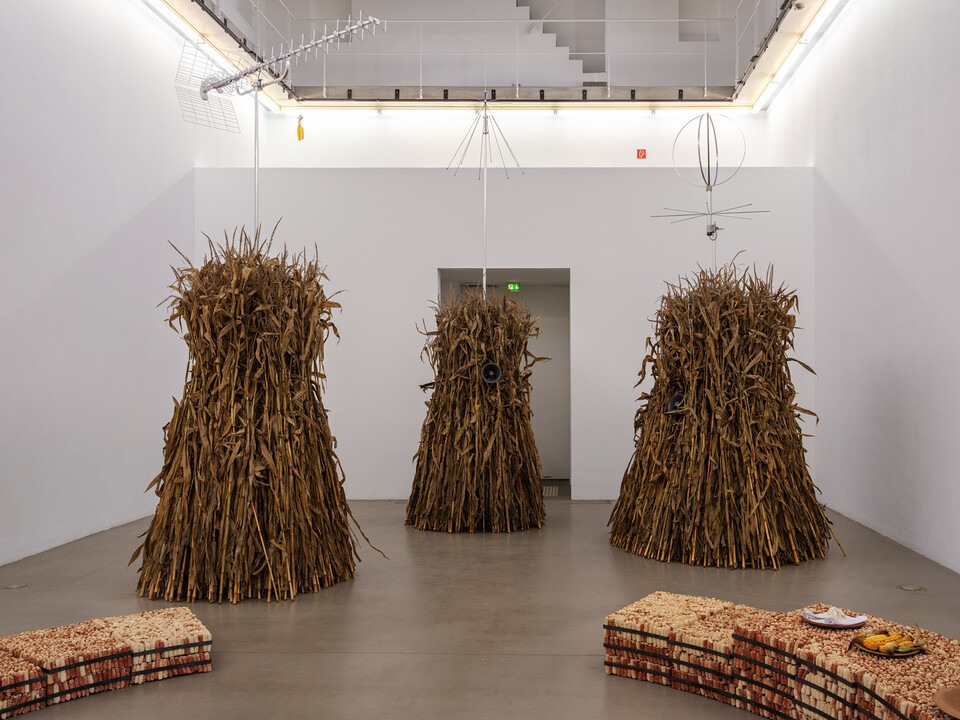
Ximena Garrido-Lecca, 'Inflorescence', Installation view, Portikus, Frankfurt am Main, 2023, photo: Max Creasy
Franciska Nowel Camino is an art historian and currently a research assistant and doctoral candidate at the HfBK Dresden. Her research focuses on the postcolonial reception history of Andean textile techniques. She studied art history, Romance languages and literature, and archaeology at the Goethe University Frankfurt am Main and worked in the Städel Museum’s Graphic and Digital Collection as well as at Frankfurt’ Curatorial Studies - Theory - History - Criticism program. Her texts have previously appeared in anthologies, exhibition catalogs, online magazines, and AKL.
Log Diversion
SEPTEMBER 22
A person and I were sitting at the wooden table downstairs when they asked me what’s happening in this room and I reply not intentionally repeating the question and also adding another one to see if they’ve read the newspaper or not I wanted to start the conversation asking what was their favorite part of it if there was one usually there is one but they reply I'm coming from my reading group my favorite activity they’ve said so I can't read anymore I'm blind I'm old but I will do it tomorrow or when I'm able to see again I'm going to rest my eyes the rest of the day so I went back to their question and walked with them to the water station they talked about seasons and I felt that’s all we talk about in the transition between one and the other but especially this one maybe in the north hemisphere after they have tried the river and said that in a warm day that could second them they will not doubt getting wet feet upstairs we said goodbye goodbye
SEPTEMBER 20
A boy came with a bag of chestnuts and asked if he can put one of them in the river and play with it. Later in the afternoon a friend came to visit the show with a chestnut too. It’s the season now. When the sun shines in during sunset, it leaves marks of shadow and light on the wall not seen in those summer months. Very soon this temporary river in Portikus will be gone, leaving stories behind like chestnuts falling from trees in autumn. - YX
SEPTEMBER 17
I was asked to make photos of the visitors three times today. It's such a simple and andom fact about today's shift but it made me think of how each time all of them were photographed with a different river in the background. Because it's flowing, it's everchanging, it's never the same water. - HL
SEPTEMBER 16
A river flow down each cheek of the visitors today because it‘s raining. The proud mother of a swimmer came to follow his tracks. Someone ask me what are the biggest flows of water I have seen? - HS
SEPTEMBER 13
The water stream has changed its colour today, wearing silver on its ripples. The blank skies and reflective waves, along with the bluish tree leaves are directing my mind to play out the Twin Peaks theme soundtrack in my head over and over, and I can’t help but listen to these synths as i stare at those trees. - RA
SEPTEMBER 11
Today is the 800th anniversary of Alte Brücke! Happy Birthday! - MG
SEPTEMBER 10
Portikus was a shelter for people when it rained. - ES
SEPTEMBER 9
Today Barbara visited us again - don't know exactly how many times she has already been to the exhibition but it was already the second time we saw and talked to each other: about Berlin and the Berlin Wall, how it was for her to grow up near the border of Germany, France and Switzerland, how as a kid she would go into the water whenever possible…And suddenly I've spotted a quirky playful smirk in her eyes - 'ich habe eine Idee!' . And the next moment she started folding the small paper she took out of her bag into a paper boat, doing it so quick and professionally as if she makes those every day. The boat's life was short but glorious. Barbara promised to come back with a toy boat next time. - HL
https://drive.google.com/file/d/12Mx2MxsZ5JK2MLioIAOiR-oV1aKdlto6/view?usp=sharing
SEPTEMBER 8
I dipped my toes into the water with a stranger. - ES
SEPTEMBER 7
Clouds took over the river today, leaving it greener in contrast. I had a nice conversation with a lady who stumbled upon the waters and decided to see it for herself. We spoke about swimming friendly bodies of water and I learned about an ancient one that still has the built stairs and traces of people back in the day. Added to my list of things to see in frankfurt. - RA
SEPTEMBER 6
The sun left its mark in the hall, forming a long line of squares on the floor. It was a bit distracting to look at. A couple of old men walked in, curious to look at the water and thrilled when finding out that they could walk in there. One of them transformed into a child the minute his feet touched the running stream. He said as he was leaving with excitement: it’s a blessing! - RA
SEPTEMBER 4
Today we had Martin Scheuermann from the company who printed the newspapers visit the show with his wife. E and I made an effort to show them around and make them feel welcome. They emphasized that they enjoyed the exhibition and the whole message it sends. First they were hesitant to get into the water, but they adjusted really fast and said how refreshing it felt. They also drank the water downstairs. He said to give a special thanks and compliments to C & L. - MG
SEPTEMBER 3
We found traces of the passing summer in the water. - YX
SEPTEMBER 1
Today the sun was a rare guest in the gallery. As if somebody adjusted the light settings and suddenly the world around has lost a bit of colour and saturation. It also does something to the water although it is transparent. I don't really believe calendars but looks like September likes to be punctual. - HL
AUGUST 30
A woman told me the story of how she grew up opposite the island where Portikus is, looking at the building that existed before it and wonder whether it was a church or a windmill or something else. Then she moved away from Frankfurt. And today she visited Portikus for the first time and tasted the river.
Now the wind brings in fallen leaves too. - YX
AUGUST 28
Since the festival is still going, there are a lot of visitors coming in and out. Our river is a place for them to relax and take a breath. - MG
AUGUST 27
The most common question I've heard today was 'What's going on here?' ('Und was ist denn hier los?'). Yeah, exactly - it's GOING (also running, streaming,changing, rushing, moving etc.) and it is already enough information about this artwork. This was the answer I had in the back of my mind but I never said it out loud. - HL
AUGUST 26
Everything is painted grey today, from the water of the Main to the floors of the Portikus. After yet another brutal heatwave last week it has finally cooled down, and the wind is whipping jitters into the river. Very likely also the reason less people feel the desire to step into the water. - NL
AUGUST 25
As one of the visitors was surprised by the temperature of the water (she didn't expect it to be so warm), I thought of how surprising it actually is - barely a week before September kicks in. In the pagan tradition (or at least in a Slavic version of it as I'm aware of), you're not recommended to enter any streams, rivers or lakes after August 2 because from this day on the waters are occupied by devilry and other dangerous creatures and the season of cold rainy weather starts. Seasons have changed greatly ever since and the waters can be cleansed by the human. Guess our ancestors would find it very safe but not as exciting anymore. - HL
AUGUST 24
A man with big green Aldi bag coming in with a calming smile. He looks like he is on his way to grocery shopping. Then he sat down by the river, closed his eyes, crossed his legs and started chanting. A quiet afternoon. - YX
AUGUST 23
Two friends entering the water together. After some minutes they hugged each other with their feet still in the water. - ES
AUGUST 21
The mystery foam is still appearing in the bucket. The mystery of foam remains the mystery after the two sunny non-even-close-to-rainy days. I would call this foam a 'cloud' - giving such a poetic name should eliminate the visual ugliness and disgusting smell this foam actually has. The foam of mystery is what I created in my head while looking at a pathetic smelly gathering of bubbles appearing as a result of intense waterfall. - HL
AUGUST 20
Today we had a couple visit us who were blind. I helped them find their way. Once they were in the water, H and I discussed how most art is not accessible for everybody. Here we had the chance to create an experience for them that went way beyond a visual reception. I am very thankful to be a part of this moment. – MG
AUGUST 19
A lady with a mysterious smile came in. Our conversation started with her asking the gender of the artist of the show ( she is the first person asking me the question). Then we began to talk about tenderness, theology and Rudolf Steiner (and many more). The water carries the story and goes on. - YX
AUGUST 18
I discovered that a pigeon has made a nest underneath the bridge, a butterfly flew through the front doors and then out again. I check the duck eggs in a nest on the island from the door in the basement. I’m now becoming more familiar with the small parts of nature which inhabit the island. – ES
AUGUST 11
did you ever see anyone washing clothes in this river? – NN
AUGUST 2
Towards the end of the day, just before our river was supposed to stop flowing, Francisco told me that someone had vandalized our toilet. At first I thought he was joking with me, referring to the Wallace Stevens poem affixed to one of the doors, but then he showed me a bright green sign in the other cabin. We tried to decipher it, but didn’t get far. Maybe someone didn’t want the river to stop flowing or wanted to challenge our water’s ability to remove graffiti. - CB
JULY 31
First shift data
Water level: 153 cm
Water temperature: 24,8 *C
Number of visitors: 231
- MG
JULY 30
The sky is completely clear today and hot air is filling the room. I saw a family come in with their child. They helped the child walk in the water, holding hands and laughing together. It was a very beautiful moment to witness. - MG
JULY 26
I sat close to the riverbed and got lost in the rushing of the water until I was told the apodictic sentence that this wasn't the real Main. I was a bit surprised and asked for the real one. We went to the window and he pointed to the water flowing around the Main Island. I asked more questions, interested to know what and where the real Main is. At one point I told him that I lived in Offenbach and that I liked sitting at the lock and that the surging water fascinated me. In doing so, the visitor began to sway, the artificial interruption of the Main undermined his view of the real Main. We were silent for a moment. I then sat down again by the riverbed - and the visitor sat down with me. - NF
JULY 24
The sun is really strong today. Being in the water feels even more refreshing than it usually does. I ended up talking to a visitor for an hour. Somehow the conversation transformed from the phobia of swimming in natural waters where the floor is hidden in the dark, to discussing cyber security and the impact of social media on our everyday lives. - MG
JULY 15
A woman told me today that there’s a waterwork in Schwanheim that also purifies the Main water and serves it to its guests. I wonder if they also show us step by step how they filter the water…
Anyway, there was a huge family visiting the exhibition today and RA and I had interesting conversations with them of course about rivers and bodies of water. They told us about a black river in Syria. - RH
A women came to me asking me about the stones that we use for mineralizing the water. It turned out she is a jewelry designer and has a lot to share about how stones bring different energy to the substance they are in contact with. I enjoyed this moment of exchange. - YX
JULY 9
Towards the end of the day a cloud gathered, and the air became close as if a storm was about to break, it turned cold. The water running through the space kept a warmth, which surprised visitors as much as it did me. - ES
A glimmering surface seduces when walking past Portikus on the bridge. Lot’s of visitors throughout the early hours of the day. Conversation flowed in many different directions, from aquatic monkeys to horses dragging pilgrims along the main. Today, our miniature Main felt like a ceremony, I don’t yet know of what. - AS
JULY 8
The thick weather pulled people in today. They came in waves, mostly in groups. I found myself having conversations almost constantly in water. The skin on our feet like raisins. Two smaller persons and I were playing wild in the water for quite a while. The water was the best they ever tasted, they said. Tasting mineraly, a characteristic taste, of it’s own, flowing through us at that moment. - AS
JULY 3
Today‘s information about the water:
Total hardness: 0ppm
Free Chlorine: 0ppm
Iron: 0ppm
Copper: 0,5-1ppm (above average level)
Lead: 0ppm
Nitrate: 0ppm
MPS: 0ppm
Total Chlorine: 0ppm
Fluoride: 0ppm
Cyanuric Acid: 0ppm
Ammonia Chloride: 100ppm (above average level)
Bromine: 0ppm
Total Alkalinity: 0ppm
Carbonate: 40-80ppm (below average level)
Ph: 7.2-8
RH
JULY 1
I had a conversation with a person that comes from Spain, Catalonia and lives near a river where you can drink the water since it’s so clean. I was several times in that region, close to a river called Muga where I could drink the water, too. We had a connecting moment while we both we‘re standing in the Main. - RH
JUNE 30
I learned about the de-humidifier today. We have to always keep it running and we’re emptying it in the mornings and evenings. The ventilators have to stay on too. The de-humidifier is preventing the walls in the gallery from getting moldy. When I imagined the mold on the white walls I had to think about how it would look if the walls had been layered with actual moss, with creeper plants and ivy. - RH
JUNE 29
Noticing the pipes shudder with the flow of water it directs. The pipes are as if they were the intestines of the show. A young child runs through the water. Later some visitors are curious about the engine, pumping the water up, so I take them outside to show them the heart of the work. They were in Frankfurt from LA. - ES
JUNE 28
Upon inviting a visitor into the water with me he quickly takes off his shoes, steps into the water and takes a deep breath while closing his eyes. - MG
JUNE 26
It's warm in Frankfurt, almost 30 degrees. The banks of the Main are well frequented. In the direction of Offenbach it gets quieter. If you take your time tomorrow, you will see the water changing its colors: A visitor drew my attention to the fact that the many colors a river takes on and can take on over the course of the day are rarely emphasized. The color changes with every minute, with every wave. I've been told that those who are susceptible don't need a treasure map. I'll sit down at the Main tomorrow. - NF
JUNE 25
The river pulled many people into space today. I only realise how the sound bounced all around throughout the day when I finally meet the silence at the end when closing. Outside the streets were littered with people which spilled into the space. The footfall was faster than the river. The air was warm, around 25 degrees, yet the gallery stayed fresh. For that freshness, I am grateful.
JUNE 24
Opening day. Heavy rains and thunder from 18.00 rounding up a hot and mostly grey day. 26 degrees most of the time. The low pressure making the water feel even warmer. Doors and windows open on both sides of the gallery creating a counter stream of air to the water flow. Successful event. - HS
JUNE 23
The fresh air around Portikus is stolen again, smells like rain with thunder but weather tricks us over and over. Our local tiny Main had a lot of visitors today, as soon as they put their feet into the water the gallery started to remind me moreand more of a children's playground. The buzzing sound of chatting and laughing backed with the sound of a water flow till midnight and some time after. - HL

Orange peels, drying in the Portikus garden
JUNE 22
It’s very nice today. I peeled oranges and lemons. My hands are still smelling like them. It felt very meditative to peel in stillness in the garden. The set is coming slowly to an end. I am excited for the opening. I was singing before with AS to lyrics that AR gave us. It felt very nice to sing. - RH
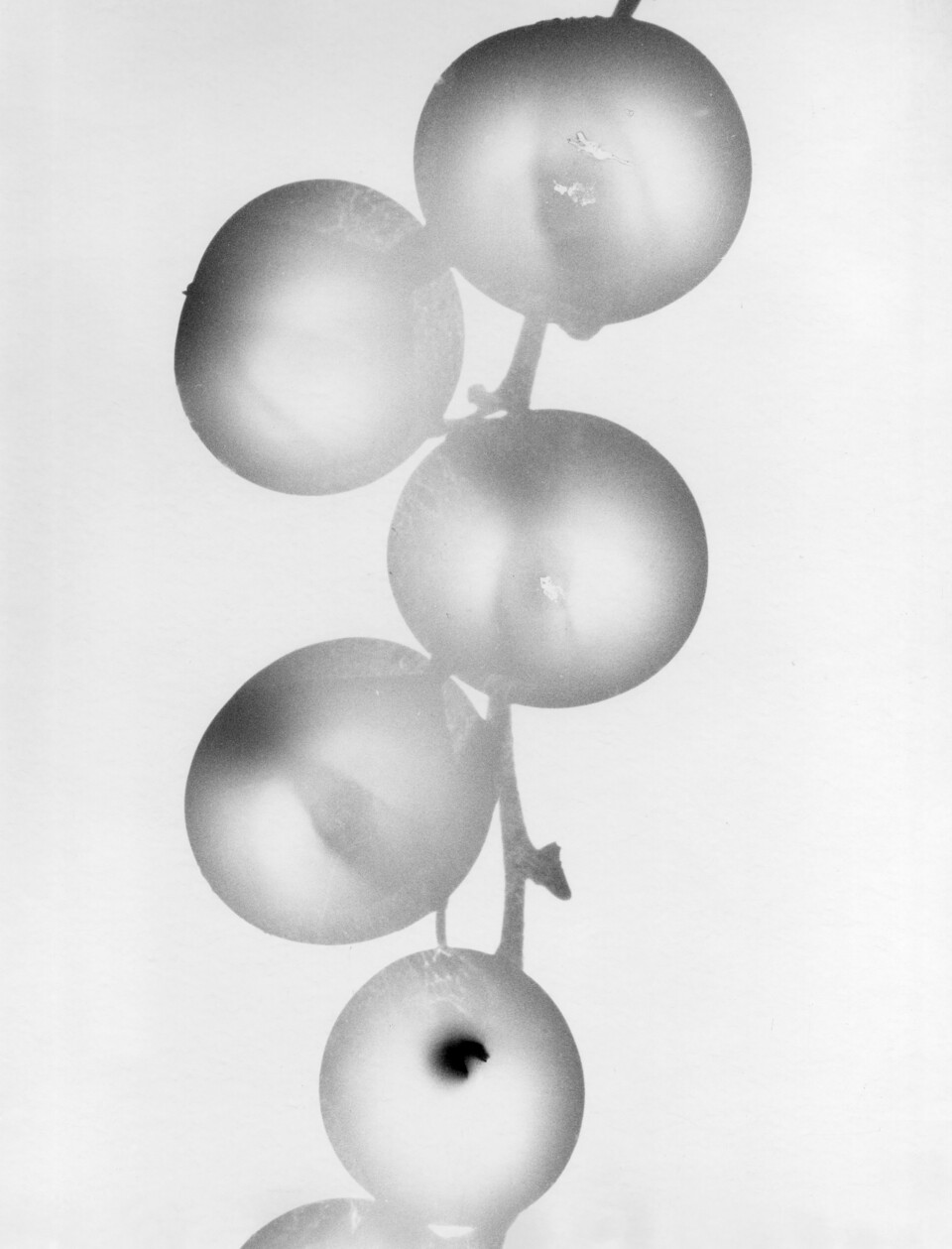
Jochen Lempert, Johannisbeeren, 2019, © Jochen Lempert/VG Bild-Kunst, Bonn 2022. Courtesy: BQ, Berlin, and ProjecteSD, Barcelona
No one is more thoughtless than a lemming, more deceitful than a cat, more slobbering than a dog in August, more smelly than a piglet, more hysterical than a horse, more idiotic than a moth, more slimy than a snail, more poisonous than a viper, less imaginative than an ant, and less musically creative than a nightingale. Simply put, we must love—or, if that is downright impossible, at least respect—these and other animals for what they are. 1
— Umberto Eco
Jochen Lempert’s photographs begin with an encounter, the occurence of his meeting with plants and animals, real or artificial representations in urban or rural settings, museum displays, scientific books or on the clothes of a passerby. Flora and fauna in his images appear to interact, tilting to address his camera, or behave completely indifferent to his presence. These images have earned Lempert recognition as an artist interested in the way the natural world becomes present to us. Once photographed, these seemingly unexceptional encounters of the everyday become magnificent bearers of revelations that range from portraying the mischievous nature of animals to the majestic shadows cast by sun-kissed foliage. There is an ease to Lempert’s images, a proximity that speaks to his comfort around the smallest of insects or frazzled of birds whom, in turn reward us with access to their existence. In his work, similarities between organisms, and celestial or terrestrial phenomena are looked upon with emotional intelligence and become the starting point for images that reveal the interconnectedness of nature. His interest in scientific disciplines, especially biology and animal behavior, translates into depictions of metaphorical, associative, and political acumen that allow us to look, almost intimately, at other species with whom we share life on this planet.
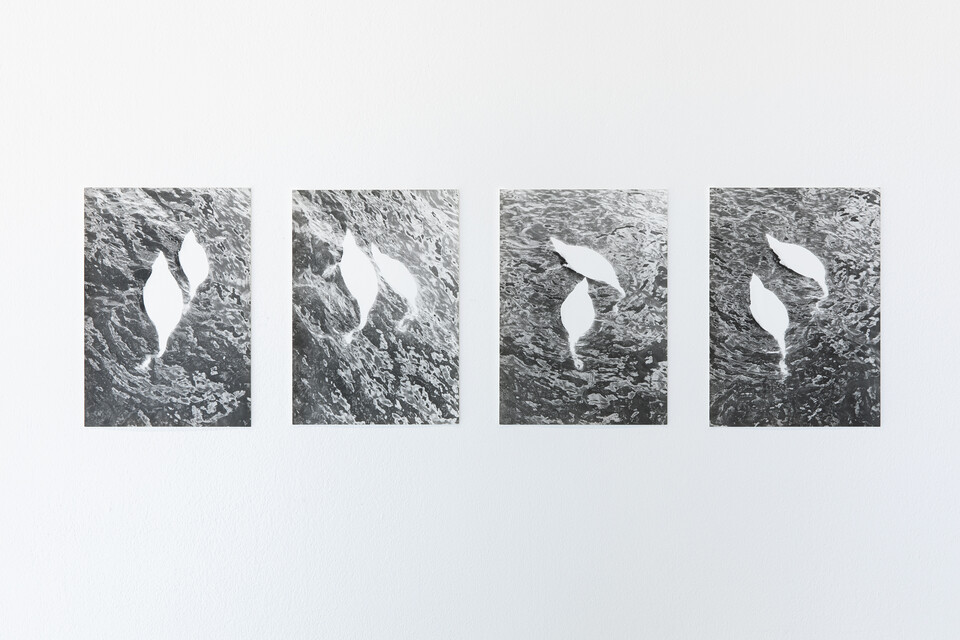
Jochen Lempert, installation view, Portikus, 2022, © Jochen Lempert/VG Bild-Kunst, Bonn 2022. Courtesy: BQ, Berlin, and ProjecteSD, Barcelona; photograph: Diana Pfammatter
For three decades now, Lempert has pursued with remarkable consistency and inventiveness the basic idea of only making images according to a principle of necessity. Although he is known for constantly carrying a camera in his coat pocket, for him the act of making an image only happens long after the initial click of the shutter. The bulk of his work does not originate from contact sheets, but rather he selects directly from negatives, often only using a third or less of the images in a roll. Through working prints, which he makes in A5 format or smaller, he shuffles and studies different variations before committing to a specific size, crop, or light. One consequence of this meticulous process of editing is how the act of seeing itself becomes the subject of the work and his method of display. Each of Lempert’s works is the sum of gradual decisions that lead to the appearance of an image. His photographs, primarily gelatin silver prints, are developed in analogous color schemes of gray on bright white matte Baryta paper that he handprints in his studio and when exhibited are left unframed and taped directly onto the wall or placed inside vitrines. Whether making an exhibition or a publication, Lempert prefers to seamlessly integrate older and newer pieces thus creating a body of work of close interdependence and one that is deliberately anachronistic and where decisions on pairings and grouping are interposed and reformulated by a relational drive. This associative approach to the work of art is similarly evoked in the titles of his works, favoring single nouns or descriptive sentences that aim to spare the viewer of unnecessary distractions and ground the image experience, in the artist’s own words, to what one “strongly feels in the moment of seeing.”2
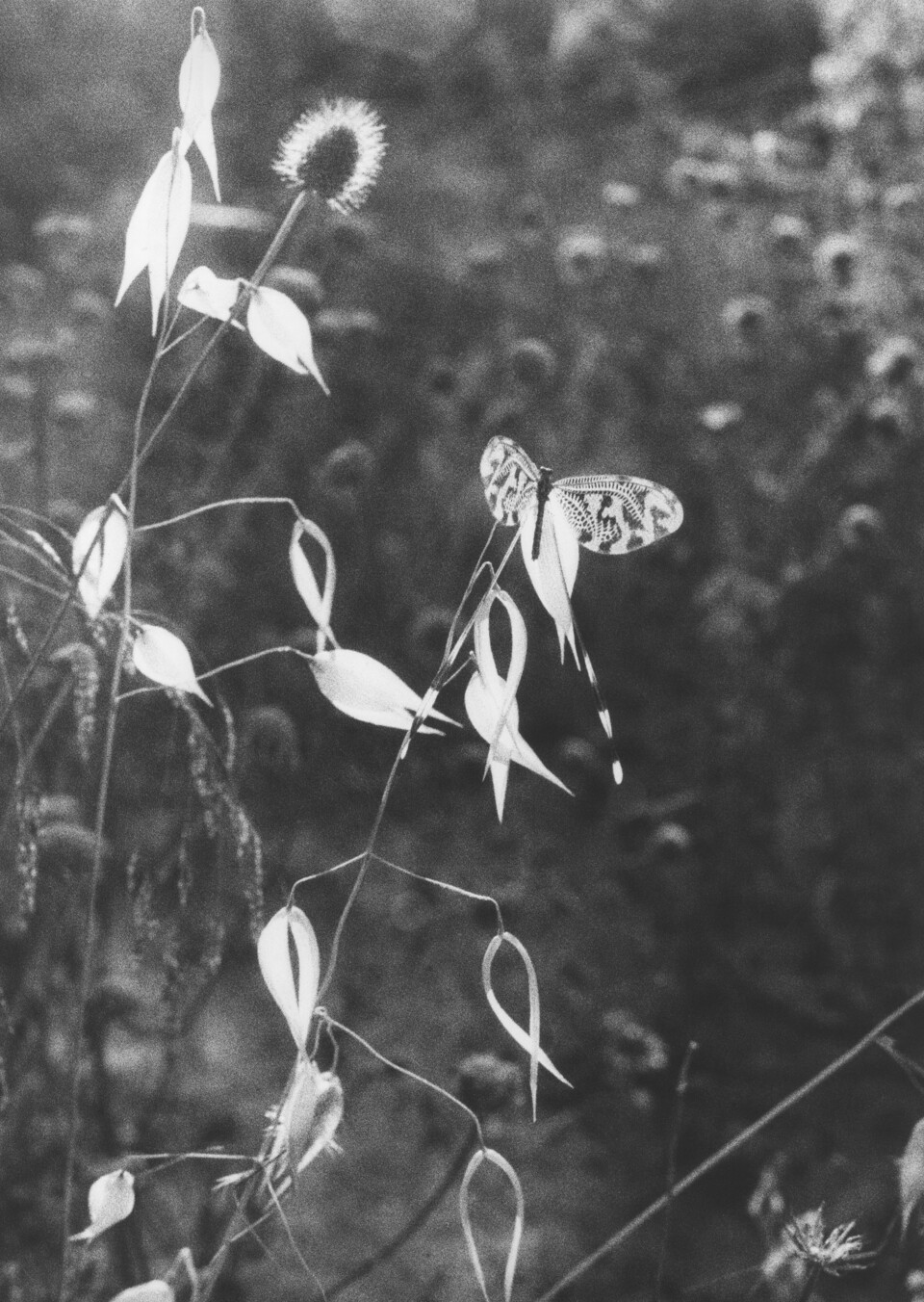
Jochen Lempert, Schmetterlingshafte, 2019, © Jochen Lempert/VG Bild-Kunst, Bonn 2022. Courtesy: BQ, Berlin and ProjecteSD, Barcelona
In the playing field of contemporary art, Lempert is a blessed outsider. He began exhibiting his work in Cologne and Hamburg in the early 1990s, and except for the occasional thematic group exhibition, it has circulated primarily in the quartier of photography although regarded at times with suspicion given his unconventional use of the medium. Lempert´s simultaneous embrace of different photographic procedures from instantaneousness to mise en scène, which he reconciles through the recurrent use of multiples in sequential order, allowing the work to withdraw from usual categorizations. Another curiosity surrounding the public reception of Lempert’s practice, and particularly his use of the 35mm camera, has been a recurring reference to the artist’s scientific credentials. His name is typically accompanied by titles bestowing him an additional level of exceptionalism: biologist, odonatologist, entomologist, or ornithologist. Although it is no secret that from time to time he has authored scientific reports, how remote these studies are from his work is confirmed by their total absence in his displays and monographs. That such classifications should be of concern for the artist is rather unlikely. Lempert is not much interested in demonstratable facts, nor is his working process ruled by fixed structures or theories, but rather an open system where, as he observed, “searching is a big part of the whole project” and where unlimited outcomes are plausible every step of the way. 3 In his photographic work, Lempert is actively silent regarding the natural sciences. Rather than applying his scientific knowledge to what he photographs, he visually invites meaning through the act of seeing−the act of seeing what is depicted and what awaits to become visible.
Another striking aspect of Lempert’s practice is his studio or rather the walls in it, which exhibit a vast number of tiny cavities from the thumbtacks he uses to pinup working prints. Trailing on various directions, the marks show decades of his looking en route to finding an image. The placement of the prints on the wall alternates between single photographs, symmetrical groupings where prints of the same size are paired into duets, quartets or two-tier grids spaced only a few centimeters apart, or they are arranged as asymmetrical pairings where different scale prints are placed in dialogue but kept at arm’s length distance from one another. The various combinations and configurations enacted in the studio influence the improvisations played out on the walls of the exhibition space. But this is only one aspect of his quest, another crucial part of the process happens inside the darkroom prior to the arrival of a print to the wall. The artist has explained it this way: “It is actually always about seeing something from the photo or seeing something in the photo. Sometimes you need several pictures to make something come together. And sometimes only one is enough.” 4
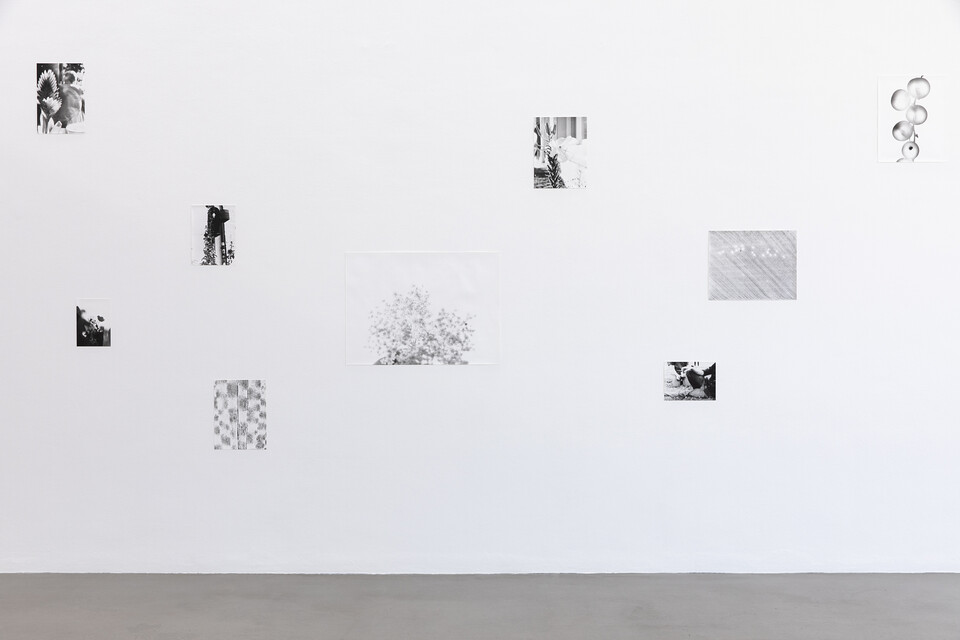
Jochen Lempert, installation view, Portikus, 2022, © Jochen Lempert/VG Bild-Kunst, Bonn 2022. Courtesy: BQ, Berlin, and ProjecteSD, Barcelona; photograph: Diana Pfammatter
If the wall is a stage where Lempert conducts rehearsals, the small cardboard boxes overflowing with test prints sitting on the shelves are the casting auditions. Hundreds of prints the size of index cards are grouped into collections, classified by single words in German handwritten hastily on sheets of paper that read, for example: H2O, horses, only bees, pigeons, plants, skies, wind. Others have more metaphorical categories alluding to specific constructs such as: picture logic, symmetry, senses, and Gestalt. Lempert’s working print collection functions as more than a simple repository; it has become a lexicon that he employs, borrows from, and modifies to generate what he calls “constellations”−a mode of display where the sequence of works establishes a dialogue on a wall or through an entire room. If the preliminary working prints provide him with answers on which image should be kept, the resulting groupings expand on his construction of meaning through juxtapositions and comparisons. Lempert proceeds intuitively through hypothetical placements and differentiates images according to no preconceived plan. Hence, all scenarios are provisional, out of chronology and subject to the fast surprise of an appearance. Although there are pairings that emerge through his use of improvisations, every installation he makes of his work is site-specific, that is, staged on-the-spot and poised to generate understanding precisely in the fleeting and interchangeable meanings that reside permanently in the present.
At the heart of Lempert’s work is a radical ecology that is characterized by a practice of mind, hands, and eyes. Through the use of images, where the world is not a place to be captured but a terrain of correspondence, he makes visible encounters with nature and nonhuman beings where transmission and coexistence occurs. Lempert’s approach to the natural world while fearlessly up close to it is cordial and respectful, but above all, empathic. His images deliver lessons not on what to look at but on how to see and consider the species with whom we coexist with on this planet. Likewise, his interaction with the surroundings is replicated by his search for relationships. For Lempert, photography does not necessarily replace the experience of the natural world as nature in absentia but visualizes it as presence. Our perception converges with Lempert’s intimate proximity to his subjects when we join him in the affirmation of the dignity of all living beings. His overlapping interests in art and science converge in his work not as depictions separated from the world that we inhabit but rather belonging to it, thus rendering photography as foliage of the human experience.
In the framework of his exhibition Pierre Verger in Suriname Willem de Rooij invites the artists Razia Barsatie, Ansuya Blom, Ruben Cabenda, and Xavier Robles de Medina to show their works on the Portikus website. With the program Flux und Reflux – A Selection of Moving Images Portikus' audience is introduced to moving image made by four contemporary artists who have a relationship to Suriname. The video works will be online for two week at a time:
24.06.–07.07.2021
Ansuya Blom, SPELL, 2012, 6'38
SPELL is a short film documenting the thoughts of a man in a state of unreality. Sounds invade his thoughts, get amplified and mix with associations from his past. In this in-between world he tries to regain his grip, contemplating early beginnings and simultaneously mocking his own state of being, the futility of action and the rituals of daily existence.
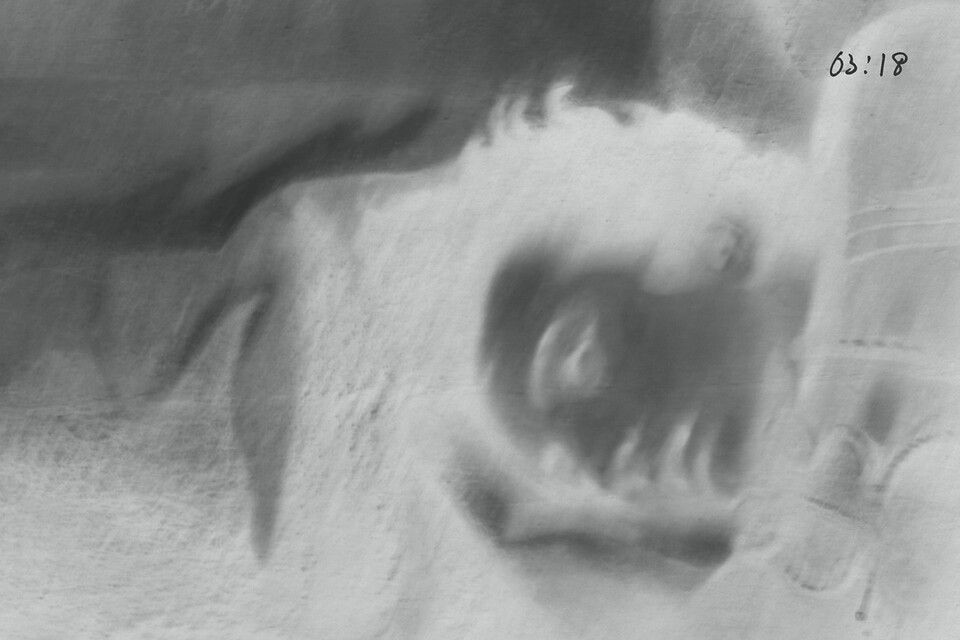
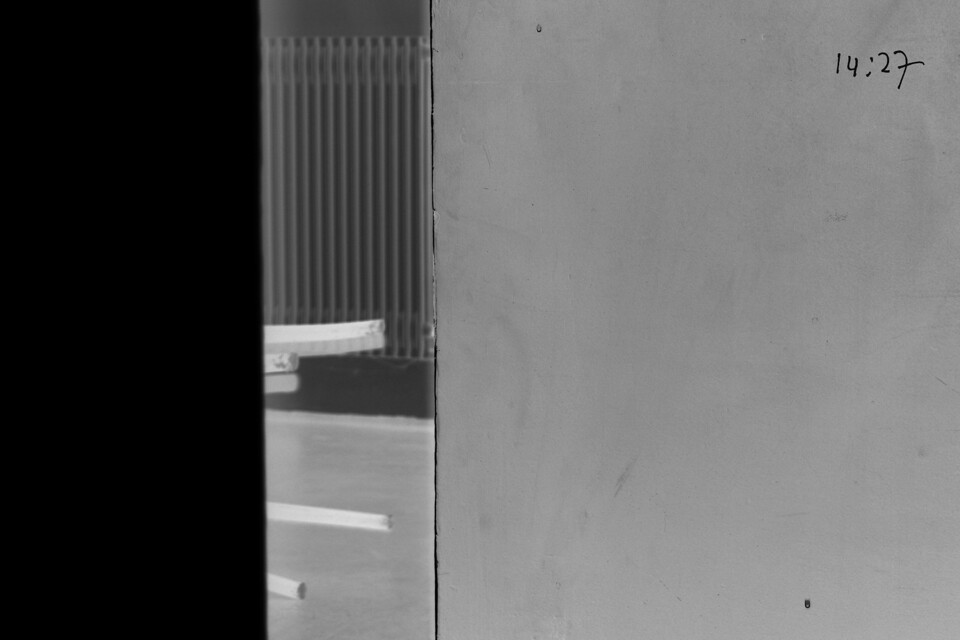
The images for this film were photographed in the house of Theo Van Doesburg in Meudon, France during a residency in 2010 - 2011. The words of Franz Kafka speak for themselves and it was their strange mix of humour and despair that attracted me. (Ansuya Blom)

Ansuya Blom (*1956 in Groningen) lives and works in Amsterdam. She studied at the Royal Academy of Art in The Hague and Ateliers '63 in Haarlem. Blom has been working in various art forms, including drawing, painting, photography, film, text, collage and sculpture, since the late seventies. In 1981 she received the Dutch Royal Award for Modern Painting. Her films have been screened at the International Film Festival Rotterdam, Rencontres Internationales Paris-Berlin, IDFA Amsterdam and at the Museum of Modern Art, New York. Her work can be found in the collections of museums, including the EYE Filmmuseum, Tate Modern, Stedelijk Museum and the Museum Boijmans Van Beuningen. Solo exhibitions include Camden Arts Centre in London, Douglas Hyde Gallery in Dublin, Stedelijk Museum in Amsterdam and Casco Art Institute in Utrecht. In 2020 she was awarded the Dr. A.H. Heineken Price for Art.
Blom also holds a master's degree in psychoanalysis from Middlesex University in London and is an associate member of the Centre for Freudian Analysis and Research in London. She is an advisor at the Rijksakademie in Amsterdam and was a guest advisor at art institutions in the United Kingdom, South Korea, Surinam and Indonesia in 2019. She has given public lectures and interviews most recently at the Nola Hatterman Art Academy in Surinam, EYE Film Museum, Casco Art Institute and De Appel.
Upcoming artists in this series:
01.07.–15.07.2021
Razia Barsatie
In the framework of his exhibition Pierre Verger in Suriname Willem de Rooij invites the artists Razia Barsatie, Ansuya Blom, Ruben Cabenda, and Xavier Robles de Medina to show their works on the Portikus website. With the program Flux und Reflux – A Selection of Moving Images Portikus' audience is introduced to moving image made by four contemporary artists who have a relationship to Suriname. Die Videoarbeiten werden jeweils für zwei Wochen online verfügbar sein:
10.06.–24.06.2021
Xavier Robles de Medina
Ai Sranang, 2017
Music: Lieve Hugo, "Oeng Booi" and "Blaka Rosoe"
According to the Transnational Decolonial Institute, decoloniality endorses interculturality, “the celebration by border dwellers of being together in and beyond the border.”
Ambivalence is the true sentiment of the “diaspora”—as much as we hate to admit it, we love the feeling of being recognized, not as celebrities but as part of a “lineage,” as extended family. Jill Casid writes that “while, since the nineteenth century, diaspora has been used to refer specifically to the dispersion of a people, imagined as a tribe or family unit, diaspora also signifies the scattering of seed.”
Stuart Hall has also interrogated the term noting its meaning is rooted in colonially constructed binaries, of the “original” and the “copy,” and of “inside” and “outside.” It’s telling that our national flower, the Fajalobi, is only a recent transplant from India.
(Extracts from Xavier Robles de Medina's essay “Preface”)
Ai Sranang is a short montage film that examines Surinamese history and politics since its independence from the Netherlands in 1975. Through its fragmentation, the montage alludes to the complexities of diaspora as it stands in relation to identity. The tropes of in-between-ness and travel are an extension of this metaphor, yet they recall also ideas of leadership and government. The image of a “swinger” bus completely running amuck by a reckless driver extends its metaphoric space beyond the Surinamese context to the events that have defined a more global neoliberal era. Robles de Medina has been building an extensive collection of found images that is central to his artistic practice as he appropriates, edits, re-contextualizes and transforms them.
Xavier Robles de Medina (*1990 in Paramaribo) is a visual artist based in Berlin. He graduated from Goldsmiths, University of London. In 2015 he was nominated for the Prix de Rome Visual Arts in the Netherlands, and was shortlisted for the Dutch Royal Award for Modern Painting. Recent solo exhibitions include SCAD Museum of Art, Savannah, Another Mobile Gallery in Bucharest, Praz-Delavallade, Los Angeles and Paris, Readytex Art Gallery in Paramaribo and Catinca Tabacaru Gallery, New York. Robles de Medina has been selected to participate in Senegal's fourteenth Dakar Biennale in 2022.
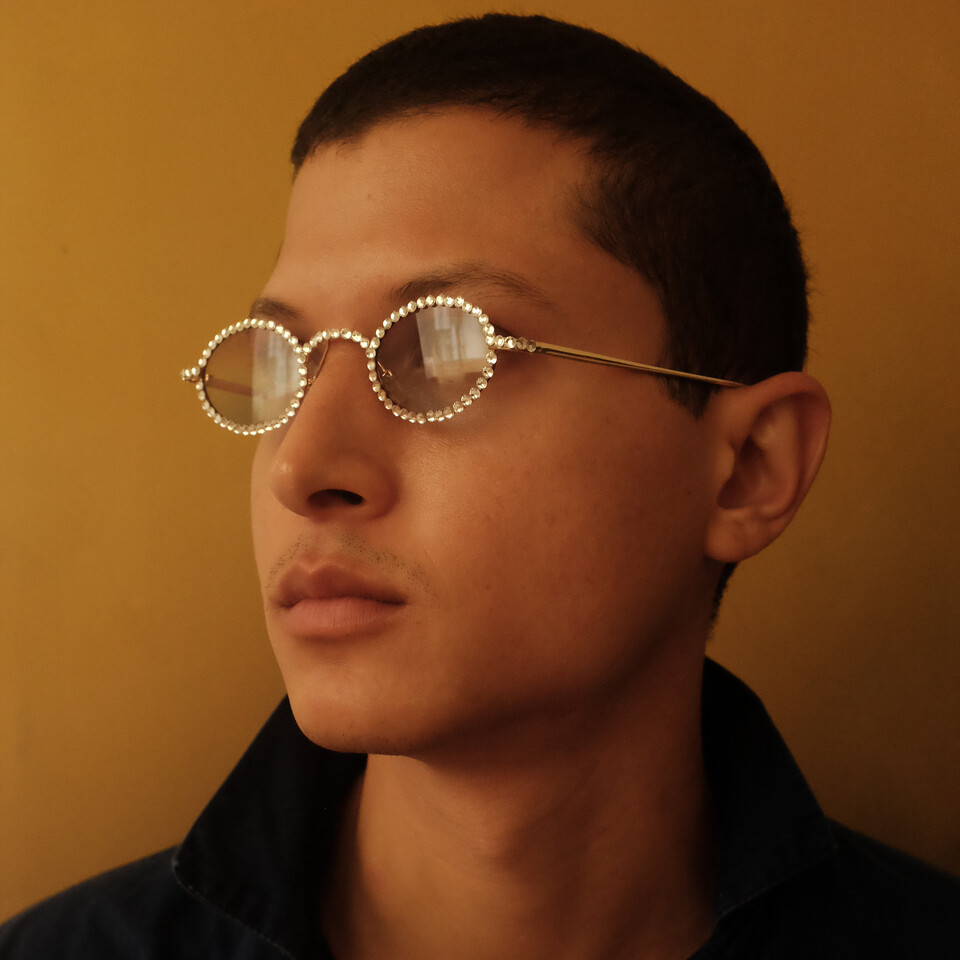
Portrait image: Sascia Reibel
Website: http://xavierroblesdemedina.com
Upcoming artists in this series:
17.06.–01.07.2021
Ruben Cabenda
24.06.–08.07.2021
Ansuya Blom
01.07.–15.07.2021
Razia Barsatie
For Cashmere Radio, Hajra Waheed spoke with Reece Cox about her work Hum, which was present in her solo exhibition at Portikus from 11.07. bis 06.09.2020.
This episode of INFO Unltd takes a deep dive into HUM, a recent sound work by artist Hajra Waheed. Exploring histories of sonic resistance across South and West Asia and North Africa over the last half-century, HUM reveals moments when sound and voice have united oppressed peoples and movements across geographies and generations.
Listen to Hajra Waheed on HUM and Abolitionist Modes of Listening
On the occasion of Arin Rungjang's exhibition Bengawan Solo at Portikus, Paula Kommoss speaks with the artist about the genesis of the work and the meaning of the river Bengawan Solo.
PK: What really interests me, first of all, is how did you come to find the singer for your work Bengawan Solo?
AR: A while ago, I was in Yogyakarta [in Indonesia] and had started to do research on Diponegoro, the priest to the Sultan of Yogya who is depicted in a painting by Raden Saleh. Raden Saleh was an Indonesian painter who fled from the country because of political aggression between the Dutch administration and indigenous Indonesian monarchy during the mid-19thcentury. Saleh went on to study Western painting, and his style was inspired by Delacroix, for example, which you can see in his compositions, use of lighting and so on.
Of course, all of this has been studied, and here I was wandering around in all this history about Yogyakarta and Indonesia in general, and I was also looking at the Chinese communist movement in Indonesia and so on. So, I had done all this research, and then I kept thinking about my relationship to Indonesia in general, which is always my starting point to making work. But I couldn’t find a very real connection to this material, except with the song ‘Bengawan Solo’, which I began to see would be my point of departure.
The first time I heard ‘Bengawan Solo’, I thought it was a Chinese song because I didn’t realise it hadn’t been written by the Chinese woman who sang it in 1960s. In a sense I had taken the Indonesian away in my mind. The song was really important personally because it was connected to a time in which I was questioning my sexuality, I was gay, I was not that gay, I didn't know what I was. I fell in love with a guy because of this song – it was a very romantic period for me.
I had the song in my mind for a very, very long time – stored in some part of my brain and my memory and then, even before I came to Indonesia, I discovered that the song was not by the Chinese woman after all, but that it was an Indonesian guy who wrote it in the 1940s, when he was only 19 years old. He had quit school and was working in a Kroncong band, the traditional Indonesian band that you can see in the video. And so, he created ‘Bengawan Solo’, which became incredibly popular. When Indonesia came under Japanese occupation [during the second World War], two years later, the song spread throughout Japan. There was a Dutch woman who was born in Indonesia but grew up in a Japanese internment camp, and she knew the song because it was played by the Japanese. It became stuck in her memory too, and so she sung a version of it as a teenager in the 1960s, which became really popular in Singapore and in other parts of Asia. So that was the song, and all these stories that are part of it became part of my knowledge, too.
I then got to know Rochelle – who sings this version of ‘Bengawan Solo’ – through a mutual friend. At that time, I was looking for someone who could imbue the song with more meaning beyond my own personal memories, and to share the song and its resonance with that person. So, my friend introduced me to Rochelle, a singer in a Kroncong band. Before we met, I didn’t know that Rochelle was the daughter of Lendra, a very important poet, or that her mother was a Princess, one of the daughters of the Sultan of Yogya. I was just looking for a singer who could deliver this song and share in its meanings. We met and got to know each other, and I learnt about her personal memories and history and so on, and it was so great – that there was this connection that I didn’t expect to find. I mean, I guess because things are always in circulation, things are always just there, even if it’s happening through different times. And so, the work is also about these layers of histories and memories and what we couldn’t foresee.
Actually, I didn’t need to put all that information onto the table in the show, it was just a way to display my research. For me, it’s enough to look at Rochelle singing that song and think of all these things that were happening before, before the song became so evocative for me. Like the Chinese using the river as a way to transport dead bodies during the Communist regime, and also Mushagra, Diponegoro, Raden Saleh’s painting, and all of these narratives that were in circulation through history, through art, and through memories – that’s what I think is so rich and thought-provoking.
PK: And the great thing is that all of these stories are brought together through the song ‘Bengawan Solo’, which tells the story of the legendary Solo River in Java, the island’s longest, in a really poetic way. The river is both the song’s main narrative, flowing from mountains to the sea, but also its title. So, on the one hand the lyrics lay out this seemingly simple story, but on the other, there are all these layers of narratives that you have just described: that the song comes historical connotations of the Japanese occupation, and something you mentioned earlier, that during the Communist regime, the bodies of those murdered by the state were washed by the same river. These stories are often violent but the song is beautiful, and whether you speak the language, or you don’t, a song is always a way to reach out to people.
AR: Yes, and so much spirit…
PK: …and to trigger emotion in a way.
AR: Yes, and once the work was done and shown, it was not just about me and Rochelle anymore. Like my story might be a silly one to share with the song but Rochelle’s is really rich, and also, I like to think about those people who might say “I remember this song”, and can share their own memories as well. I like what you just said about even someone who had never heard the song before, being able to access it through the narrative. So, it means that it is not just the song that evokes emotion and opens people’s hearts and feelings...
PK: Yes, and also because the song plays in a loop throughout the work, you sit there and you start reading the story as it unfolds, but the music keeps repeating over and over. As a viewer, you add all these layers on top of the music; it’s a nice way to make the song richer for everybody. And actually, I heard the song for the first time in the film In The Mood of Love (2000) but of course I didn't know anything about it then.
AR: I have used two versions of the song in my work – the version from In the Mood for Loveand the version that speaks to my experience as a gay man, which is the original recording of ‘Bengawan Solo’. Actually, [in that film] they made it into a love song. I think the film is very poignant, every time I watch it, it always gives me tears because it’s such a symbol really, about the people who lived there peacefully, and then it becomes kind of actively related with other knowledge – a cruelty of the world and colonization and so on. The land has been there for thousands and thousands of years, and on it people live and die, live and die, live and die, and they leave traces of their memories in the land and for me it’s beautiful.
PK: Yes, I think so too, and you are opening up with this really personal story, which in a way makes you vulnerable. And this is a starting point that I appreciate a lot, explaining how you discovered that you’re gay and so on, and how you become conscious of this through the romance that this song embodies for you, which adds such an emotional layer to it.
AR: And that works because I made the work specifically for Indonesia, and because if you’re gay in a Muslim country, it is very difficult, and I had a very difficult life. To share the work as an Indonesian gay Muslim was to give those feelings space, and I wanted to show the audience that they could maybe share in this level of intimacy between myself as an artist and them as the audience, through the song.
PK: You’re making it possible to expand this song, which is from Indonesia and everybody there will have their own personal connotations of it. But through opening it up and to align it with love as well is expanding the context of the song once more.
AR: It’s not only about being gay as well, I mean love as it is for all human beings…
PK: And acceptance, in a way.
AR: Like when Rochelle talks about Gusta – “Gusta is the almighty”, and Gusta doesn’t have gender – Gusta could be anything.
PK: Especially when Rochelle talks about her father, and how when he got older his ego wasn’t in the way anymore. I found that really interesting, because one could argue that when people are strongly against something, or stuck in their ways, it’s mostly because their pride is in their way. Whereas in your work ‘Bengawan Solo’, there are two narratives woven into each other and also visually, you’re surrounded by a kind of orchestra – as a viewer you feel as if you are almost facing a community.
AR: Yeah, it’s not a movie – I mean, it works in the way that we are using this type of virtual immersion to convince people, so it’s like the narrative is going on inside someone’s head.
PK: Yes, and I’m happy we get to see it here in Frankfurt. Songs are good tools to get people’s attention.
AR: It’s really that simple, yes? Because I have been working with moving image for many years and it was always different from recreating an event as a film, because it’s about how to transform it – because I always think that nothing can replace reality, and once the moment has passed and you want to go back to it, it will already have layers that weren’t there before. But I have been thinking about how to make such a recreation into something more transparent, and so for me music is about representing reality in a different way. In one sense, music is just music, but as with this song – it was created in 1940s and already had all these historical resonances, and so all these years later it is not just about the original song itself but all the layers of the spheres that the song has passed through. I think that’s enough – Bengawan Solo has its own content and to allow this content to appear in the current contemporary moment, I think this is really important.
PK: What I also like, is when you first sit down in front of the work, in a way you just read the texts. Yes, you encounter these different musicians and the singer, but for me it was kind of like going on a story ride, you know? Because as you describe the river and what happened, it’s like this storytelling moment that transforms the viewer into a child that listens and soaks everything up and from there you go on throughout the work. And somehow the story isn’t closed, which is really nice.
AR: Yeah. That’s great. I’m planning to do a new work in Berlin next year and I hope to add some other pieces.
PK: That sounds really interesting.
AR: And you know, I wasn’t quite sure about my way of making work. I mean, as a person growing up in Thailand, in that region the majority of our knowledge is not that strong, so to speak, it’s not that constructed like in Western countries. I liked conceptual work when I was young, I found it really thoughtful, but I mean we weren’t really into nature. And also, in our culture we never separate body and soul, body and spirit. A person is never separate from God. It was almost like Joseph Beuys but it was not this constructed idea. It was just in the nature of the people who lived there. It’s both a bad thing and a good thing. The bad thing was people prayed to the tree for good luck and so many outside people said that this is so Barbarian or something, but still others have attached themselves to nature, and for them they will never separate themselves from the earth, from the trees, from the river. Deep down they believe that one day they will go back to the river, to the earth, to the trees again and I have never disregarded this. I think this is how we communicate with things and a vantage point I could appreciate. I mean, not just to treat reality as a source material to reproduce in art.
PK: That adds another dimension to the river in your work, because the river is symbolic of an eternity, but I think besides it being, you know, old-fashioned to prey to a tree, it still shows a kind of respect for nature and its power when you’re surrounded by it.
AR: There’s also one poem by an Indonesian poet, which is about a person that wants to walk across the river and he is hesitating because he sees his relative’s spirit fill up that water and he cannot step into the river because of his ancestor.
PK: There is so much additional information for your work.
AR: Because the process is so complex, all the information, research, and so on. My work that was at documenta 14 246247596248914102516 … And then there were none(2017) too – that one was super rich too, so much information – this, this, this – we have tons of information…
From time immemorial, one of humankind’s most important missions has been to preserve knowledge. We do so not only by passing on oral traditions to subsequent generations, but above all with memory institutions. This collective term unites all those institutions whose goal is to preserve and convey knowledge. While libraries and archives may come to mind first, they also include museums. They are places that administer bits of contemporary evidence and seek to protect what constitutes the identity of a society: its cultural heritage.
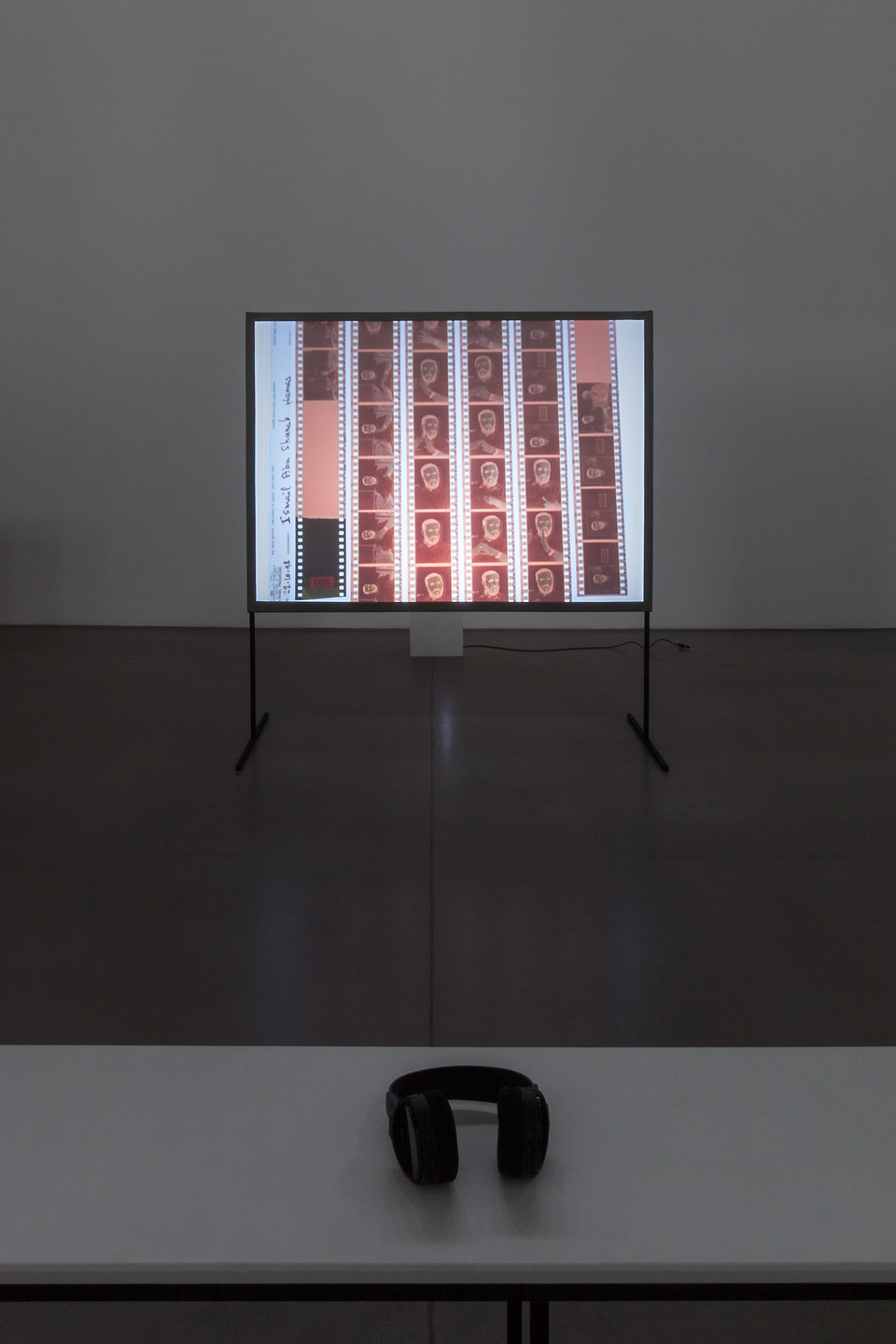
Sirah Foighel Brutman & Eitan Efrat, Printed Matter, Installation view, Slide show, 29.04.–11.06.2017, Portikus. Photo: Helena Schlichting.
All of these institutions do their part to ensure that we do not forget. Indeed, they function as a collective memory. But like personal, individual memories, there are events that we like to think back on in pride as well as unpleasant events that we tend to forget. Psychoanalysis refers to this process as repression. While the ordinary act of forgetting unconsciously stores irrelevant information in favor of the more important, with repression content is deliberately excluded from memory in order to avoid unpleasant emotions. Repression is thus a natural self-defense mechanism. But what happens when memory institutions also make use of this strategy? When those institutions in particular repress inconvenient truths that nevertheless are regarded as the guarantor of truth per se?
Michel Foucault robbed the archive of its innocence in the late 1960s. He pointed out that this place does not collect truths, but constructs them. Under the guise of objectivity, facts are first produced in such a way that each archived document implies a multitude of others that have not been included in the selection.1 If institutions such as archives and museums serve to administer both history and the present, we must be made aware that power structures within these institutions are ultimately responsible for which contents are rated as valuable and which are pushed into the cultural subconscious. Hence, cultural memory is no more than a canon.
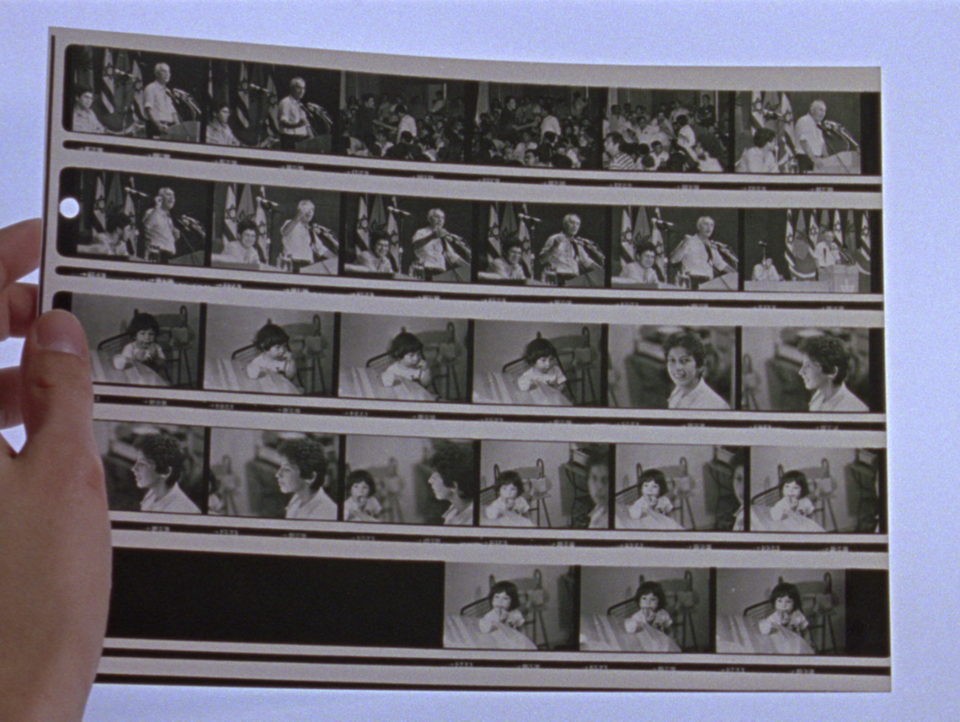
Sirah Foighel Brutman & Eitan Efrat, Printed Matter (Still), 2011.
Those who are inscribed in this canon will not be forgotten. They are remembered. Just as Hanne Foighel remembers her partner André Brutmann. In the video Printed Matter (2011) by Sirah Foighel Brutmann and Eitan Efrat, contact prints are placed on a light box while a friendly female voice comments on the negatives. The images belong to the artist’s father, the voice is that of her mother. Until his death in 2002, André Brutmann was a sought-after press photographer who followed the Israel-Palestine conflict in particular for decades with his camera. Yet the contact prints show not only pictures of abandoned cities and rebellions, but also pictures of his family. Brutmann’s archive is not just that of a photographer, but also of a father. The same rolls of film contain images of heads of state, funerals and children’s birthday parties. While the artist’s mother gets nostalgic when looking at the family photos – commenting on pictures of herself in a bathing suit by laughing, “this doesn’t belong here at all” – her voice often drops when she sees the photographs that Brutmann shot for the public.
Uneasiness accompanies these photographs. The memory of these moments produces silence. The manner in which Foighel talks about the pictures seems not only to provide information about the past, but also about the present. The memories of the political conflicts in the 1990s seem to dissolve mostly in silence because today there is still no solution for them in sight. Rather, the photographs seem to be a historical narrative of our present in that they remind the viewer of conflicts whose traces are still visible today.
“The photograph does not necessarily say what is no longer, but only and for certain what has been. This distinction is decisive. In front of a photograph, our consciousness does not necessarily take the nostalgic path of memory (...), [but] the path of certainty: the photograph’s essence is to ratify what it represents.” 2 In photography, Roland Barthes sees only the image of a present that has already occurred, which can say nothing about a before or an after. In the same way, Sirah Foighel Brutmann and Eitan Efrat seem to argue with Printed Matter not only by showing visual material, but having a contemporary witness comment and reflect it on the auditory level. They thus inscribe the archive of André Brutmann into the present rather than leaving it to remain in the past.
Sirah Foighel Brutman & Eitan Efrat, Printed Matter (Excerpt), 2011.
But unlike photography, memory is imprecise. It remains a fragment that can never be pieced together as one overall picture.3 Memory can muddle up data; it can confuse places and people. It can only remember significant events and even those can once again be forgotten. Moreover, it can repress. For this reason, it is especially the interplay of testimony and witness that can generate meaning at all. This connection precedes what we call truth and even then, it must always be verified.
Translation by Faith Ann Gibson
In many ways, the 1960s were revolutionary and groundbreaking for the visual arts. It is therefore not surprising that artists’ use of many previously unconventional materials in the work process originated or experienced a great upsurge during that decade in particular. Artistic boundaries disappeared or were re-explored and materials such as textiles soon became “autonomous artistic materials.”1
One of the best-known pioneers of this development was surely the German artist Joseph Beuys, who acquired an international reputation not least with a focus on the materials of felt and fat. Beuys’s American colleague Robert Morris is also known for his work with felt, although the two artists’ underlying intentions in their work with the material differed greatly.
The fact that textiles played a rather marginal role in art for quite some time before this can also be explained from a technological point of view. Ultimately, a certain type of machine was needed to weave large-scale ornaments and complicated textile designs. Although Joseph-Marie Jacquard (1752-1834) demonstrated his famous loom for the first time in 1801, for a long time this technique was by no means freely accessible or it was horrendously expensive, making it difficult for artists to produce certain fabrics at all.
Jacquard looms are mainly characterized by the fact that they were the first of their kind that wove on the basis of punch cards, thus making complicated patterns possible. Each warp could thus be worked individually or in a small group per weft, which was impossible with previous mechanical models. “Acquired Nationalities” by Rosella Biscotti in the exhibition House of Commons at Portikus showed that this methodology is still relevant in the artistic production process.
Jacquard loom, filmed at Paisley Museum (© National Museums Scotland)
Conceived as part of the 10 x 10 series, Biscotti works with demographic data from the Belgian census of 2001 and the national registry (January 1, 2006), transforms and models them with the help of programmed Excel calculation models to then visualize them on textiles with a computer-controlled jacquard loom. As for content, the artist is particularly interested in the tension between the individual in society and a statistical structure that is indispensable for the allegedly objective description of the same within political institutions. The result is an exciting interaction consisting of demographic data, its processing and visualization in 25 different shades of gray on textile.
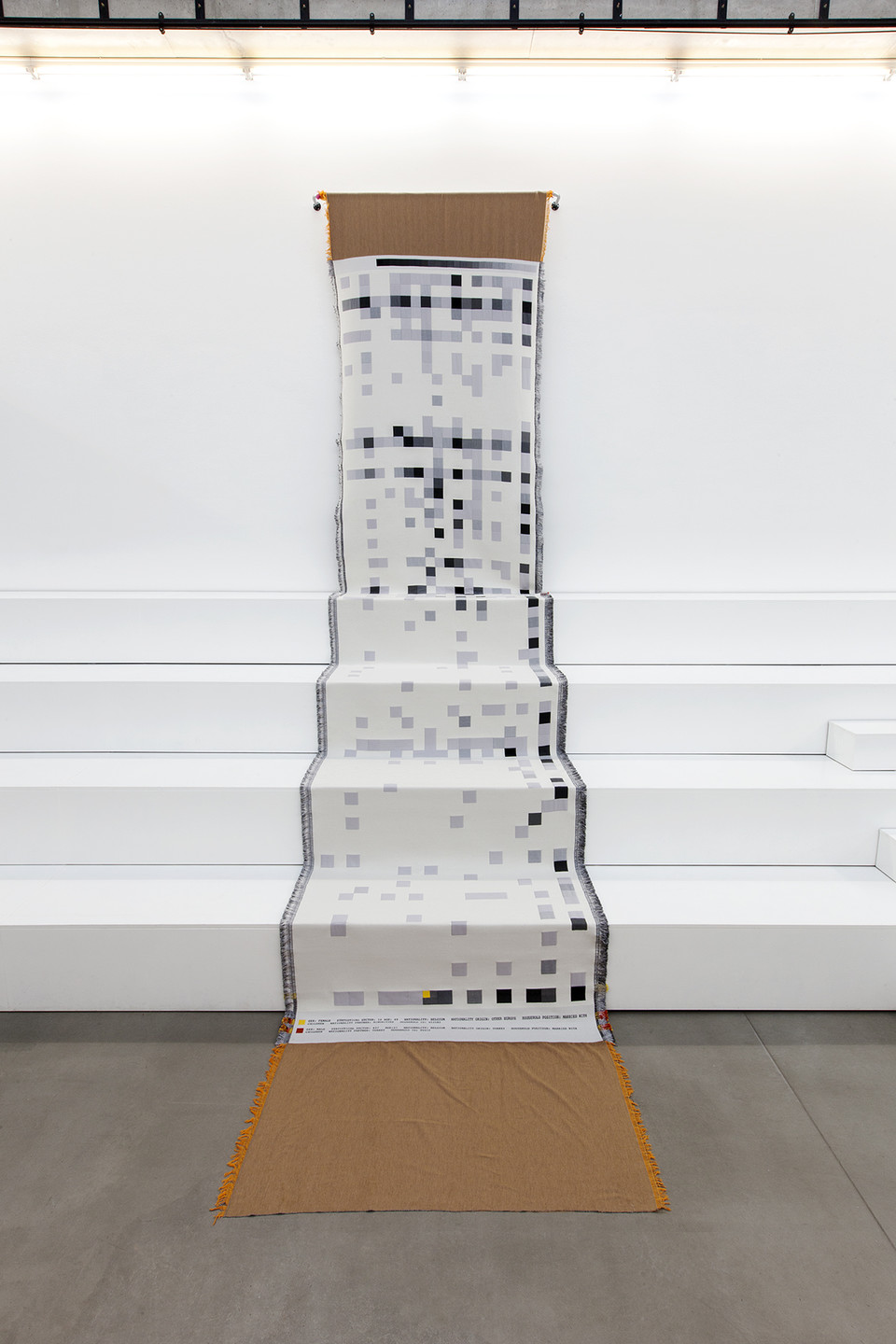
Rossella Biscotti, Aquired Nationalities, 2014, KADIST collection, Installation view, House of Commons, 03.12.2016–29.01.2017, Portikus, Frankfurt/Main, Photo: Helena Schlichting
In addition to the work of Rosella Biscotti, other recent Frankfurt exhibitions also showed works with a focus on textiles. One example is Willem de Rooij’s large woven pictures from the weavings series (2011-2014) in the exhibition Willem de Rooij. Entitled at the Museum of Modern Art – MMK 2. Since 2009, de Rooij has been producing the works in the Henni Jaensch-Zeymer hand weaving plant near Berlin. The dimensions of the works are always based directly on the capabilities and techniques of the looms. The artist compares the crossing of threads running in two different directions with terms such as opposition, contrast, transition and nuance. Some of the resulting textiles are highly reminiscent of monochrome paintings, but on closer examination the seemingly monochrome fabric reveals at least two color nuances.
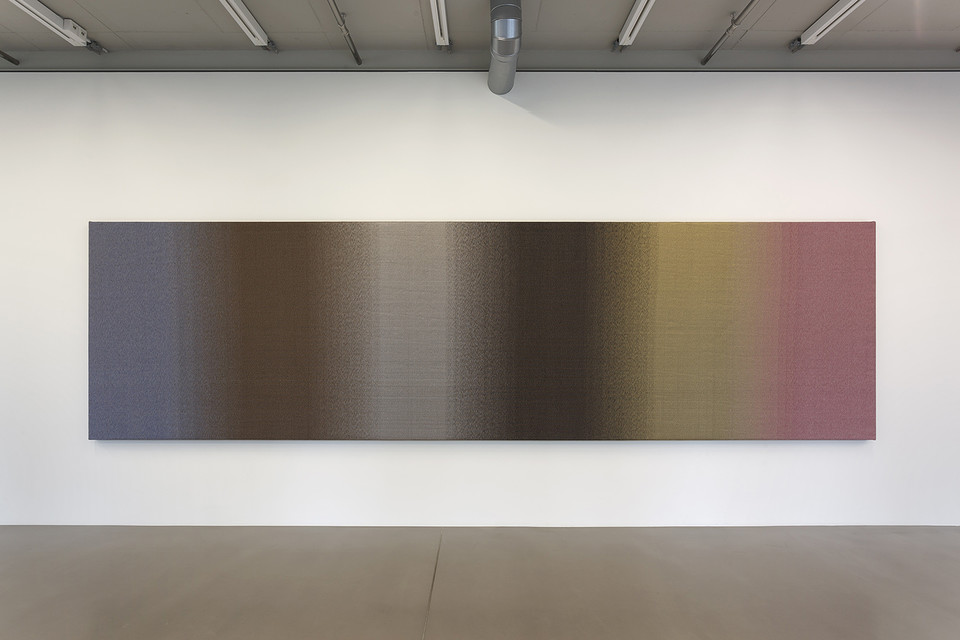
Willem de Rooij, Taping Precognitive Tribes, 2012 , Courtesy: Friedrich Christian Flick, Photo: Axel Schnider, Quelle: Mousse Magazine)
Similarly, the artist Thomas Bayrle, who lives and works in Frankfurt, deals with textiles, or, more precisely, with ornamental pictures and the principle of the serial. With an eye for subjects from pop culture, Bayrle, who is a trained weaver, is particularly interested in “the relationship between the individual thread and the whole fabric”2 and compares this structure with the relationship of the individual with the collective or with society. In addition, the artist has also revealed his skills in applied art, as his designs for the world-famous fashion label Clemens en August show, which were also shown in the 2008 retrospective of his work at the Francesca Pia gallery.
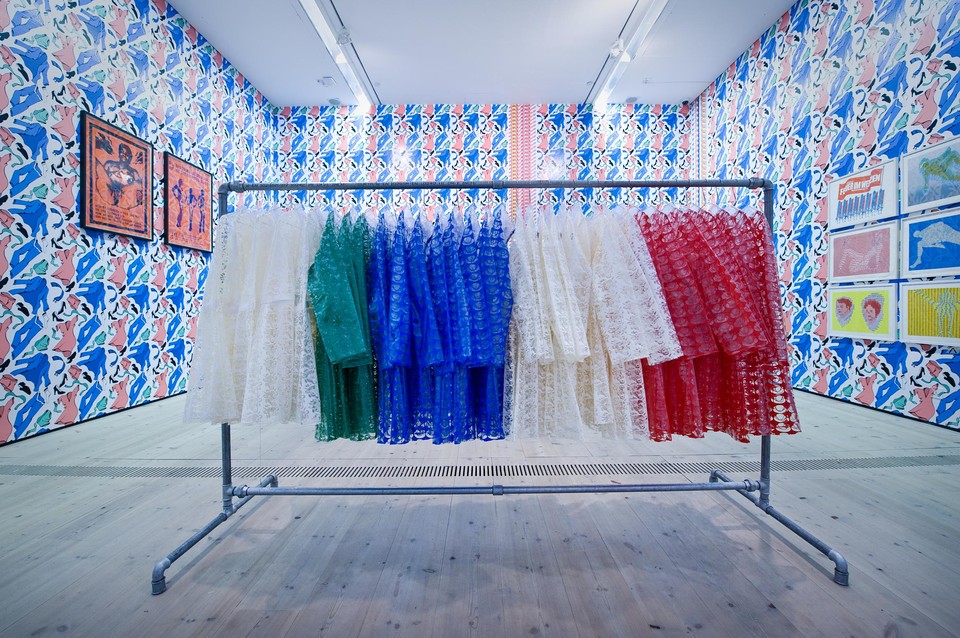
Thomas Bayrle, All-in-One, Installation view, WIELS Contemporary Art Centre, 09.02 – 12.05.2013, Brussels, 2013. Quelle: WIELS
As we see, textile works are neither superficial, as an association with the fashion world might perhaps suggest, nor do they represent a mundane craft. Rather, the mere complexity of the different materials proves that textile is an ideal medium to describe both individual stories and social contexts, or to even interweave the two themes.
Eight square aluminium bars of different lengths lean – at regular intervals – on the white wall of Portikus. The smooth polished surface reflects the light and the surroundings, wrapping it in a silvery white shimmer. On each of the long sides of the bars, a verse of poem number 1695 by Emily Dickinson, “There is a Solitude of Space,” can be read in black, vinyl, sans serif capital letters:
THERE IS A SOLITUDE OF SPACE
A SOLITUDE OF SEA
A SOLITUDE OF DEATH, BUT THESE
SOCIETY SHALL BE
COMPARED WITH THAT PROFOUNDER SITE
THAT POLAR PRIVACY
A SOUL ADMITTED TO ITSELF—
FINITE INFINITY. 1
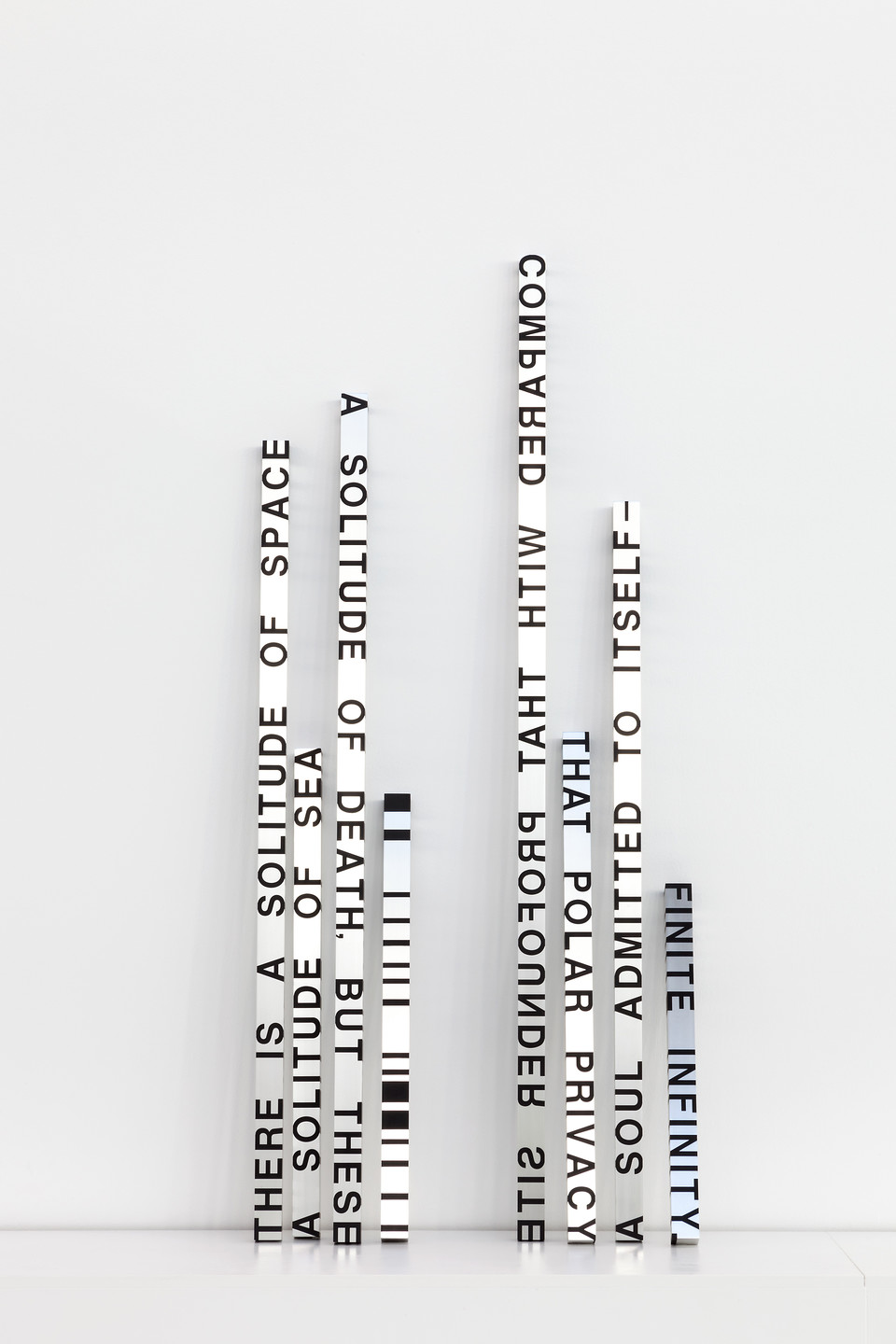
Roni Horn, When Dickinson Shut Her Eyes: No. 1695 (There is a Solitude of Space), 1993, Installation view, House of Commons, 03.12.2016–29.01.2017, Portikus, Frankfurt/Main, Foto: Helena Schlichting.
The words of the nineteenth-century poet, who as a teenager had already retreated to the house of her parents in Amherst, Massachusetts, and while living as a recluse wrote 1775 poems. Her lines are forced into the vertical by artist Roni Horn and resound modestly in the exhibition space. In the 1990s, the artist developed a series of sculptural works entitled When Dickinson Shut Her Eyes that are directly related to Emily Dickinson’s poetic work, embodying and re-“enacting” her poems. The works question the exchange between language, object, and viewer and, in their calm, uniform appearance, promote the extension of established patterns of thought.
Roni Horn’s industrially manufactured aluminium bars interlink text and objects in many ways. They line up alongside one another like lines of poetry cut out of a book. Their metallic surfaces reflect Portikus’ upper wall and ceiling segments while assuming the white colour of a paper background. Where the letters touch the edges, they continue as markings. They thus surround the shaft of the bar and convey the image of inflated letters made of deeply absorbed ink. Here the two-dimensional medium of writing surrounds the three-dimensional body of the individual sculptures. Thus, the work of Roni Horn shimmers between two correlations of text-become-object: On the one hand, the lengths of the lines determine the exact size of each single sculpture while the multi-perspective characters emerge from their background; on the other hand, they are bound and tied to the carrier, thereby underscoring their formal correlation and dependence.
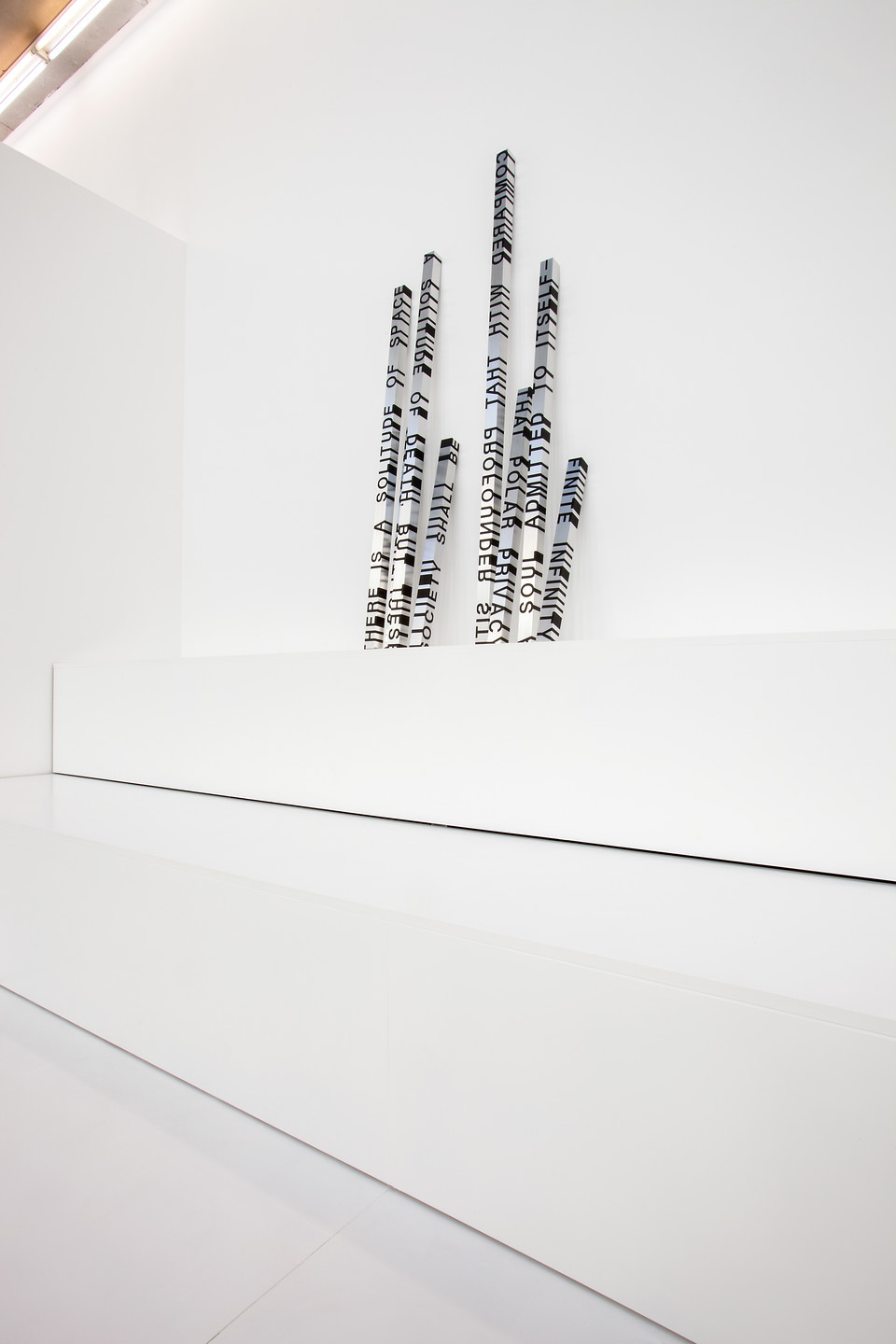
Roni Horn, When Dickinson Shut Her Eyes: No. 1695 (There is a Solitude of Space), 1993, Installation view, House of Commons, 03.12.2016–29.01.2017, Portikus, Frankfurt/Main, Foto: Helena Schlichting.
Each bar is also a self-contained and closed object. However, one of the middle bars arouses curiosity. It is positioned so that the side with the writing is turned towards the gap between the objects making the line “SOCIETY SHALL BE” indecipherable from the front. Since at this point the communicative function of writing dissolves in favour of its graphic qualities, a tense relationship between the objectness and the textuality results. The gaps become associative open spaces. They open our view to the white wall behind them, and, like reading between lines, allow us to search for further levels of interpretation.
As viewers, we are challenged in a special way by the characteristic of the text-object-relation. The reading direction and the course of the letters are always vertically oriented, so that the bars form links in a literary-poetic chain; a series of sentences whose syntax is disturbed by the different orientation of the text. We are urged to read with a constant change of perspective: at times from the bottom to the top, then turned around, and then mirrored. In this way, the work breaks with our usual, static reading behaviour. To grasp the sentences in their completeness, our bodies are forced to move. Disagreement arises between distance and proximity. On the one hand, we physically adapt to the direction of the writing while reading, but at the same time this specific interaction alienates our reading flow.
Roni Horn materializes the words of Emily Dickinson and translates them into a physical experience. She confronts us with a static corporeality that demands that we move. While quietly pacing alongside the objects, the sentences mentally shape themselves into a whole, creating the projection surface for a variety of readings and perspectives on the work. Standstill and movement, language and form flow together to a spatial and temporal experience within which the units dissolve. The artist thus creates a situation in which associative mental play and physical motion connect.
Translated by Faith Ann Gibson
Skin covers the surface of the human body, shrinking or expanding as the body moves and bearing the marks of its actions and the impacts it has suffered. Objects that cling to the skin, that are used or worn by the body, influence its posture and the way it moves and conversely adapt (or are adapted) to its characteristic movements. Clothes, shoes, furniture, and prostheses add to the body’s repertoire of forms and functions. They endow it with abilities that, in and of itself, it possesses only to a degree; for example, they enable it to withstand cold without feeling it, to sit elevated above the floor, or to walk with a single leg. Even when they are not in use, these objects evince the traces of their application: they are virtual images of their wearer.
The pedestal is a body in space. When it appears in the context of an art exhibition and supports an object, that is a choice made by third parties (artists/curators). This choice stands for the duration of its presentation. It prompts contact between two bodies, the supporting body and the one being supported. The pedestal adds several functions to the object to be supported: it sets it apart from the space around it and elevates it; the floor on which the beholder stands is no longer the ground on which the object rests, this provokes a distance that brings the perception of its surface into focus. That distance elevates the object both in fact and in the idea. Things reduced to the purpose of being beheld become (virtually) untouchable and no longer belong to the realm of objects of utility.
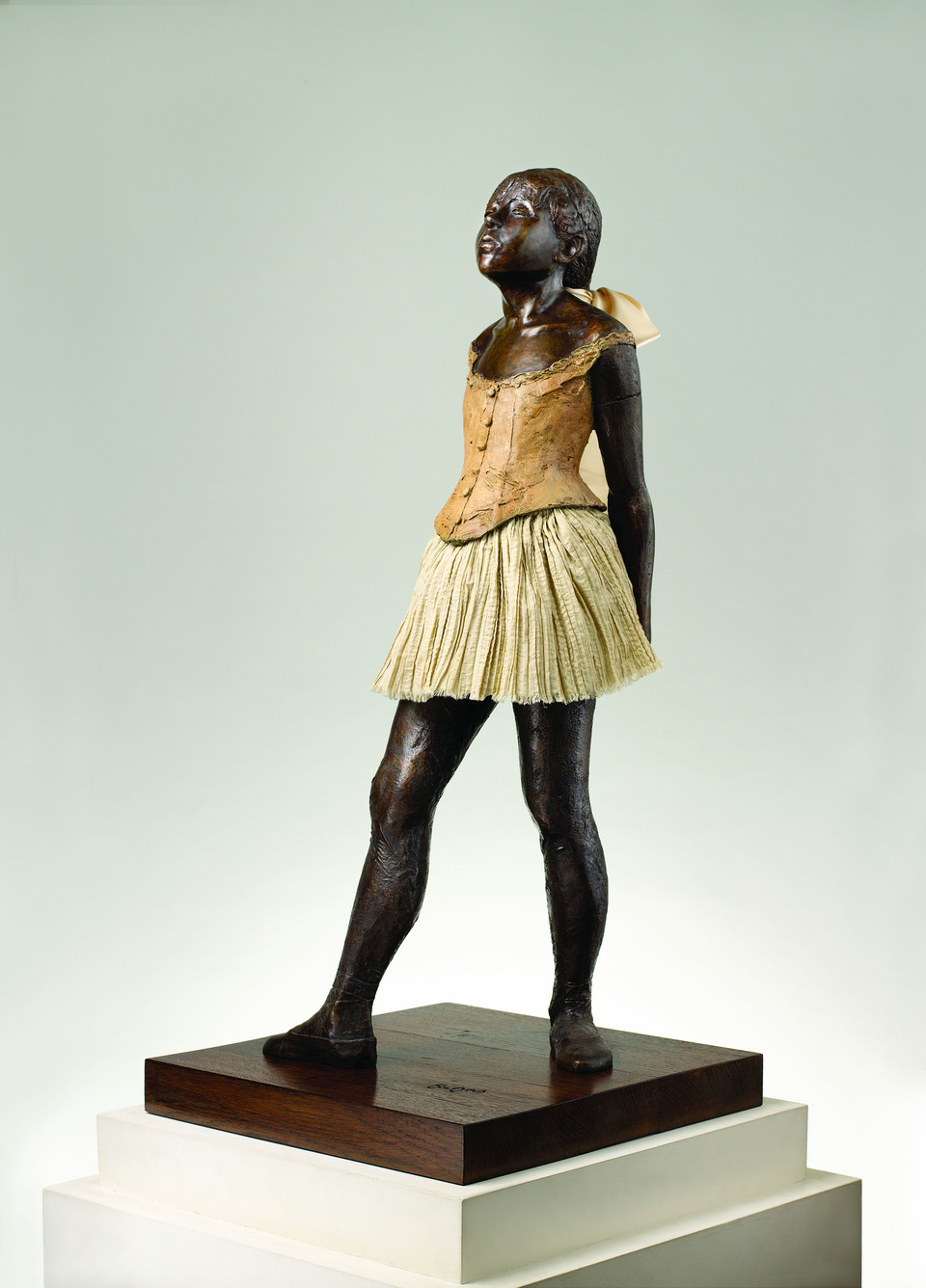
Edgar Degas, Petite danseuse de quatorze ans, 1878/1881, by M.T. Abraham Center - Provided by copyright owner of both photograph and artwork, CC BY 3.0, Wikimedia Commons
How present may a pedestal be in the framework of a presentation? It depends on how self-contained the work of art it supports is, or in other words, how strongly it insists, by virtue of its facture, on the difference that sets it apart from the space around it. When object and pedestal make their presence felt with equal force, the pedestal becomes part of the work of art.
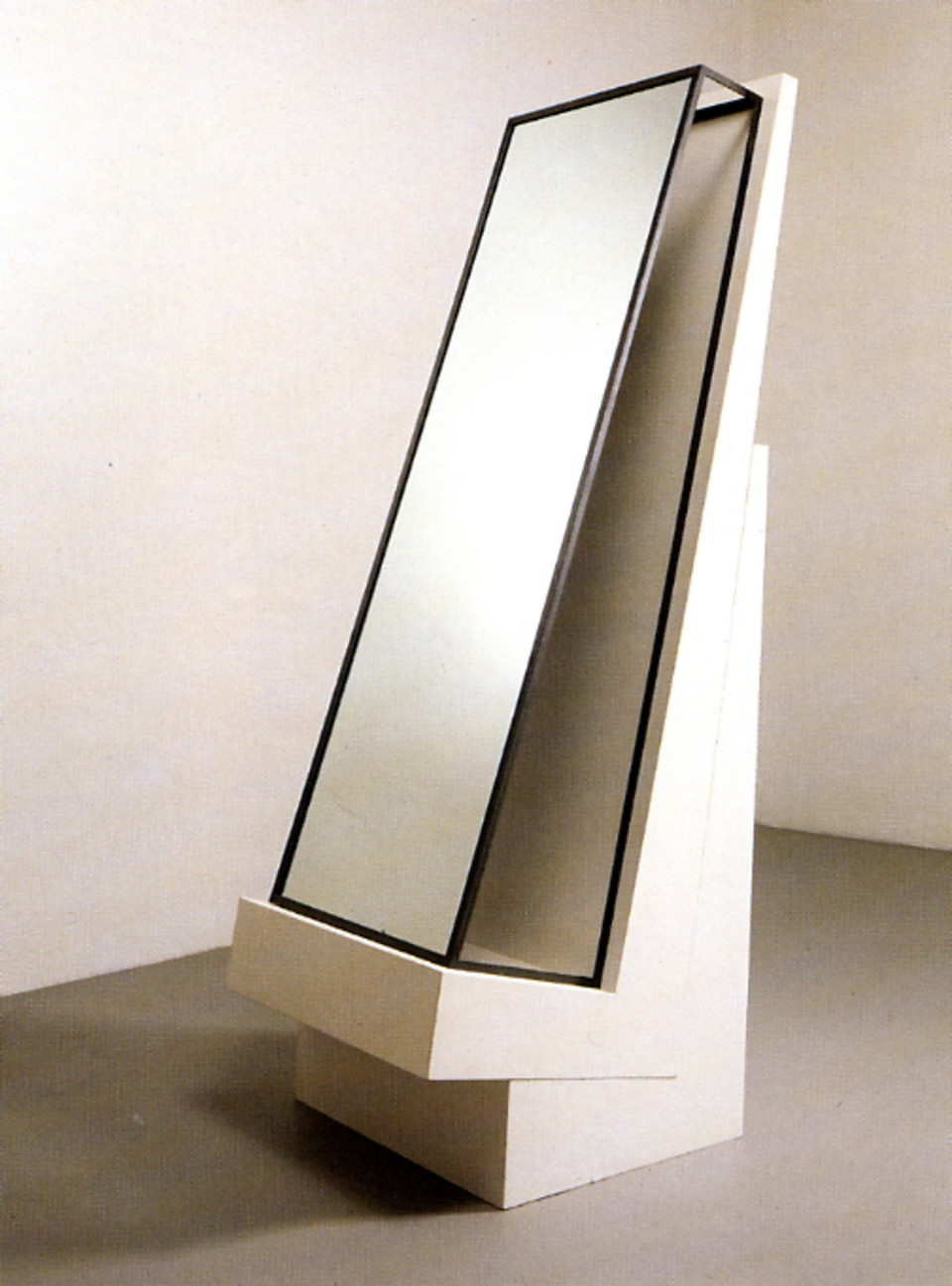
Michelangelo Pistoletto, Vetrina-Specchio, 1966
However, there are art objects that do not rest on a pedestal and nonetheless engender the distance from the beholder required to be perceived as untouchable works of art. A higher degree of autonomy is attributed to works that produce this effect by dint of their own constitution rather than by virtue of their being installed on pedestals. When their surface is in direct contact with the floor they share with the beholder, they do not require any support.
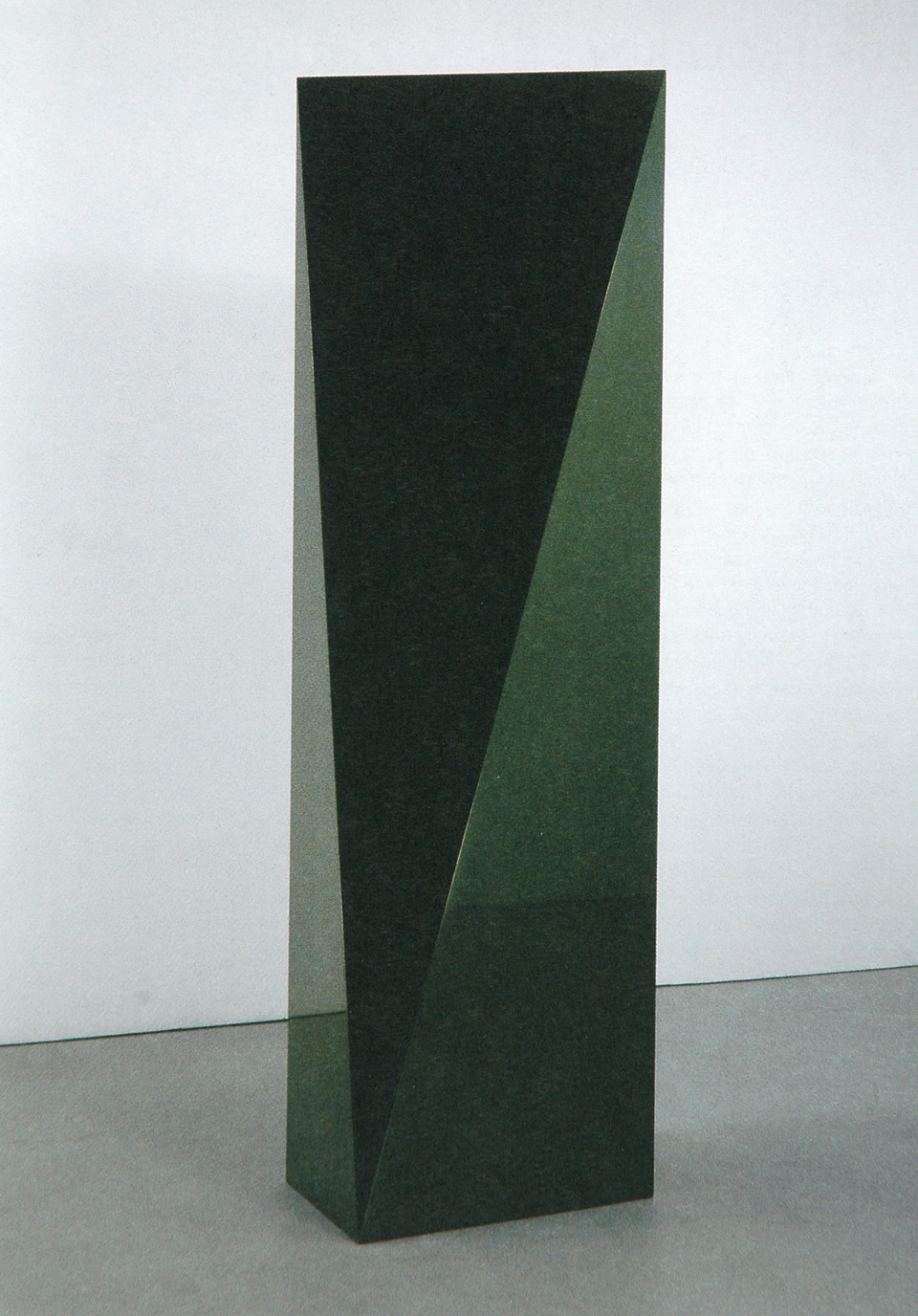
John McCracken, Minnesota, 1989
The body of the pedestal can manifest itself in a variety of ways. The more “normal” it is—the more its form follows its function as a humble support—the more it will tend to become invisible. The further it deviates from this subjective standard, the more its presence will be felt. Factors that play into its visibility or invisibility include its proportions, form, materiality, and surface. When a pedestal does not support an object, its surface becomes a projection screen. The more it departs with regard to these traits from what we are used to perceiving as pedestals, the more it will become an autonomous sculpture. An object of utility then metamorphoses into an object of contemplation. The distinction is not clear-cut. Transitional phenomena range from a sort of phantom pain making the absence of an object on the pedestal so keenly felt that its likeness seems almost graspable, to the sense of formal saturation evoked by the appearance of the pedestal itself.
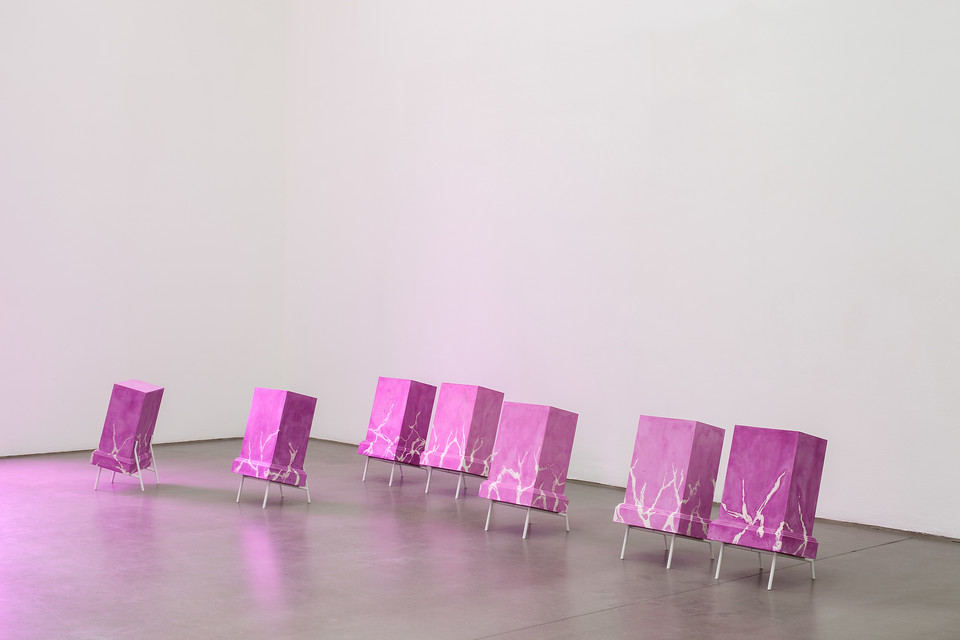
Shahryar Nashat, Chômage Technique (A,B,C,D,F,G,H), 2016
Shahryar Nashat’s work Chômage Technique consists of pedestals painted in a rose color and installed on chair-like stands, where they seem to be basking in the pink light filling the Portikus. They face Nashat’s video Present Sore, which shows bodies in action as well as rigid poses in brief but intense sequences. The camera pans over flawless or bruised skin surfaces, focusing on the points where they come into contact with apparel, bandages, and prostheses. Then the video gingerly approaches one of Paul Thek’s Meat Pieces, with cables and hoses protruding from it; it is repeatedly interrupted by a rendering of a pink-dappled menhir that lingers on the screen longer and longer. The small pedestals dispassionately observe the goings-on in the realm of things: relieved of their function, they shall not be made to support any of it.
Translation: Gerrit Jackson
To the exhibiton by Shahryar Nashat
Marina Rüdiger, Master of Fine Arts & Bachelor of Art History (Kunsthochschule Kassel), currently studies curatorial studies, a master’s programme at the Staatliche Hochschule für Bildende Künste – Städelschule and Goethe University Frankfurt and works for Galerie Bärbel Grässlin in Frankfurt.
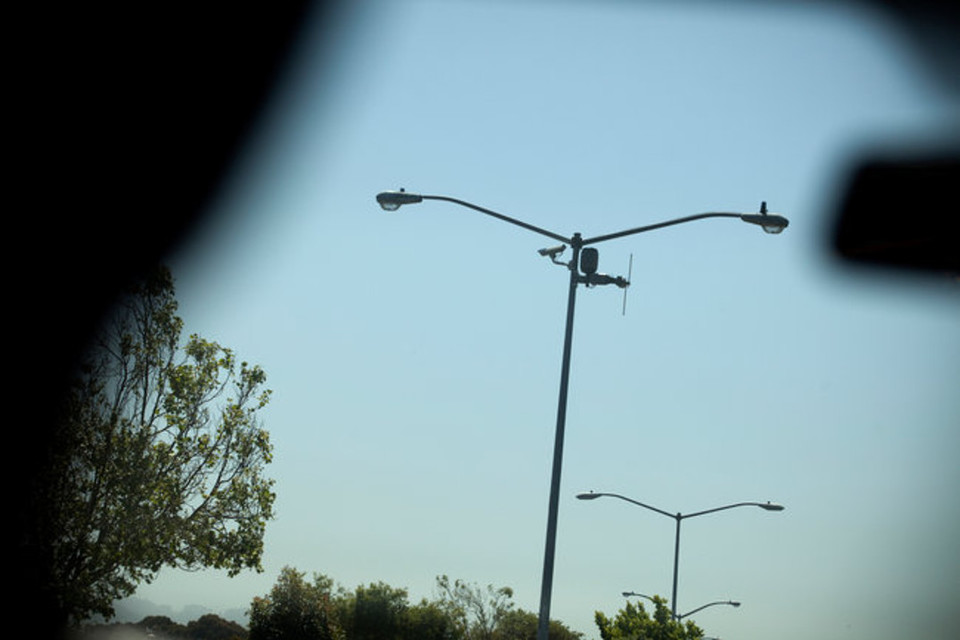
Spotting the Shottspotter: photograph of Shotspotter microphone installed on the top of a street lamp. Courtesy of the artist.
In December 2014, new audio evidence emerged that captured the moment when unarmed teenager Michael Brown was shot to death in Ferguson, Missouri that August. The audio was submitted by an anonymous man who incidentally caught the moment of the shooting as he was recording and sending a private voice message from his phone using the Glide app. He only realised much later the significance of the gunshots he had accidentally recorded.
In this recording it is audible that Brown's murderer, a police officer by the name of Darren Wilson, fired his gun ten times. Six of these shots hit Brown, mostly in the head (all above the torso). And yet there is another and unexpected violence that is captured in this recording – one that, whether presented on CNN or to the grand jury, listeners were asked to ignore. While both defence and prosecution provided forensic audio experts to provide their own accounts about the gun shots that could be heard in the background of this recording, neither realised that the greater Police violence enacted upon the residents of Ferguson and many other African-American neighbourhoods in the United States, was in the foreground, clear for all to hear.
This is the recording transcribed with both the foreground and background sounds included:
"You are pretty. [6 gun shots]. You're so fine. Just going over some of your videos. [gun shot] H[gun shot]ow c[gun shot]an I f[gun shot]orget?"
Dr. Robert Showen was one of the key expert listeners in this case. His analysis of the gunshots centred mostly on the echo they created. Using the impulse sounds of the shots and their reflection off nearby walls, he was able to define the space around the shooter. As each echo of each shot was very similar in sound, it meant that a conclusion could be drawn that the murderer was stationary and stayed more or less in one place while he was firing the shots. This evidence corroborated some eyewitness testimony and was also key to denying the veracity of other contradicting accounts. Technicalities that amounted in the end to a greater body of evidence that concluded that unarmed Michael Brown was charging at the officer and that the officer was therefore acting in self-defence when he repeatedly shot Brown in the head.
The expertise of Dr. Robert Showen was called upon because of his extensive experience of working with gun shot sounds as echo location instruments. Showen is the founder and creator of ShotSpotter™, a gunshot detection and location service, which works by installing microphones throughout a neighbourhood to listen for sounds from the street that might be gunfire. When the microphones detect a loud bang, they automatically triangulate where this sound is coming from. The information is algorithmically analysed against a huge database of loud bang sounds to quickly verify if the sound registered is indeed a gunshot. If it decides that the sound is gunfire, it sends the location of the gunfire to the Police Department. This is on average accurate within thirty feet of where the shot happened. ShotSpotter™ system of microphones is now installed in eighty "troubled" neighbourhoods across the United States. They have aspirations to cross the Atlantic, having now installed systems in South Africa and, after the recent attacks in Paris (November 2015), they saw the opportunity to make themselves available on the European market.
Dr. Robert Showen told me in an interview that ShotSpotter™ microphones are typically placed on the rooftops of buildings so that one can "listen to the horizon". "So they are mostly installed on private property?", I asked. His response was: "Yes we went out with the police officers and knocked on doors and asked if the people would allow us to put a sensor on their building to help protect the community from gunfire, practically everyone agreed [...] everyone was just willing to donate their roof for the benefit of the community". Showen's statement that "everyone was willing" seemed contradictory with ShotSpotter™, whose whole rhetoric was constructed on its necessity as a security infrastructure, based on the fact that the communities affected by gun crime were made up of unreliable witnesses who failed to report more than eighty percent of the gun shots they had heard. The idea then is that ShotSpotter™ would replace these unfaithful ears with law abiding microphones and be able to algorithmically detect eighty percent of gunshots that went previously unreported. Showen says: "Our sensors' microphone sensitivity is almost identical to what is on a cellphone and a speakerphone". But the human hearing capacity is in general much more sensitive and adapted to reading sounds than a cell phone microphone placed on a rooftop. Therefore the issue is not that people don't hear the gun shots and the microphones do, but rather that people hear the gunshots and choose not to report them to the police. This startlingly high figure of unreported incidents suggests that, as in the case of Michael Brown and hundreds more since, the police can be more dangerous, more racist and more trigger-happy than the alternative. Showen seems oblivious to this idea when he speaks of the brutal inauguration ceremony that happens in each community when ShotSpotter™ is installed: "When we install a system, we have the police go out and shoot and we see the accuracy and the sensitivity of our system".
It is no surprise then that when Showen forensically listens to the recording of the death of Michael Brown, he doesn't hear the loudest aspect of this recording: the love-struck voice who, despite the sound of gunfire ringing out loud outside his window, continues unfazed to send a message to the subject of his admiration. Oblivious or perhaps not caring that the message of love he is sending is underscored by the sounds of brutal violence. "You are pretty" he says, and then a short pause that is long enough for a volley of six shots to ring out, and then a brief break in the gunfire and he resumes by saying "You're so fine". Is this short pause an acknowledgement of the gunfire? Is he waiting for it to subside so he can carry on with his message? Perhaps akin to the pause we might make in our conversations while a jet flies overhead? Or is this pause a coincidence and he has simply become totally desensitised to the sound of gunfire outside his window? Either way, this voice that ignores these very loud sounds rather than alerting the emergency services is treated as irrelevant in the courtroom. Yet, this voice which jury members were asked to ignore is ironically the most relevant way to understand the extent of violence in these communities and the endemic distrust of the police.
Future, March Madness [prod by Tarantino], from the mixtape 56 Nights 2015.
Many are concerned that ShotSpotter could constitute a fourth amendment violation – warrantless search and seizure of public sounds. A pervasive method of surveillance that could be used to record private conversations amassing a huge sound archive available for all kinds of security applications. Yet according to ShotSpotter's privacy policy: "The entire system is intentionally designed not to permit 'live listening' of any sort. Human voices do not trigger ShotSpotter sensors". And perhaps this is the more frightening possibility, they are not at all interested in human voices. That, rather than a new hyper-surveilled society that hears everything we say, ShotSpotter points to a society with a total lack of listening. That the more surveillance increases its sonic archives and audio databases, the less people are actually being heard. And when we listen to and not past the voice on the recording of the murder of Michael Brown what becomes distinctly audible is the extent of this societal deafness – a deafness of communities to gun violence, a deafness of the police to so-called "troubled" communities and a deafness of the judges and lawmakers to the social conditions that produce unreliable and uninterested witnesses.
The analysis of the gunshots that killed Michael Brown didn't work in his favour because the conditions of listening are determined by the same authorities that committed the injustice against him. Yet, what would a Shotspotter with its microphones aimed towards the police rather than the people enable us to do? The technology exists, it was already installed before we knew it and, though it has been recording every gunshot across eighty neighbourhoods, there has not been a single case where it was used as evidence to prosecute a police officer. What would it sound like if we could hear this vast database of police gunfire rather than have it ring out only in the desensitised and terrorised communities in which it is a regular occurrence. Instead of demanding our privacy be granted and rejecting this technology, we should instead be demanding more listening, more archiving in order to reverse-engineer it's selective ears. Building an alternative database of sounds from which this system can become artificially intelligent to another reality of violence.
Originally posted on 12 Feb 2016 on L’internationale online.
Before ruangrupa invited consonni to produce and articulate some of documenta fifteen’s key publications, this Bilbao-based publishing house (the words collective, cooperative, and agency would fit them equally) had already evolved a manyfold practice for nearly three decades, engaging in a multiplicity of actions as well as media, and defining a substantial space in the dissemination of critical culture throughout Spanish-speaking territories. Their launch of lumbung stories in eight languages, including Arabic, Bahasa Indonesian, Basque, German, Portuguese, and Spanish, in addition to English, aptly accounts for consonni’s deep commitment to emancipatory difference, transnationalism, hospitality and decoloniality – key aspects in their fluid agenda. This conversation between consonni co-founder María Mur Deán and Manuel Cirauqui, co-curator of HOW(EVER) Radical Objects, foreshadows the symposium to be held at Portikus on October 20–23.
Manuel Cirauqui: At consonni, you approach publishing quite broadly, we could say you do so in a transversal and militant way. Yet, your work invites us to think of the book as seashore, as a seam between practices: an entry point, so that a diversity of people oversteps certain borders and accesses new spaces for theoretical as well as practical imagination. In its enabling movements and accesses, the book is still a vehicle of unique strength. What has been the evolution of your understanding of the book and editorial production, to bring consonni to the place of reference where it stands today in critical culture?
María Mur Deán: consonni is, as you know, a mutant creature whose superpowers are feminisms and listening capacity. Listening to our closest community is fundamental to consonni’s evolution. In the late 90s, it acted as a center for contemporary artistic practices in Bilbao, as the Guggenheim museum did not even exist yet. The needs of the artistic context were very concrete, and there were not so many spaces for their showcase. When production came to be a necessity, in a context in which the notion of solo artist working in their studio was becoming obsolete, consonni evolved into an artistic producer. Editorial production initiated closely glued onto artistic production, and our first books were catalogues containing the projects we produced. Slowly, we wanted to depart from self-referentiality, and we progressively discovered the power held by publishing to amplify critical culture. What is important is the work we do with artists and professional wordsmiths, in order to discover the optimal ways of carrying out our communal project. On many occasions during our conversations, we have discussed how market demand tends to appear as a suspicious thing in the art world—but in the book world there is something liberating about the distant horizons that literature can reach; the feeling of responding to a call. The point at which we are now, in between artistic languages, that trans-disciplinary place, is powerful. It is in that breach that an empowering dialogue emerges—one that allows us to embark on journeys that go beyond the topics and stereotypes of either of these two worlds. Such an intermediate place allows us to transcend both disciplines. It is not about editing and publishing books which are read by no one, but about introducing ourselves into a book world that is sustained by its readers. And this is not about escaping from the art world, but precisely the opposite. Our literary work is, somehow, an artistic project in its totality, while artistic production, like any experience, is narration and nothing more than narration.
MC: In certain occasions, you have mentioned the idea of sharing a responsibility between readers and authors, that of „embodying discourses”. I find it a beautiful way of accounting for the efforts, searches and labours of an editorial project; but it also seems to me that it emphasises something one may tend to overlook—perhaps because of solemnity or formalism—which is the performativity of the book: whatever makes it a portable object and a public space in itself, a place for activation. During HOW(EVER) we hope to address this layer of reading as an activity that involves us, embracing our bodies. It seems that this performative conception of the book has found an ideal model of exploration in the lumbung.
MM: Yes, a book is indeed a collective project, a project of action and of activation. It is an artefact and it is sometimes explosive. At the same time, it is also fundamental to remove the romantic charge that the book has and to escape from its fetishisation. Cristina Rivera Garza thinks of writing in terms of re-writing, in terms of an unfinished exercise, which produces this being-in-common, in communality. More important than the content or message is the process of sharing that accompanies thought. Our relationship with literature goes through the idea of community, as noted by Jean-Luc Nancy—just as production, under our own point of view, goes through the Benjaminian notion of unveiling the apparatus of production and seeking to transform it. The concepts of lumbung, tequio, auzolan have enabled us to move in this direction at a greater speed. We mobilised words to point out the limits of the expressible through literature and through our embodying of those words. We have collaborated with choreographer Idoia Zabaleta on different occasions to develop book readings, and specifically of lumbung stories, this anthology of tales on collectivity which we coordinated within the framework of documenta fifteen. To dance reading. To read dancing. The body interprets the stories, the rhythm adapts to messages and to tones. Words embody bodies and the audience reads the curves, the cracks. Once again, we intervene in literature through art. Reaching documenta fifteen through fiction shows the powerful capacity of literature and fiction to generate communality and to perform.
MC: Becoming and transformation are key to understanding consonni’s practice. You have referred to it as a „mutant creature“ – almost like a character in one of the fictions you could publish yourselves – and as an „interdependent publishing house“. It is at once a platform, an agency, a production office, a swarm of desires. Do you think you are on a path of consolidation of your methodologies and your program, or do you rather feel the need for a systematic mutation or nomadism, a form of resistance to identity itself? There are evocative words, from transformism to animal mimicry and the art of escape, which perhaps resonate with your current state of mind. I am thinking of harriet c. brown, your most recent collective pseudonym.
MM: You are right that mutation has become a constant. And this seems inevitable, since consonni is a polycephalic creature too, a revelation of the different bodies and heads of those of us who embody it. It responds to the different contexts and the times in which it breathes. Each person, each tempo, expresses different needs. Just as the pink panther, as noted by Deleuze and Guattari, paints the wall pink, consonni tweaks its environment in order to become that world. It is not so much about camouflage, but about contagion. In Marina Garcés’s words, it is about being affected by the world and attempting to affect it. In this sense, becoming and mutating seem infinite, as long as the creature breathes. And if it stops breathing, it seems as though it will also mutate through stories and memories; that is uncontrollable, infinite. It does look as though this nomadism is systemic, although knowing this variable creature that consonni is, which has a life of its own, it may even surprise us in that. harriet c. brown is an exercise in constructing a lumbung body, an identity that embodies that which is collective. It is a humanoid tool. When consonni needs to be a proper noun, one more exercise in fictionalisation to complexify the identity, for in its constant metamorphosis consonni also makes a proclamation for fluid identities. consonni is an art center, an agency, a publishing house, a factory of creation. It is all of that and none of that. Actually, those are subject-based identities, while what interests us is to construct identity as mutable, through a predicate. Through acting and thinking. Subject identities are only interesting as political tactics in specific moments. That is why variation, too, is in the DNA of consonni.
MC: Fluidity of identities, of plural forms of organically being– she-bodies, they-organisms – are very present in your own selection of voices and alliances, in the content of what consonni publishes in its books. I can imagine that, for you, the debate around the complexities of identity politics, and the analysis of its many creases, are constant. Nowadays, the nuances that distinguish communities, heritages, legacies, preferences, orientations, territories; ways of narrating and designating and managing oneself; dimensions of identities, which need to be recognised and cared for in a decolonial, non-hegemonic, non-normative framework, are very present. These recognitions are always tied to a liberating force that generates bonds and enables potencies. To what extent do such nuances, forces and potencies, the new constructions of identity, let us say, constitute an editorial agenda for consonni?
MM: Yes, they certainly do insofar as we understand identity not as a reified structure, but as a variable option or a political strategy, working on the multiplicity of identity and with it the disparity of narratives, which is fundamental for us. From [the Indonesian collective] ruangrupa, we have learned the concept of the interlocal, which is truly more fruitful than the concept of the international. In the end, we all depart from our localities, from that which is specific, from our cultures, and what is powerful is when these concrete and specific realities start a conversation. It is essential that bibliodiversity exists, that a diversity of publishers of different sizes coexist, and that in each publishing house there is also a plurality of voices. At consonni, sometimes we depart from our own identities, while at some other times we search for otherness in order to create dialogues.
We are currently a plurilingual team of four feminist women, María Macia, Munts Brunet, Dina Camorino and myself (some of us speak Galician, some Catalan, and some Basque), coming from different parts of Spain, and Argentina. The colleague who handles the press, Belén García, lives in Seville. These territorial realities are reflected in our translation of books by Basque, Galician and Catalan authors (Antxine Mendizabal, Uxue Alberdi, Miren Agur Meabe, Eli Ríos, Ada Klein Fortuny) and in the publication of Latin American authors, such as the Argentinean Ana María Shua, the Salvadoran Jacinta Escudos or the Cuban Iván de la Nuez. We constantly seek the intersection between art and literature by publishing artists, such as the Mexican Verónica Gerber or the Colombian Viviana Troya, who understand literature as part of their artistic practice. Reflecting the fluid reality of the LGTBQ+ community is also a labour that runs through us as a team, hence translating Larry Mitchel and Ned Asta and their book The fagots & their Friends between revolutions, as proposed by those who translated it, Jesús Alcaide and John Snyder. From this point, the conversations and nuances brought by racialised feminisms are the reason why we published Nivedita Menon or bell hooks.
In essay form, Charlene Carruthers, and through fiction, Akwaeke Emezi reveal the way in which colonialism infects people and countries, and investigate the borders of personal, social and gender identity. We also try not to translate English-speaking voices only, in order to spark dissimilar interlocalities. As argued by translator Tana Oshima, translating is not only about transcribing words but, above all, about interpreting cultures. For example, to publish a text that discusses colonialism or race, and yet failing to integrate that debate within the translation itself, even if it causes a certain estrangement within it, is, to say the least, shocking. There is a similar issue with so-called inclusive language, and how to use it, and how it affects a reading. Rather than generating a single recipe, we like discussing each case with the person who signs the text and the person who translates it. With a translation that is unaware of certain nuances, you can ruin the identity and strength of the original text. Even those who make the book covers respond to this notion of pluri-identity, dialogue, and connected interlocalities. At consonni, artists add another layer of content to a book’s cover. Zanele Muholi has contributed with an image of hers for the cover of Charlene A. Carruthers's book on queer and black precepts. German photographer and artist Ursula Schutz-Dornurg has provided the cover photograph for Antxine Mendizabal's Vínculos, a novel about three generations of isolated women. Artist Solange Pessoa collaborates with a drawing in the next book by Vinciane Despret that we are going to publish. In this way, we complexify identity like a kaleidoscope, so as not to simplify it into a pastiche or instrumentalized exoticism, which is the danger of multiculturalism.
Translated from Spanish by Mireia Molina Costa
María Mur Dean has been part of consonni’s fight through the fields of publishing and independent cultural programming since 1999. consonni produces and publishes critical culture since 1996, is written in lower case and is a mutant androgynous and polycephalic creature.
Manuel Cirauqui is a curator, writer, and the founding director of Eina Idea, a think tank and programming platform at EINA University Center of Design and Art, Autonomous University of Barcelona.
[…]
“Honestly. It must be a bit like that photograph of yours, the blow-up falsifies the context: you have to see things from a distance. Méfiez-vous des morceaux choisis.”
Antonio Tabucchi, Indian Nocturne1
“Something fantastic has happened. Those photographs in the park, fantastic! Somebody was trying to kill somebody else. I saved his life.”
Michelangelo Antonioni, Blow–Up2
A.
Two coordinates for the reader:
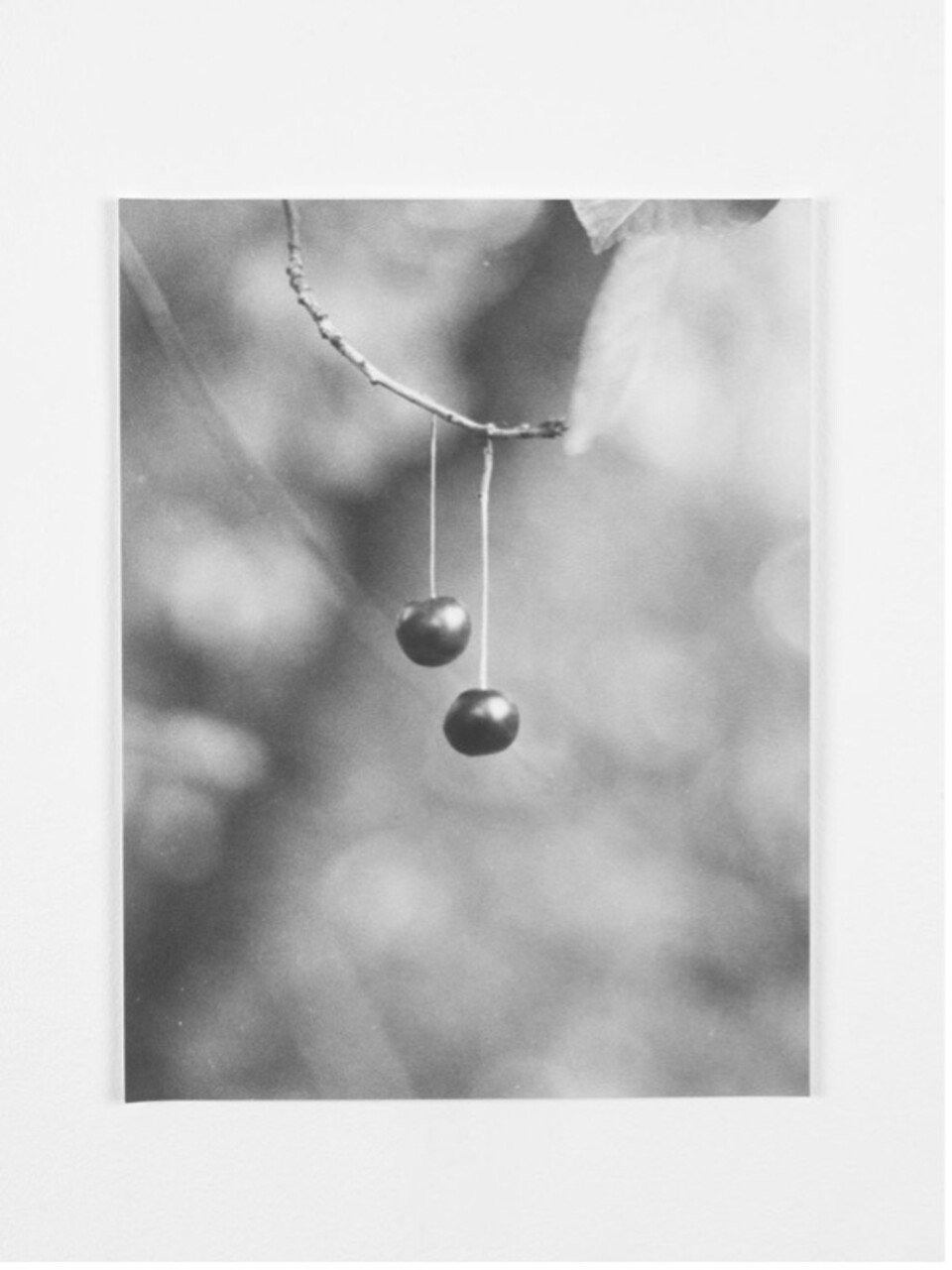
Jochen Lempert, Kirschen, 2019, © Jochen Lempert/VG Bild-Kunst, Bonn 2022. Courtesy BQ, Berlin und ProjecteSD, Barcelona
1.
“Beware of the chosen pieces!” (Or one could also intend “Beware of the cherry-picking”…)
Recommends the character in Antonio Tabucchi´s Indian Nocturne.
2.
As for the photographer in Blow-Up: he didn´t save anyone. Even though he thought so at first, it was a deception.
Blowing-up the pictures though, the photographer finds out “the fact”, something his bare eyes could not perceive at first. He stretches the image and in this very precise moment, it seems like the matter of the fact (that is the matter of the image) is at once more clear and more cloudy. The perceptible particles of all subjects seem to stay still, in a state of explosion, –at the beginning of it, one could say. In this very moment, while seeing less, while the contours between things blur in between the grains of the image, one can see better. Or can detect something new, something unexpected.
When looking carefully, it is possible to realize that everything one sees is made of the same substance. Should the viewers be willing to engage in a sort of myopic dance, in the space, in front of Jochen Lempert´s photographs, by going very far from and very close to the very large and the very tiny images shown in Portikus, they could calibrate their own sight, and play. Indeed, one could think about it as a danced game of gazing exercises.
B.
According to the dictionary the etymology of the word “coincidence” can be traced back to the 1600 ca. At that time its meaning was: “exact correspondence in substance and nature,” while in 1640 “coincidence” started to be intended first as “occurrence or existence during the same time”, and then as “a concurrence of events with no apparent connection, accidental or incidental agreement.”
For the purposes of this investigation, let´s keep in mind the first definition: “the exact correspondence in substance and nature.” In fact, it is no accident at all that the photographs here are so crucial both to their own constellations and to the exhibition space. No mediating devices, no glasses, no passepartouts, no frames are to be seen when entering Portikus. The photographs are directly placed on the walls. Bare, they become part of the architecture itself.
When talking about the difference between “choice” and “decision” during an exhibition tour curator Yasmil Raymond highlights that choice can be defined as an opportunity, ability to select, whilst decision is a conclusion, a judgement, a powerful resolution. “It is a cut” Raymond says, while cutting the air with the fingers as one does with scissors. SNIP. The metaphor falls perfectly into place when it comes to this photographic work. Jochen Lempert decides, therefore he cuts. For each show he goes into the exhibition space with a large selection of photographs from his archive, only then he decides which are the ones that are to be shown in these specific circumstances. Once the decision is taken, at that very moment he cuts the prints, on site. No ambiguity. The purposedly and carefully re-framed photographs thus turn into something new, they are now different from their companions in the artist´s archive. While being at once doubles and extraordinarily unique, in every exhibition the pictures become simultaneously part of a new constellation (the here and now) and of an on-going, ever growing one (connected to all other Lempert´s exhibitions past, present and future).
C.
When talking about the selection of photographs in one of the vitrines downstairs, Deborah Müller, co-curator of the exhibition, points out that Jochen Lempert has always been interested in the connection point between the trees and the earth. It is particularly exciting to wonder about the reasons why. In fact, thinking about it, it is a very specific liminal area for it is not really defined: it is not possible to perform a proper cut here. Plus, it is exactly where, through the trees, one can see air and earth showing their interconnectedness. Trees as beings that link the earth to the sun and the cosmos. They extend themselves deep down into the earth. What one sees it is just a part, a detail, apparently cut out from the rest of the context. They are indexes signaling that there is always something else that can be discovered out of the frame of the immediately visible.
D.
As in a sort of Warburgian Mnemosyne the photographs can be read, experienced, memorized in different orders and directions. On the upper floor they can be looked at dispersed at different heights vertically and horizontally; downstairs they are both on the wall, aligned at the same height or placed horizontally in four vitrines, to allow a book-like perspective. Eyes are invited to adjust to the change of scale, they cannot quite rest. Within a matrix of positions and sizes, the gaze proceeds and stops, goes back and forth again, for in the exhibitions there are many clues, and it often happens that one recognizes elements, pairs them with one´s own memory and with the newly shaped memories created by other exhibited pictures. It is a cross-reference game between details that look alike and bring the mind elsewhere, out of the frame. A travel in space and time amongst crops that constantly remind the viewer of something else.
Like cherries, one leads to the other, and one cannot stop eating them.
E.
Two cherries pair with the eyes of a frog and connect with the trees outside the windows. Then to the chessboard-like tree trunk. A picture of a leaf resembles a map of a city. And while the coral testifies that its shape is the outcome of the sea streams and external circumstances, the very same grains of all the prints, the very matter of the images let the viewers connect the dots. Everything seem and is the exact correspondence in substance and nature of something else. Or of everything else.
It´s at once a split second and all history together. A ladybug, a car, a console bracket, a detail of a painting, the window of a plane.
SNIP.
They overlap.
In the framework of his exhibition Pierre Verger in Suriname Willem de Rooij invites the artists Razia Barsatie, Ansuya Blom, Ruben Cabenda, and Xavier Robles de Medina to show their works on the Portikus website. With the program Flux und Reflux – A Selection of Moving Images Portikus' audience is introduced to moving image made by four contemporary artists who have a relationship to Suriname. The video works will be online for two week at a time:
01.07.–14.07.2021
Razia Barsatie
A no san fesi e sori, ati e tyari, 2021
(wat niet op het gezicht te zien is, draagt ’t hart
m.a.w. het uiterlijk is anders dan het innerlijk)
Video-installation
8,3 m x 5,1m
Charcoal, plaster, flour dough, camphor, tapioca, kitchen cleaning towel, marker, thirteen small engines
Based on her fictional theater play "A no san fesi e sori, ati e tyari," the video installation of the same title presents a chaotic atmosphere between the deep-rooted subconscious and the conscious mind of the protagonist, Christien. Caught between loneliness, hatred, trauma, trust and confusion, she asks how she can explain something to someone when she doesn't even understand it herself. The installation produces abstract and concrete repetitions – multiple finger sculptures stacked on charcoal are accompanied by wall drawings. In the rhythm of the installation, Barsatie creates a meditation of giving space, burning the inner thought, and processing and releasing it.
Razia Barsatie (*1982 in Paramaribo) lives and works in Amsterdam where she pursues her research on scent preservation, memory and the domestic as a space of emotional oppression. She graduated from the Rietveld Academy and is currently a resident at the Rijksakademie in Amsterdam. Recent exhibitions include Nieuwe Kerk Amsterdam, Nieuw Dakota and Theater Thalia in Amsterdam, artist residencies and exhibitions in Moengo, Suriname, Thami Mnyele Foundation Award in Amsterdam, CARMA in French Guiana and the Caribbean Linked III Atelier '89 in Aruba.
Song credit:
Maa-mujhe-apne-aanchal | Singer: Fariz Barsatie
Maa-ki-dua-jannat-ki-hawa |Singer: Muhammad Hassan Raza Qadri
Voice credit:
Daniel Aguilar Ruvalcaba | Diana Cantarey | Özgür Atlagan | Salim Bayri | Aldo Esparza Ramos | G | Lungiswa Gqunta | Claudia Pagés Rabal | Tomasz Skibicki | Mette Sterre | Sungeun Lee | Anh Tran
Thanks to:
Schrijversvakschool | Vincent Reit | Faaria Kasiem | Niaaz Kasiem | Ansuya Blom |
Annelie Musters | Ratu Saraswati | Elke Uitentuis
Installation shots: Courtesy of the artist and Rijksakademie Archive
Portrait image: Marjet Zwaans
Artist website: https://www.raziabarsatie.com
In the framework of his exhibition Pierre Verger in Suriname Willem de Rooij invites the artists Razia Barsatie, Ansuya Blom, Ruben Cabenda, and Xavier Robles de Medina to show their works on the Portikus website. With the program Flux und Reflux – A Selection of Moving Images Portikus' audience is introduced to moving image made by four contemporary artists who have a relationship to Suriname. The video works will be online for two week at a time:
17.06.–01.07.2021
Ruben Cabenda
Nieuwe herinneringen aan oude huizen, 2019
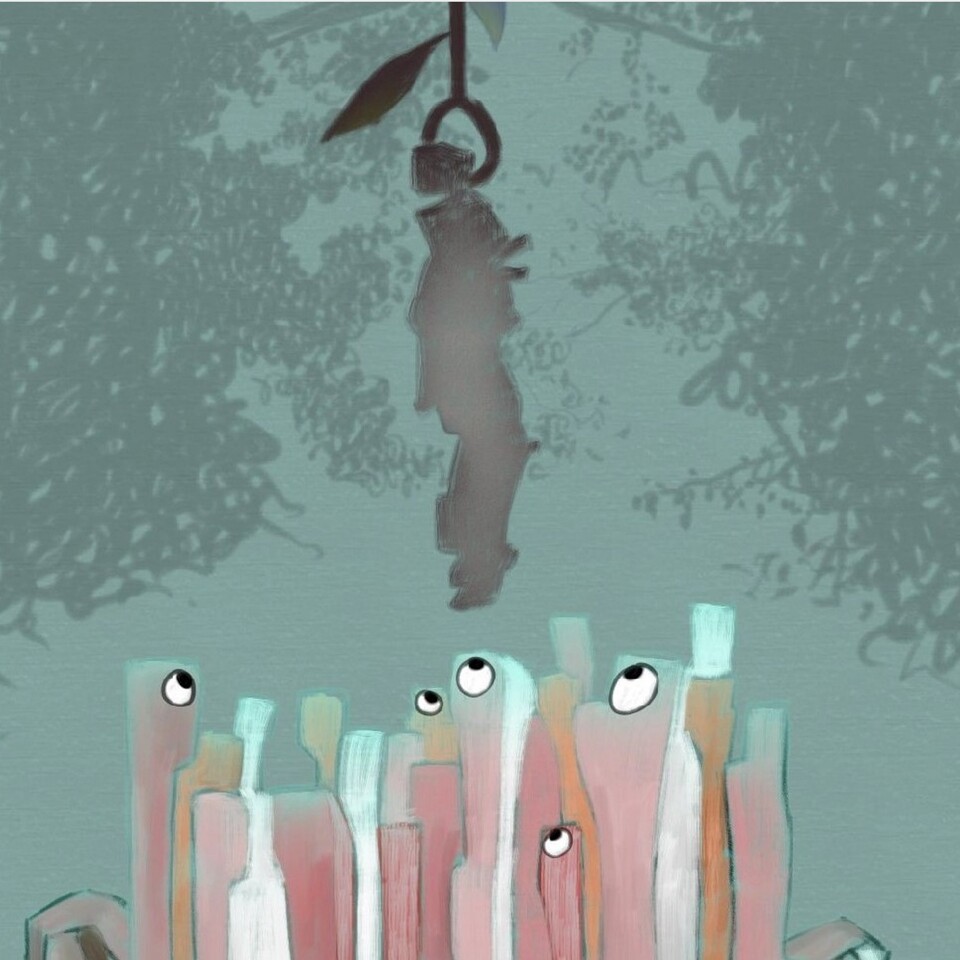
Developing his animations from ideas, sculptures, drawings and paintings that serve him to work through questions of identity and cultural heritage, religion and slavery, Ruben Cabenda synthesizes new ideas in them. Presented as loops, their repetition harnesses the power of moving image.
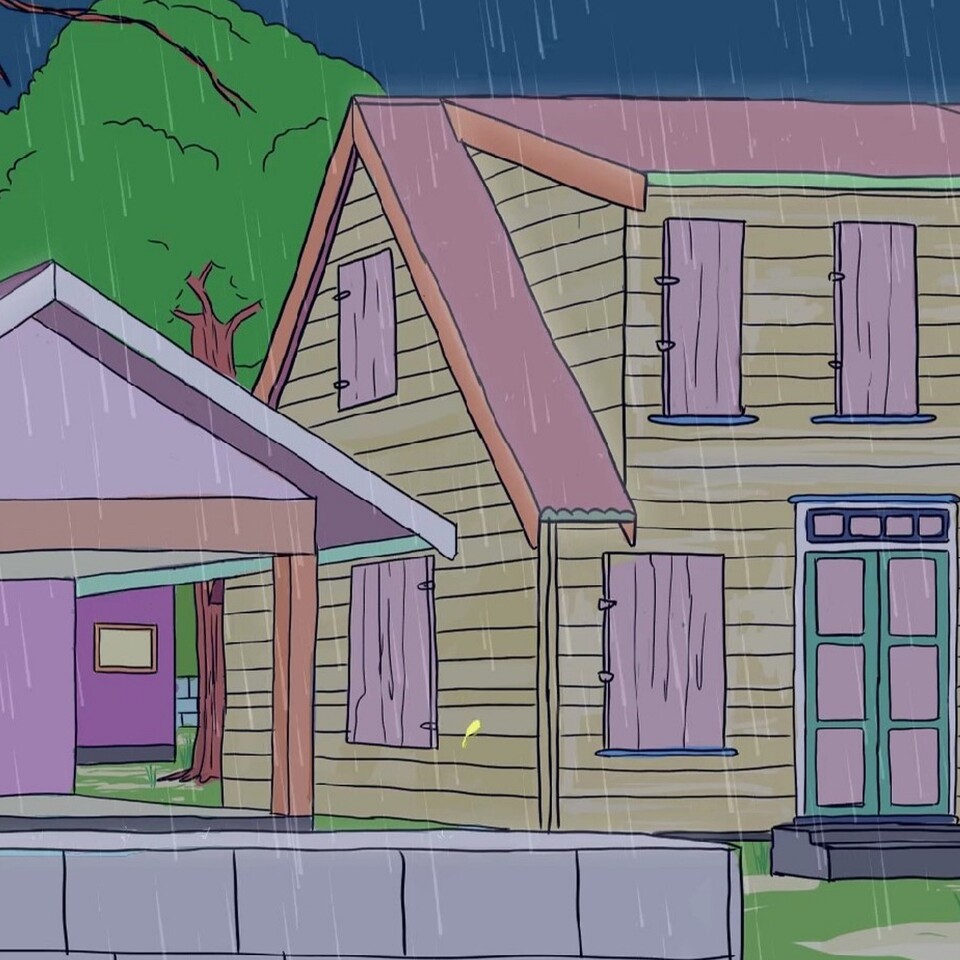
Ruben Cabenda’s animations examine the effect of the legacy of slavery on the people of Suriname, and the continuing colonial legacy that still informs everyday life there. He observes and reflects on ways that people in Suriname engage or try to disengage with their cultural heritage, and how this influences their idea of "Self". The politics of identity, globally as well as in Suriname, is central to his work and with his animations he aims at increasing viewers’ awareness of their own identity and background.
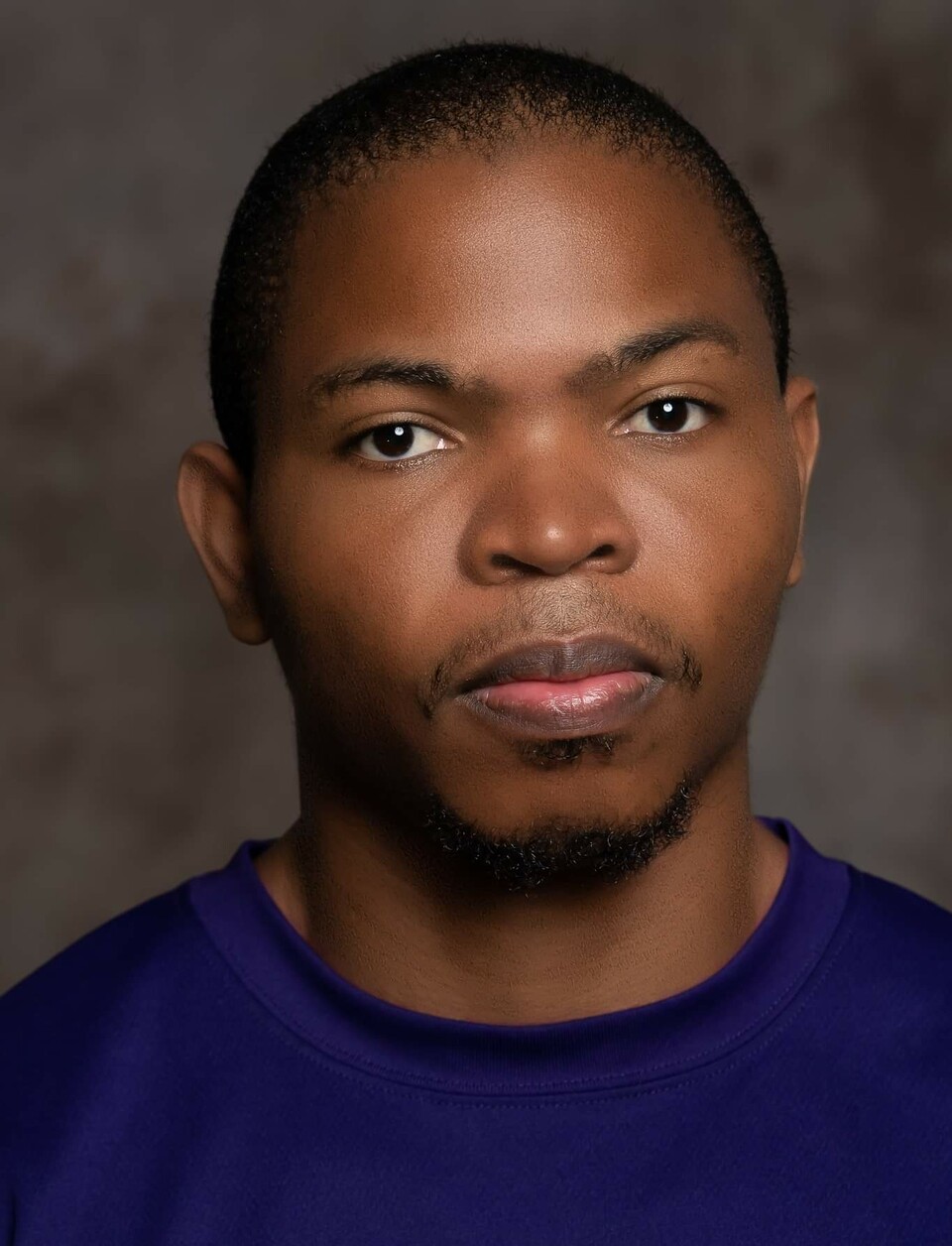
Ruben Cabenda (*1989 in Paramaribo) is based in Paramaribo. He graduated from the Nola Hatterman Art Academy in Paramaribo where he also taught until 2018, and from the Rietveld Academy in Amsterdam. Selected exhibitions include the National Gallery of Jamaica, Moengo Festival of Visual Arts, Nest Lowlands, Oude Kerk, Amstelkerk and Prinsenkwartier in Amsterdam, the Kunstvereniging Diepenheim and No Man's Art Pop-up in Teheran.
Upcoming artists in this series:
24.06.–08.07.2021
Ansuya Blom
01.07.–15.07.2021
Razia Barsatie
As part of the Städelschule Lecture program, Angela Lühning, Carl Haarnack, Oliver Hardt, and Willem de Rooij spoke about the historical imaginary of Suriname in November 2020.
Speakers:
Angela Lühning – Director Pierre Verger Foundation, Salvador da Bahia
Carl Haarnack – Curator, writer, and archivist, founder of Buku - Bibliotheca Surinamica, Amsterdam
Willem de Rooij – Artist and educator, Berlin
Moderated by Oliver Hardt – Filmmaker, Frankfurt am Main
Sind wir außerhalb der Ausstellungshalle noch ständig konfrontiert mit einer gewissen aufgewühlten Unruhe angesichts der globalen Pandemie, so tritt uns innerhalb der Ausstellung eine zuversichtliche, fast humoristische Stimmung entgegen. Dies könnte auch als Reaktion auf die letzten Monate gelesen werden, die alles andere als strikt, geplant oder greifbar waren. Der Blick in die Zukunft ist nicht nur der Absolvent*innenausstellung per se und der Natur eines Studienabschlusses inhärent, sondern auch in der optimistischen Atmosphäre der Arbeiten.
L’Esprit lautet der Titel der diesjährigen Absolvent*innenausstellung der Städelschule, die einen zuversichtlichen Blick in die Zukunft richtet. Mit Geist oder Verstand kann der französische Begriff übersetzt werden, der auch im Deutschen verwendet wird. Eine Person mit Esprit könnte auch mit den Adjektiven geistvoll oder gewitzt beschrieben werden – eines hat diese Begriffsgruppe allerdings gemeinsam: die Konnotation fällt positiv und schwungvoll aus, wenn die einhergehende Stimmung beschrieben werden müsste. Genauso wenig wie der Geist greifbar ist, ist auch der Esprit nicht materiell, nicht fassbar und verweist lediglich auf eine auratische Dynamik, mit der die Räume des Portikus durchschritten werden können.
22 Absolvent*innen aus allen Klassen der Städelschule stellen im Portikus ihre medial unterschiedlichen Werke aus: sowohl Malerei und Bildhauerei als auch Video- und performative Kunst ist ausgeglichen vertreten. Mag es auf den ersten Blick scheinen, als wären die Kunstwerke in dem nicht allzu großen Gebäude auf der Maininsel dicht gedrängt, so wird man schon im ersten Ausstellungsraum vom Gegenteil überzeugt. Wir fragen uns, ob wir vielleicht im Zuge der letzten Monate schlichtweg sensibler geworden sind, was den Umgang mit Raum betrifft? Auf den privaten Raum sind wir verstärkt verwiesen, wobei der öffentliche umsichtiger begangen wird.
Für L’Esprit werden im Portikus nicht nur die große Halle und das Mezzanin als Ausstellungsfläche benutzt, sondern auch der Shop, das Büro und der Garten. So stellten sich die Kurator*innen Sophie Buscher und Alke Heykes der Herausforderung, jeder Arbeit genug Raum zu geben. Das Ergebnis kann kaum in Frage gestellt werden – schnell ist man davon überzeugt, dass jedes Werk seinen eigenen Platz gefunden hat und sie dennoch miteinander in einen Dialog treten können. Wir überlegen uns, ob sich das auf die Graduierten und ihre Zeit an der Städelschule und in Frankfurt übertragen lässt?
Sinnbildlich wird diese Frage von Matt Welch beantwortet, der in seiner Skulptur Mechanical assimilation into a bad environment (die Verdauung) (2020) das Innere eines überdimensionierten Magens darstellt. Das Verdauungsorgan ist aus Glasfaser und Harz gefertigt und das Innere, das dort zum „Verdauen“ bereit liegt, besteht aus Geschirr und Essensresten. Auf einen zweiten Blick lassen sich die Teller und Tassen als Eigentum der Mensa der Städelschule identifizieren. Es stellt eben einen großen Schritt dar, die behütende Kunsthochschule zu verlassen, die den Künstler*innen Freiheit zum Experimentieren gibt, und sich nun auf eigenen Beinen einen Weg durch die Kunstwelt zu bahnen. Wie ein Fels in der Brandung lässt die Arbeit Interface (2020) vom Künstlerduo Timon und Melchior Grau den Portikus in regelmäßigen Sequenzen aufleuchten. Ihre Installation befindet sich auf dem Mezzanin und besteht aus drei kokonförmigen Objekten, die wie milchglasige Leuchten anmuten. Sie beschäftigen sich in ihrem Werk hauptsächlich mit den Grenzen zwischen Design und Kunst und der Verortung von Objekten und Subjekten innerhalb dessen. Die Arbeit, die für die Absolvent*innenausstellung entstanden ist, lässt dennoch weitere Interpretationsräume offen. Die Künstlerin Živa Drvarič spielt ebenfalls mit unseren Sehgewohnheiten und normativen Funktionalitäten von Objekten. Ihre Arbeiten befinden sich sowohl im Unter- als auch im Obergeschoss der Ausstellungshalle und präsentieren sich in einem neutralen, sehr klaren Gestus. Beispielsweise die Arbeit Emptiness (2020) erhebt zwei Glasflaschen ihrem Nutzen und lässt sie flach übereinander liegen. Vielleicht auch ein Blick ins vorerst Leere oder Ungewisse, allerdings aus einer optimistischen, experimentellen Perspektive? Vor einem Fenster im Untergeschoss hängt eine der drei gezeigten Werke des Künstlers Shaun Motsi. Die kleinformatigen, mit pastosem Farbauftrag angefertigten Malereien interessieren sich auf ihre Weise ebenfalls für Fragen nach Sichtbarkeit und Blickrichtungen. In der Arbeit Bad-Bar Blues(2020) ist eine hinter einer Pflanze versteckte Skulptur eines Schwarzen Saxophonspielers abgebildet, die ursprünglich als Dekorationsobjekt diente. Der Künstler hinterfragt die koloniale und exotisierende Geste, die in dem Objekt steht, ohne der Betrachter*in einen direkten Blick auf die Figur zu gewähren: so ist sie nur schemenhaft erkennbar. Die Videoinstallation von Yong Xiang Li und die Arbeiten von Johanna Odersky eröffnen in einer verspielt-romantischen Ästhetik einen Blick auf Beziehungen zwischen dem Menschen und seiner Innen- und Außenwelt. Steht bei Odersky vor allem die Zärtlichkeit ihrer Skulpturen im Mittelpunkt, eröffnet Xiang Li in seiner Adaption eines Romans eine utopische Welt, die Grenzen zwischen Spezies aufbricht. Dies lässt beide Arbeiten für die Besucher*innen in einen Dialog treten. Die Videoarbeit von Andrew Wagner vermag es mit ihrer linearen, humoristischen Narration ebenfalls, die Betrachter*innen in ihren Bann zu ziehen – ebenso wie die vielen weiteren Arbeiten in L’Esprit.
Der Portikus eröffnet uns mit der Ausstellung einen Gegenpol zur alltäglichen Unruhe. Die Absolvent*innenausstellung ermöglicht Einblicke in 22 verschiedene Praxen, die ihre selbstbewussten, individuellen Handschriften deutlich machen – so kann ihnen nur das Beste für ihren Weg hinaus aus dem sicheren Hafen der Kunsthochschule gewünscht werden.
Louisa Behr, BA Kunstgeschichte und Theater- und Medienwissenschaft, ist derzeit Studentin des Masterprogramms Curatorial Studies an der Hochschule für Bildende Künste – Städelschule und der Goethe Universität Frankfurt/Main.
Johanna Weiß, BA in Kulturwissenschaften und Kunstgeschichte, studiert seit Herbst 2019 im Master Curatorial Studies an der Hochschule für Bildende Künste – Städelschule und der Goethe Universität Frankfurt/Main.
“Tails” by Levi Easterbrooks
“Heads” by Janique Préjet Vigier

Moyra Davey, Hell Notes (still), 1990/2017.
Tails:
What other commodities lose is their form; but this form is what gives them them their exchange value, while their use value consists in overcoming this form, in consuming it. With money, on the other hand, its substance, its materiality, is itself its form, in which it represents wealth. If money appears as the general commodity in all places, so also does it in all times. It maintains itself as wealth at all times. Its specific durability. It is the treasure which neither rust nor moths eat up.1
But what if money was gobbled up and, later, shit out still intact? Its value would remain, despite its abject denigration in human intestinal tubing. Conversely, its social value might plummet upon touching and moving through shit, and would remain a trigger for revulsion long after it became clean again.
This passage from mouth to anus, or from hand to hand or purse to register in more conventional usage, does allow subtle abrasions and erosions to accrue over time despite the impression of durability given by a coin’s metallic substance. Contra Marx, a copper penny is metallic money that oxidizes and rusts. Its movement also necessitates wear and the slow build up of dirt, slime, or other excremental substances that coat both city streets and the grasping fingers that disaffectedly drop them in tip jars or flick them into wishing wells. Though a penny’s surface may shine under light, metallic glow is not equivalent to the cleanly or the sanitary despite the frigid institutional affect produced by silver doors and turnstiles. The warm reflected light of copper can obscure a pock-marked surface with gashes and crags where dirt can hide in the marks of faltering durability. Without a macro-zoom or bacterial culture test, this filth goes largely unnoticed beneath a reflective copper sheen despite commonplace warnings of money’s filth. Generally, these moralistic warnings backhandedly revile sex workers and panhandlers. They are sites where small money passes between those designated as socially and physically unclean.
A high school friend once stuck a penny into their anus, removed it, and threw it into a group of friends on a couch who scattered immediately in disgust. Besides the comic hyperbole this gesture made of the link between coin money and the anal, it also demonstrated why money maintains its value in the process of its fecal abjection and slow decomposition in exchange. “We value money because we value our shit.”2 Like feces, coin money is detachable from the human body, able to float untethered through channels of exchange and value transformation that exceed single persons. Its malleability and shifting nature are what is necessary to money for it to function as currency accepted in the purchase of commodities of different types. A few coins equals a trip to a train station toilet as well as a bar of chocolate or butter.
Moyra Davey, excerpt of Hell Notes, 1990/2017, Super-8 film with sound transferred to HD video, 26 min. 16 sec.
Heads:
Like every child who put pennies on their tongue, which is to say every child, I remember the taste of pennies; they tasted exactly like blood. This act was inspired by a kind of boredom, but also a tentative understanding of knowledge: to know something would be to take it all in. To take the coin like communion was a means of making something public private, a secret thing. Ultimately, I knew this was filthy, and felt ambivalently drawn to this newfound play, both impressed and disgusted with myself. Rolling coins around my mouth was a way to learn what I would spend years forgetting: money is the dirtiest thing. That doesn’t stop people from wanting it.
Whenever she learned, Moyra Davey hasn’t forgotten. Since the early 90s, the artist has steadily been making work related to the psychology of money and its Freudian transformative properties: shit-to-gold, a fairy-tale fantasy. Her 1990 video Hell Notes performs the correlation between money and desire. Recently digitized and presented for the first time since its 1991 screening at the Collective for Living Cinema, the video fragments the spatial relations between the construction of New York, the manual work of the unconscious, alongside discussions of money and shit, excess and expenditure.
Desire being a form of hunger, eating and excrement are never far from money. In her 2014 text on appetites and cravings, thinness and productivity, Walking with Nandita, Davey writes “I am trying to think “language or hunger,” but I inevitably supplant hunger with eating, not eating, and shitting, all of which differ from hunger.”3 Will rather than necessity grounds the vortex-like relationship between eating, hunger and transformation. Hell Notes concludes with the artist unwrapping pennies wrapped in lard and cooking them on a cast iron grill, fat gurgling around the coins. Circuitously, accidentally, serendipitously looping back on itself, as Davey’s work often does, her 2006 video Fifty Minutes begins with the artist considering her relation to the shifting contents of her fridge. “I get an unmistakable pleasure out of seeing the contents of the fridge diminish, out of seeing the spaces between the food items get larger and better defined […] That is my aim with the fridge: to be able to open it and see as much of its clean, white, empty walls as possible.”4
I’m convinced that somewhere in this work of emptying out there’s a link to decreation, the name the French philosopher and mystic Simone Weil gave to her project of undoing the self. “Decreation,” a neologism, is defined with most clarity in Gravity and Grace: "Decreation: to make something created pass into the uncreated. Destruction: to make something created pass into nothingness. A blameworthy substitute for decreation."5 This extended not only a philosophy, but to a daily bodily regime. Weil limited her food consumption to what she believed German-occupied French residents were then eating, and died of starvation. Language or hunger. “The body is a lever for salvation,” Weil wrote in Gravity and Grace. But in what way? What is the right way to use it?
Exhibition: Moyra Davey, Hell Notes
What might a minor history of Portikus told through video look like? Helke Bayrle’s Portikus Under Construction (1992-Present) gives this history its images, building an institutional memory and body of artworks out of what is almost always erased and obfuscated: work left outside of finalized and public-facing installations within the main gallery. Though the artworks in this screening program are by no means minor in and of themselves, they work outside of the limits of these artists’ previous contributions to the exhibitionary legacy of Portikus. Almost none of these films and videos have been shown within Portikus before, yet they provide a vehicle for reflection through their addition and deviation. In an effort to let these relations permeate the methods of this program, groupings of films and videos will together assert the value of lack, the uncertain, the secondary, the obscured, the forgotten, and the unclassifiable. Inspired by Bayrle, this project attempts to build a minor history of Portikus from these foggy positions.
Program:
19.07.2017
1. Filming Lack
-Martha Rosler, Secrets From the Street: No Disclosure (1980)
-Thirteen Black Cats, Corpse Cleaner (2016)
26.07.2017
2. Dara Friedman
-Dara Friedman, Dancer (2011)
Dancer was presented at Portikus in conjunction with the installation of segments of the video at the Frankfurt Airport on the occasion of Portikus XXX, curated by Fabian Schöneich and Franz Hempel.
02.08.2017
3. Procession/Parade
-Dieter Roth, Dot (1960) and Pop 1 (1957-1961)
-Josef Strau, Untitled (slide projection) (2012)
-Nina Könnemann, Pleasure Beach (2001)
-Mike Kelley, Bridge Visitor (Legend-Trip) (2004)
-Jimmie Durham, Smashing (2004)
09.08.2017
4. Sound Bleed
-Minouk Lim, New Town Ghost (2005)
-Basel Abbas & Ruanne Abou-Rahme, Collapse (2009)
-Lawrence Abu Hamdan, The All Hearing (2014)
-Dan Graham, Minor Threat (1983)
-Dan Graham & Glenn Branca, Performance and Stage-Set Utilizing Two-Way Mirror and Video Time Delay (1983)
16.08.2017
5. Non-work
-Frances Stark, Cat videos (1999-Present)
At Home 1999/1999 (w/ Stephen Prina’s The Achiever) (1999)
Thinking About Writing (w/ Joan Didion interview on public radio) (2001)
At My Desk (w/ Björk’s “Pluto”, circa 1997) (2002)
-Helke Bayrle, Portikus Under Construction (1992-Present)
Frances Stark (2008)
Morgan Fisher (2009)
-Morgan Fisher, Standard Gauge (1984)
A book of Mike Kelley’s writings bears the title Minor Histories: Statements, Conversations, Proposals.1
These texts are secondary works in that they did not feature as the central objects of display within his exhibitions. They are more of a textual infrastructure for art objects and videos. If Kelley’s sculptures and videos are given primacy within the space of exhibitions where the presence of text is reduced or rendered totally absent, then these texts could be said to be secondary (or made secondary) even if they might be integral to Kelley’s art making. Forced into the periphery of one’s consideration, that which is secondary in these ways is also minor. The minor is what is comparatively lesser in significance when held against a major event; an exhibition of artworks in this case. But one might reconsider the significance of major works through the framework laid by minor materials. Kelley’s Minor Histories inflects the perception of his major works through texts that affect his works in retrospect by providing a previously inaccessible supplement. This move – from major to minor, from macro to micro – is also characteristic of “microhistory” as a method of historical research. In a preface to the Italian edition of The Cheese and the Worms: The Cosmos of a Sixteenth-Century Miller (a founding work of what has come to be known as micro-history), the Italian scholar Carlo Ginzburg writes this:
In the past historians could be accused of wanting to know only about “the great deeds of kings,” but today this is certainly no longer true. More and more they are turning toward what their predecessors passed over in silence, discarded, or simply ignored. “Who built Thebes of the seven gates?” Bertold [sic] Brecht’s “literate worker” was already asking. The sources tell us nothing about these anonymous masons, but the question retains all its significance.2
This is the ethos of micro-history and also that of Minor Histories and this screening program, built up through the centralization of the minor and the secondary and the modes of historical re-assessment that they enable.
In continuing to use the terms “minor” and “secondary,” I do not mean for these nominative classifications to reassert a hierarchy of value that makes such materials as subservient to a main event, whatever that might be. This screening program intends to think through the value of working with/in the secondary or minor, making them the central subjects and methods of inquiry, despite the denigration of materials categorized as such. These terms are always relative anyway.
In the context of this screening series, galleried exhibitions at Portikus and the specific artworks they contain become the “main event.” That which rests outside of this (e.g. the artists’ other artworks, art programming that occurs elsewhere in the institution’s architecture, and presentations that sit out of line with the normal temporal constraints of the exhibition) becomes minor or secondary.
Helke Bayrle’s ongoing video project, Portikus Under Construction (1992-Present) operates through the staging of strange paradoxes in this schema. Her videos capture the pre-exhibition installations at Portikus, where scaffolding is erected and dismantled, artworks are crated in, and plans are carried through or changed to accommodate some unforeseen hiccup. Though these events and processes are foundational to the staging of exhibitions in the gallery, they are secondary to a finalized presentation of artworks. On Bayrle’s project, Kirsty Bell writes:
Helke Bayrle trains her eyes on peripheral details, on discreet gestures, on banal activities, in order to get at exactly these parts of the creative process: the things “taken for granted but not said.3
Helke Bayrle, Portikus Under Construction (Frances Stark), 2008.
But are these things really taken for granted because they are unquestionably banal and peripheral? What has pushed them away and into banality? The necessity of an action does not make it banal. There is still deviation within the supposedly normal. In most instances, pre-exhibition labor (the “banal” work in question) is obscured, despite its necessity, in a finalized product fit for a proper opening. I do not mean to imply that all art exhibitions seek to actively suppress the labor and laborers that construct them, but to note a rather typical lack of visibility given over to this (art?) work. Bayrle’s work provides a stage for what goes unseen to be given a new visibility, re-weaving these “secondary” actions into the primary artwork. The supposedly “banal” is not shrugged off or hidden. Its banality is challenged. The minor becomes the major.
With only one exception (Bayrle), these films and videos have never been shown in an exhibition at Portikus before; yet they have been assembled for a screening program to mark the 30th anniversary of the institution. It is an occasion that one might expect to be used to concretize an institutional history. What sort of history is constructed through an assembly of parts that bears only tangential relation to past programming? Might it be a minor one? It would be a bit overblown to present these films and videos within such a thematic frame if their non-exhibition was the only thing that marked them as minor or secondary.
However, it isn’t simply their non-inclusion from past programming that allows them to speak to and from these positions. Through formal methods that play with a tension between the hidden and the revealed, didactic notices of omission, and evasions of false clarity through excess or lack, these videos and films approach material from the bottom and the side as they re-appraise events made minor.
The first section of the screening program is titled Filming Lack. It gathers around the video Corpse Cleaner (2016), by the moving image collective Thirteen Black Cats.4 Corpse Cleaner gives visual traces to that which would otherwise go unseen: secret epistolary exchanges, the production of Hollywood films, and the atomic. All three are wound through each other with the atomic as their linchpin in a long take that snakes through a prop warehouse where the forgotten infrastructure of big-budget movie production resides. Thirteen Black Cats makes their video in the negative, using impressions and aftereffects to register the resistance of the atomic to clean and discrete images. Both form and content approach major events (i.e. the bombing of Hiroshima and Nagasaki by the United States military) through the peripheral and the minor.
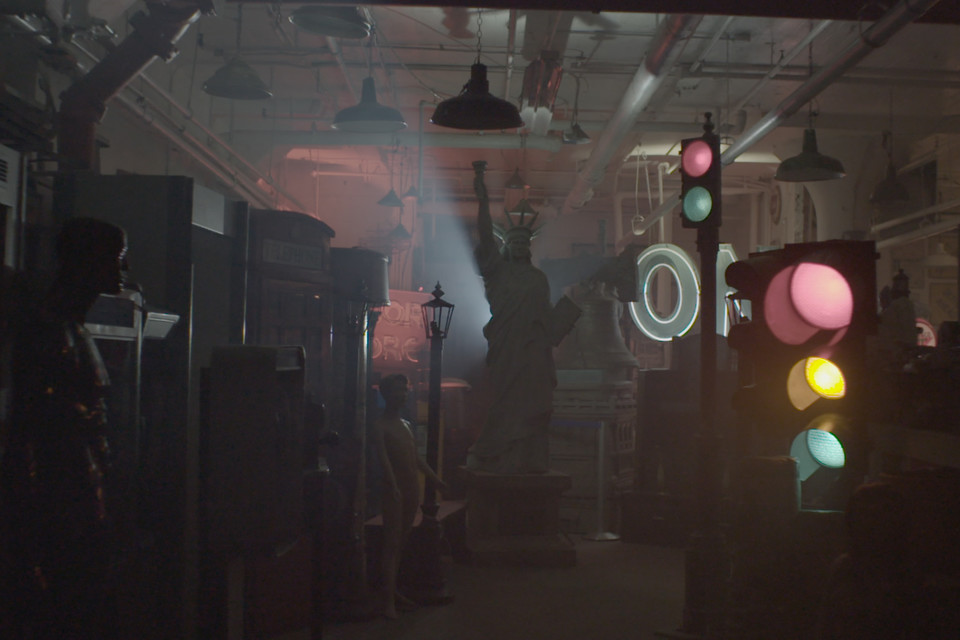
Thirteen Black Cats, Corpse Cleaner, 2016, Courtesy the artists.
The screening series concludes with Morgan Fisher’s film Standard Gauge (1984) as part of the event Non-work. Pulling his collection of 35mm film stock across a light box, Fisher comments on the content of each frame and the hidden histories of labor and production that result in the images we see burned into the film. His narration gives voice to that which is obscured in a finished Hollywood movie playing out on the silver screen, stripped of all its imperfections and messy origins. Lab technicians, projectionists, and anonymous women used to calibrate film color are all rewritten into a final product that typically relies on the erasure of any traces of their work.

Morgan Fisher, Standard Gauge, 1984, 16-mm, color, optical sound, 35', Courtesy Galerie Buchholz, Berlin/Cologne/New York.
Stretched between Standard Gauge and Corpse Cleaner, this summer screening series tries to keep faithful to its bookends and the drive towards a re-appraisal of the minor that Helke Bayrle plants at the core of an unfolding history of Portikus. On the occasion of the institution’s 30th anniversary, an event marked by city wide installations, events, and readings under the banner of Portikus XXX, the summer screening series will try to approach the marking of historical events from below and behind, from the secondary and the minor.
Click here for the complete Summer Screening Program (PDF)
Since the end of the nineteenth century, the Statue of Liberty has stood before the coast of New York guarding over freedom and its observance in the nation. The colossal statue was shipped in pieces from Europe to America. Both the Statue of Liberty and the written Constitution of the eighteenth century, which Lady Liberty holds in her hand, embody and symbolize a Western concept of freedom that remains valid today. This also encompasses the constitutionally safeguarded freedom of individuals to express their own opinions in words and images. In Germany, freedom of expression is anchored in Article 5 of the Basic Law. Nowadays more than ever, this is an essential right that demands protection, but is constantly being stretched to its limits.
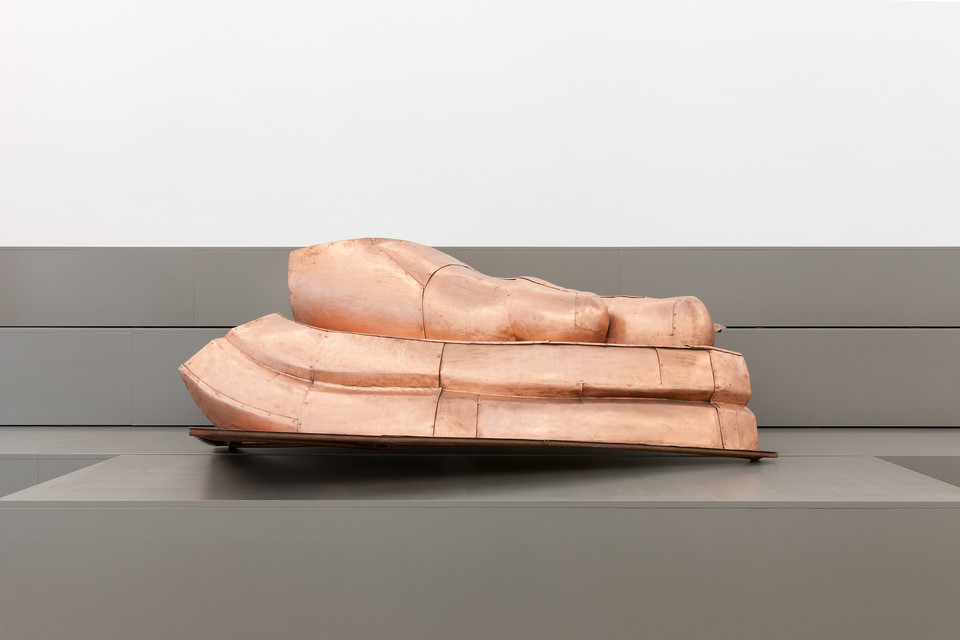
Danh Vo, WE THE PEOPLE, 2011, Copper, 223 × 155 × 107 cm, Kadist collection, Photo: Helena Schlichting
Peaceful debate and dialogue between people with opposing opinions is an important feature of a democratic society. In recent years, however, there are political tendencies that noticeably restrict freedom of expression. This is happening in European democracies, but political voices that speak up against tolerant societies are growing stronger all over the world. For example, there are clear restrictions to press freedom in Turkey. Government-critical Turkish journalists are being imprisoned and freedom of expression seems no longer possible.
Yet open and critical dialogue and tolerance towards contrary opinions are essential for our coexistence. This dialogue can be initiated and held by the media or with the means of art. Danh Vo, who fled with his family at the age of four from Vietnam to Denmark, shows parts of the Statue of Liberty in his work WE THE PEOPLE.
Danh Vo reconstructs individual elements of the statue, which was once shipped in individual parts, and never shows them as a whole, but in fragments. The artist produced 225 elements of copper in an exact replica of the Statue of Liberty. The monumental sculpture is thereby abstracted; the symbol for which she stands seems broken.
Danh Vo’s assessment of the Statue of Liberty and its significance takes place on different levels in his WE THE PEOPLE. On the one hand, the artist takes up one of the symbols of freedom directly; on the other hand, the title of the work refers to the first three words of the preamble of the American Constitution from the 18th century. With WE THE PEOPLE, Danh Vo reflects in a simple manner on the concept of freedom and, with the unassembled details, shows how fragile freedom is and that although we regard it as self-evident, it must be protected and preserved.
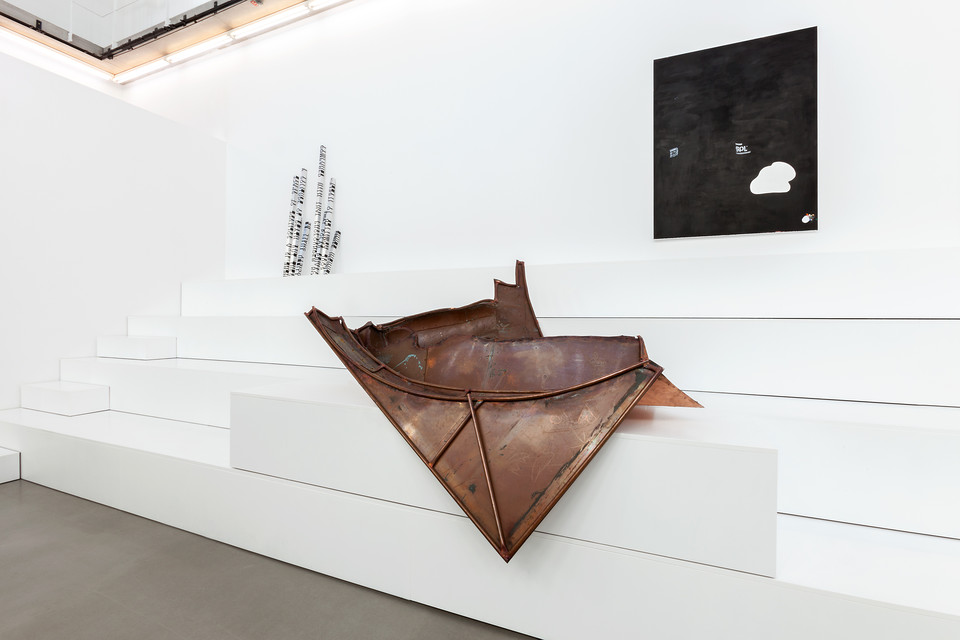
Danh Vo, WE THE PEOPLE, 2011, Copper, 223 × 155 × 107 cm, Kadist collection, Photo: Helena Schlichting
Freedom of expression, freedom of the press and freedom of assembly are among the fundamental pillars of a democratic society. In her book Notes toward a performative theory of assembly, the American philosopher Judith Butler writes that freedom of assembly is a decisive feature of a nation’s sovereignty.1 According to the Butler, the right to assemble freely as a group is a basic prerequisite for politics that must not be restricted by governments. 2
The people must have the right to assemble freely at any time. The phrase “We the people,” both the title of Danh Vo’s work as well as the introductory words of the U.S. Constitution, is repeatedly taken up by assembled groups. However, according to Judith Butler an assembled group claiming to be “We the people” cannot exist because it can only represent a certain section of a population. Likewise, the parts of Danh Vo’s WE THE PEOPLE, which are never put together to form a whole but are presented only as individual pieces in exhibitions, stand for a larger whole and at the same time for the many different people and groups in our society.
On the occasion of Amy Sillman’s exhibition the ALL-OVER at Portikus Bernard Vienat talks in the following interview about the artists early years and her artistic practice.
BERNARD VIENAT: You started your career around the 1970s, at the same time that John Baldessari burned all his paintings. So it was certainly a time of hostility towards the medium. What was your survival strategy?
AMY SILLMAN: I didn’t have a “career” in the 1970’s, I got out of school in 1979. And the idea of a professional “career” was not what how were thinking back then. But for survival I had a day job: in the 80’s I worked at a couple of magazines, doing what was called “paste ups” back then, we fixed the pictures and type in place with wax. I wasn’t a punk with a Mohawk, but I was certainly spirited in a punk way. I think that underneath a lot of what I was doing was a “fuck you” attitude. Like, “I’m not supposed to paint anymore? Fuck you!” “I’m supposed to try to be famous? Fuck you!” So I would say I had a strong sense of negation. That was the ethos of the time, and I persisted in painting, as a pleasurable reversal to what we were supposed to do.
VIENAT: How did you first come to the idea of wanting to be an artist? And moreover to paint?
SILLMAN: I came to New York, not to do art, but to study Japanese at NYU. I had been on a wild trip to Japan, and was interested in studying a foreign language, one that was utterly undecipherable to most people I knew. I was interested in the idea that I could write in a code. So I studied Japanese, but I took a drawing class on the side, from an “action painter” teacher who literally played jazz in the classroom and taught us to look at a nude but draw it with turpentine-soaked rags. In this drawing class, I suddenly thought: “Oh my god, this is another kind of code language!” It wasn’t what I was thinking originally because I didn’t have any role models to be able to imagine that artist was something I could do. So in a weird way, I backed into it via the brush.
VIENAT: What other kind of teaching were you exposed to afterwards?
SILLMAN: Well, after the action painter, it was all these 1970s types: feminists, conceptual artists, filmmakers and post-studio people. I would say 95% of my friends had abandoned making paintings because of the bad politics that painting seemed to embody, the neo-expressionist critique was in full swing. All my friends were in class with either Joseph Kosuth or Hans Haacke. So it was really not cool to be painting, but I guess I was always interested in doing it in spite of itself.
VIENAT: You started your career after really important theorists had spoken about painting and the way to perceive it. How do you react for instance to Greenberg’s theories? Speaking about a punk attitude, didn’t you think: My father said so, so I’ll go against it?
SILLMAN: But Greenberg wasn’t my father! If anything he was more like a grandfather. No one I knew read Greenberg then, and I didn’t really understand the politics of art history. I was curious about his article on kitsch and the avant-garde. But we did not read much theory of painting back in the 70s. Painting was already dead on arrival. I described it once to a friend as like squatting an abandoned building. I got all my ideas from elsewhere: dance, performance, experimental film, and writing. I was not able to work within the logic of painting, neither from OCTOBER nor Greenberg
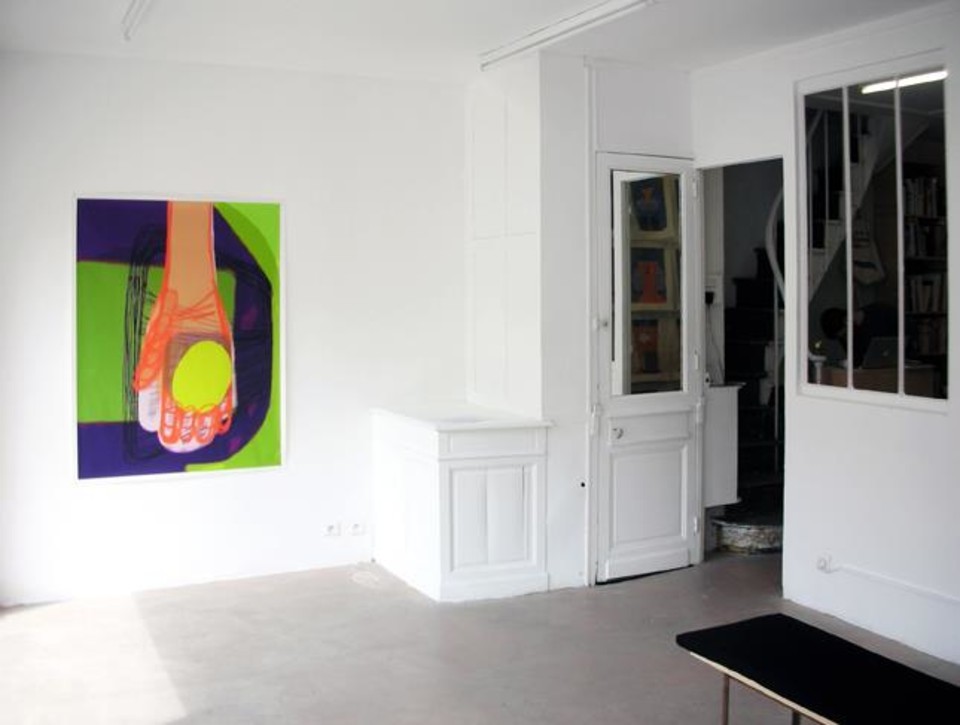
Amy Sillman, Draft of a Voice-over for Split Screen Video Loop, in collaboration with Lisa Robertson, Installation view, 12.05.–28.06.2012, castillo/corrales, Paris
VIENAT: How did you start to work digitally?
SILLMAN: I got an iPhone, and I finally had a camera to work with. Meanwhile, I was invited to do a collaboration with a poet named Charles Bernstein in NYC. I know a lot of poets and I’m interested in expanded language. We worked by sending emails back and forth, me sending drawings from iPhone, him sending me new edits of a poem to illustrate, each one effecting the other’s outcome. After that, I was invited to do a project at Castillo Corrales in Paris, and I suggested doing another animation with a poet friend of theirs, Lisa Robertson.
VIENAT: Are you still researching in this direction or was it just a phase of your life?
SILLMAN: I’m still doing it. I love painting as an act-- but finally I have realized that in some ways I think like a conceptual artist, but one who works physically and a bit irrationally. I am deploying language and space as much I am painting in the rectangle. So in some ways, just getting an iPhone really opened up my whole work process - I mean, that was very liberating.
VIENAT: The New York psychoanalyst David Lichtenstein, writing about your works and the idea of “origin,” speaks about the psychoanalytical moment when the object emerges. Referring to Lacan: When you are painting, are you in this state of anxiety? What is your painting mood?
SILLMAN: It’s half enthusiasm and excitement and a kind of openness to what might emerge, and the other half dread. It’s literally both. I read recently that having a full, precise spectrum of moods is sometimes referred to as “granular” in psychoanalysis. I love that word. This spectrum of mood is visible, for example, in the spectrum of my palette. I use a mixture of “readymade” color, coming right from the tube, very bright and sharp and clear, like cadmium red or citron yellow, unmixed, in combination with these sludgy, muddy colors that are scraped off from all those under-layers of paintings that didn’t work. Those colors are literally draining in a bucket for months at a time. It gets dirty and shitty and sludgy… and I realized that it’s the color of shadow, dirt, dust, and death. I love palettes that are a combination of dirty, anxious colors, not at all nice, used with these fresh, gaudy, concentrated store-bought colors. I think a psychoanalyst would say my painting moods are granular!
VIENAT: If we look at your painting as an entire psychoanalytical process, is it an empirical process in which you construct archetypal elements?
SILLMAN: That sounds very nice, but has nothing to do with what I’m doing. Psychoanalyzes are not so clean. Painting could perhaps be called empirical in the sense of being experience-driven? But certainly not leading to archetypes. The psychological landscape that I’m working on is absurd and packed with conflict and irresolvable eruptions of something that you can’t name. It does not end in cognition or meaning, necessarily. And is not about universal truth.
VIENAT: There is a lot of interior space in your paintings. Is it more an environmental observation of your own studio or more an introspective process?
SILLMAN: The studio is this horrible room that we stay in all day long, a lot of the time alone, for those of us who have a studio practice, but we also all look carefully out at the world, and what I see is translated into memory. So I think that the space of an image is indeed a kind of space, rather than a “depiction.” Images go from out to in, AND in to out, maybe my idea of interiority is balanced between these. The studio has been critiqued as a form of bourgeois interiority, but of course there is no more interiority in the studio than there is while listening to the radio. The world comes in and out of all of us.
VIENAT: But what does it mean for you to understand abstraction?
SILLMAN: I speak that language. I go to the museum and am not confused by shape, color, line, transparency, scale, opacity, layer, mark, gesture, and edge. I know how to get in that car and ride around.
VIENAT: What then would be your criteria to judge an abstract painting?
SILLMAN: Abstraction is the “shape of content,” a form for releasing meaning, or building meaning. Form should not be decorative or imitative. So to me, abstraction is a way to make up a hybrid language, to speak in code, or in a strange voice. So my criteria would partly be: does this abstraction add to the strangeness, the surprise, the feeling of curiosity, enthusiasm, freedom, a break in the oppressive regime of what is already set? Does it feel like there is a person talking, a personal-ness, and a kind of invention in it? Looseness, rigor, freedom, necessity to get away from whatever is already plotted out? If so I would say it was a good use of abstraction.
VIENAT: A trend with contemporary artists like a few on view at the current Berlin biennale seem to mirror our present time rather than develop any kind of subtlety. What role does poetry play in your work?
SILLMAN: Poetry is really important to me, but I like poetry that acts weird rather than useful. It’s a communication system that doesn’t deliver the goods exactly-- instead it sort of illuminates some outer edge, playing around even with the actual vocabulary, or timing, to make it more precise, wittier, more perverse, more intense than usual. That’s similar to what you would hope for if you are thinking of trying to make a “better” painting.
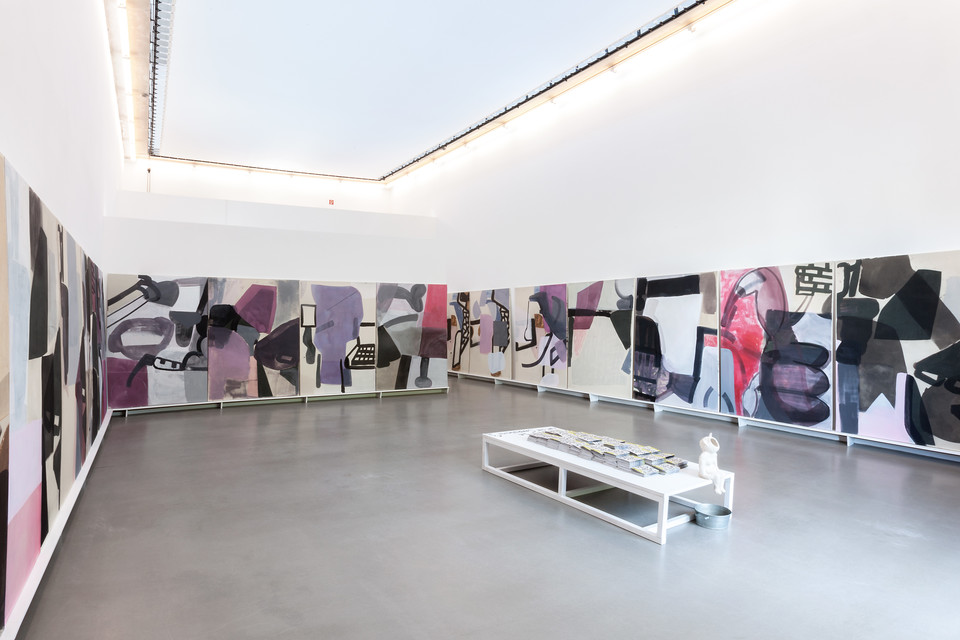
Amy Sillman, the ALL-OVER, Installation view, 02.07.–04.09.2016, Portikus, Frankfurt/Main. Photo: Helena Schlichting. Courtesy: Portikus, Frankfurt/Main.
VIENAT: So what are you doing for Portikus?
SILLMAN: For Portikus, I basically made an art show that is kind of made out of these looping mechanisms: first, when you come in, there’s an animation that loops every one minute, with these little cartoon figures doing sort of absurd things, a straightforward narrative. Then you enter a gigantic room of printed and painted panels, which loop all the way around the room like a frieze. But it’s clearly made from an abstract painting language, not like the narrative in the animation. But the idea is about the viewer and the “machine” of movement—the animation moves itself but in the painting room, you move through it, and past them. Then the final little event is the zine and this little ceramic figure I made as a kind of coin box: you throw a coin into the mouth of the figure and the coin comes out its ass, through a hole in the table, and you take the zine, and this image “loops back to the animation in the front. It’s a complex machinery that I’m attempting. The panels themselves are inkjet-printed canvasses with some painting on top. They are based on drawings I did, which make it hard to say what is machine-made and what is handmade. I also scaled back on the color of my usual paintings in order to emphasize repetition. And the prints are of my usual drawings but increased in scale to the canvas size. I wanted to absolutely fill the room, but suppress some of the other usual painting options.
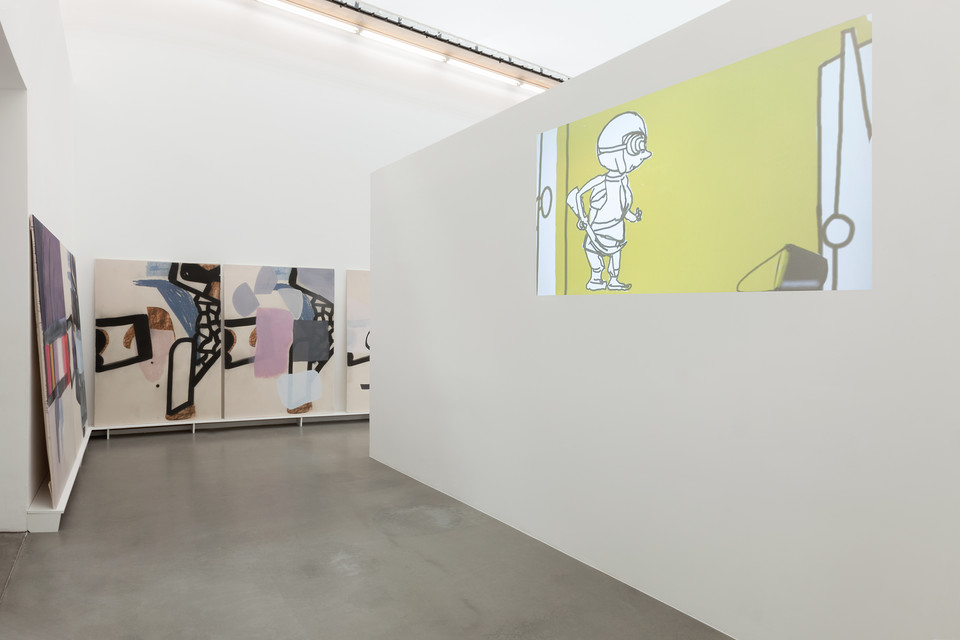
Amy Sillman, the ALL-OVER, Installation view, 02.07.–04.09.2016, Portikus, Frankfurt/Main. Photo: Helena Schlichting. Courtesy: Portikus, Frankfurt/Main.
VIENAT: What about the animation?
SILLMAN: The animation is there to provide a kind of joke on the classical painting situation of a “figure/ground.” In painting terms, figure/ground is term for making a distinction between the whatever is the “subject” versus the background. “Figure” can even be used for the abstract stroke, it doesn’t have to be an actual figure, but here I wanted to literalize the idea of figure as a kind of joke. It struck me that all the paintings are abstract ground, basically like a wallpaper, so I thought I would add a real figure. But who? I had no story until my class took an ill-fated field trip to Switzerland, which ended in a series of small but comical disasters, and I realized, bang, there was my story. I made a kind of Rube Goldberg machine, a wheel of misfortune, which you have to sort of get on to understand!
Bernard Vienat currently studies curatorial studies, a master’s programme at the Staatliche Hochschule für Bildende Künste – Städelschule and Goethe University Frankfurt. He studied art history and philosophy at the University of Bern and at Freie Universität Berlin. He is founder of the art association art-werk in Geneva and manages the exchange project with Mexico DF Vorticidad.
A Narrative for the Body: Shahryar Nashat’s Present Sore
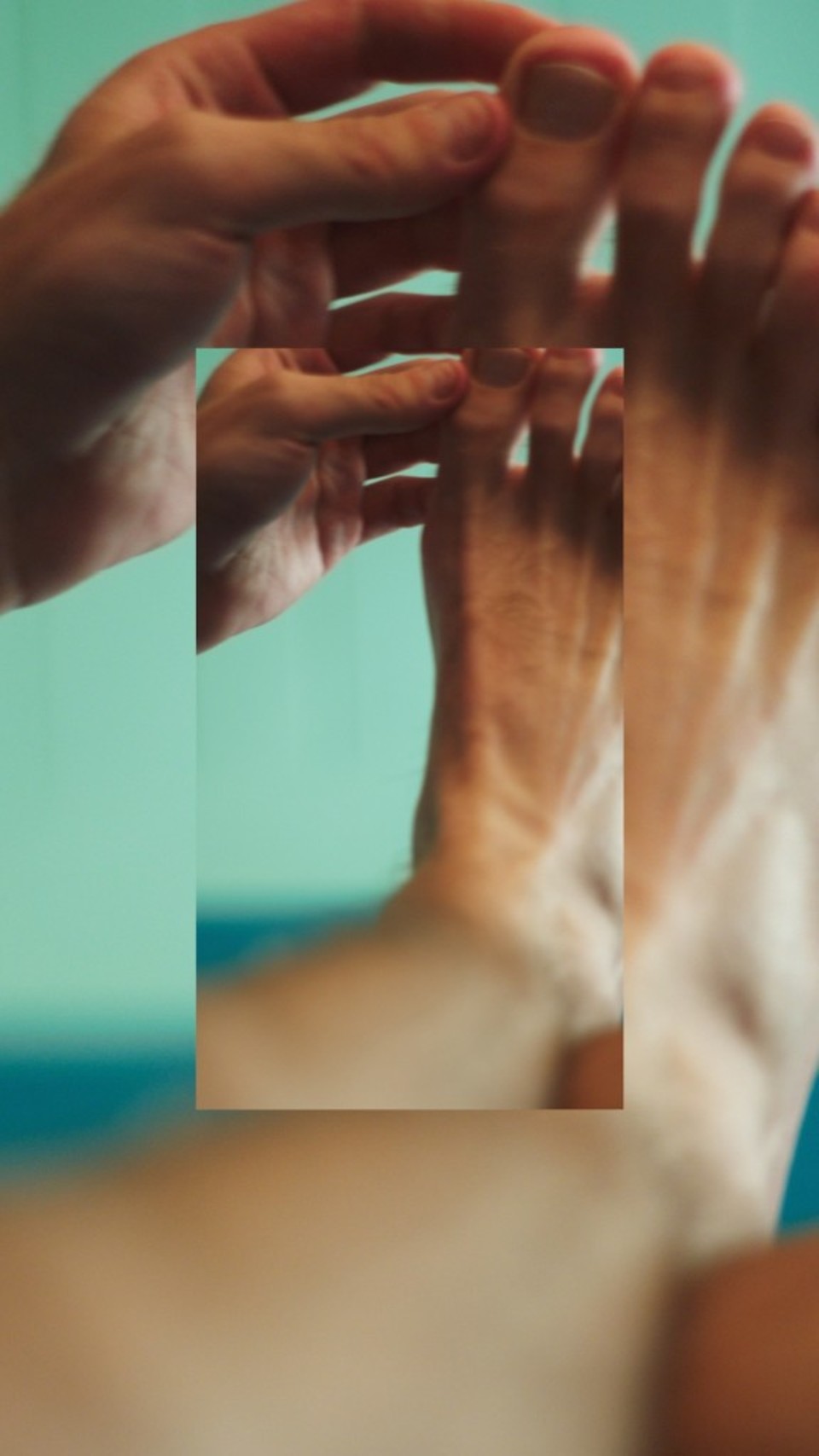
Shahryar Nashat, Present Sore, 2016, video.
Artist Shahryar Nashat recently made Present Sore (2016), a composite portrait of the 21st-century body mediated by substances both organic and fabricated. In this new interview, Walker Bentson Moving Image Scholar Isla Leaver-Yap and Portikus curator Fabian Schöneich ask Nashat what drives his work—the politics of the body, its digital and physical augmentations, and its obsolescence.
Present Sore is presented on the Walker Channel from April 8 through May 31, 2016, as part of the Walker’s Moving Image Commissions. It is also featured in the Portikus exhibition Model Malady (April 23–June 19, 2016).
FABIAN SCHÖNEICH: Your most recent video, Present Sore, streams online via the Walker Channel and is installed in your gallery exhibition at Portikus. The format of this work is vertical: 9:16 instead of 16:9. It reminds me of the way people shoot video on their phone. Can you tell us what led to your decision of rotating your camera?
SHAHRYAR NASHAT: It’s true—smartphones have generalized the use of vertical framing. When I came to Portikus for an initial site visit and saw the gallery, I immediately saw how a 16:9 format video would be crushed by the height of the space. On top of that, I had always struggled with the horizontal format of 16:9 because you can never fill the frame when you want to capture a limb vertically. Present Sore is an oblique high-definition figure study of a composite body. The video’s upward progression (from feet to head) necessitated a vertical format.
SCHÖNEICH: Your work often questions and highlights the homogeneity between object and body. Abstract but clean objects are representational of the body, or else the body is representational for the object or the sculpture. In Present Sore, we see the human body not as a whole, only in detail—like a close-up of the knee or the hand.
ISLA LEAVER-YAP: Totally. Present Sore’s focus on detail fragments the subject, showing the mechanical moving “parts” of the body and isolating their function as tools. This fragmentation implicates a wider cultural landscape that has preferences for certain types of bodies, pointing as well to an economic landscape that obfuscates the parts of labor—both human and inhuman. Shahryar, I was wondering if you could speak to this “composite” quality you referred to earlier, and talk about the bodies, types, and genders you choose as your subjects?
NASHAT: Mainstream cultural representation of the human body privileges a homogeneous and wholesome body. I have always searched to represent bodies that sit outside those traditional ideals. The bodies I’m interested in might have diverse motor functions, cosmetic interventions, and applications. Like the injured elbow in Hustle in Hand (2014, video, 19 minutes). That’s why I like wounds or prosthetics. They signal injury and, therefore, anomaly. Limbs are similarly interesting. Framed away from the rest of the body, they question it, while also allowing some psychological distance from the notion of persona. For me, this is where you open the door for desire and projection.
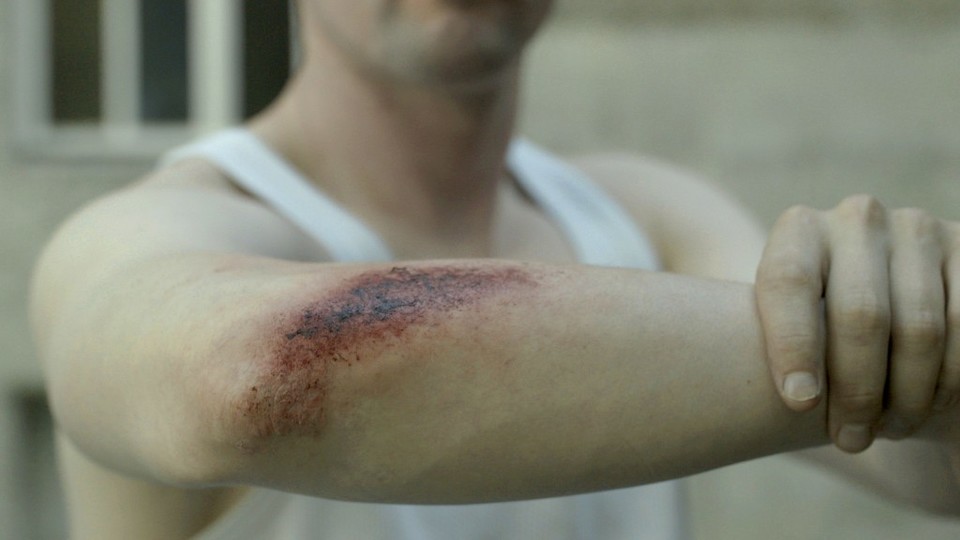
Shahryar Nashat, Hustle in Hand, 2014, HD video, 10 minutes
Courtesy Rodeo, London; Silberkuppe, Berlin.
LEAVER-YAP: What do you mean by “desire” and “projection”? Both terms seem particularly resonant with how your work intersects with ideas of queerness. Your work blurs lines between fetish and tool and often trades in promiscuous formal relations, by which I mean things that resemble or “stand in” for that which they represent but also complicate that representation: a vertical format as a body, a Paul Thek artwork of a rotting piece of flesh for a psychic human wound, or an artificial prosthesis as a 21st-century ideal tool for the body.
NASHAT: I think art has always operated with the mechanics of desire and projection. Not only as an incentive for an artist to make work but the way the work is appreciated and consumed by the audience. The “stand-in” is a powerful strategy because it works through deception, which is another powerful ingredient. It all sounds very theoretical, but what I guess I am trying to say is that the frustration of meaning is central to any work because it creates desire. The tools I use in my work—framing, editing, a geometric object next to the close-up of a wound—participate in that enterprise.
SCHÖNEICH: Does imperfection define desire for you?
NASHAT: “Perfect” versus “imperfect” sounds like “good” versus “bad.” I don’t think it’s about morals. When I watch a movie or TV show, for example, the interesting characters are not necessarily the ones that have personality flaws or act inconsistently. I don’t care whether they’re good or bad people. But I do like it when there is a perversion in them, some kind of inconsistency. Incoherency creates a compelling and complex character. That’s desire.
SCHÖNEICH: How important is gesture in this work? I’m thinking especially of the sections of Present Sore where a lip is pulled or an ear is touched or plugged.
NASHAT: Capturing a body that is inanimate or frozen in action made sense in the 1990s when photography was concerned with creating tableaux vivants. But for me, the body in action is more interesting because it’s not just “on display” for the camera to get the best shot. It competes with the camera and forces it to find different strategies. It’s less mannered than a pose perhaps, and the formal and aesthetic gesture is not coming from what you look at but the way you look at it. When you invest the body with actions and gestures, you write a narrative for the body. You give it agency. I must say, though, that there are very active ways for the body to be passive—like a smoker or a sleeper, which are equally powerful images.
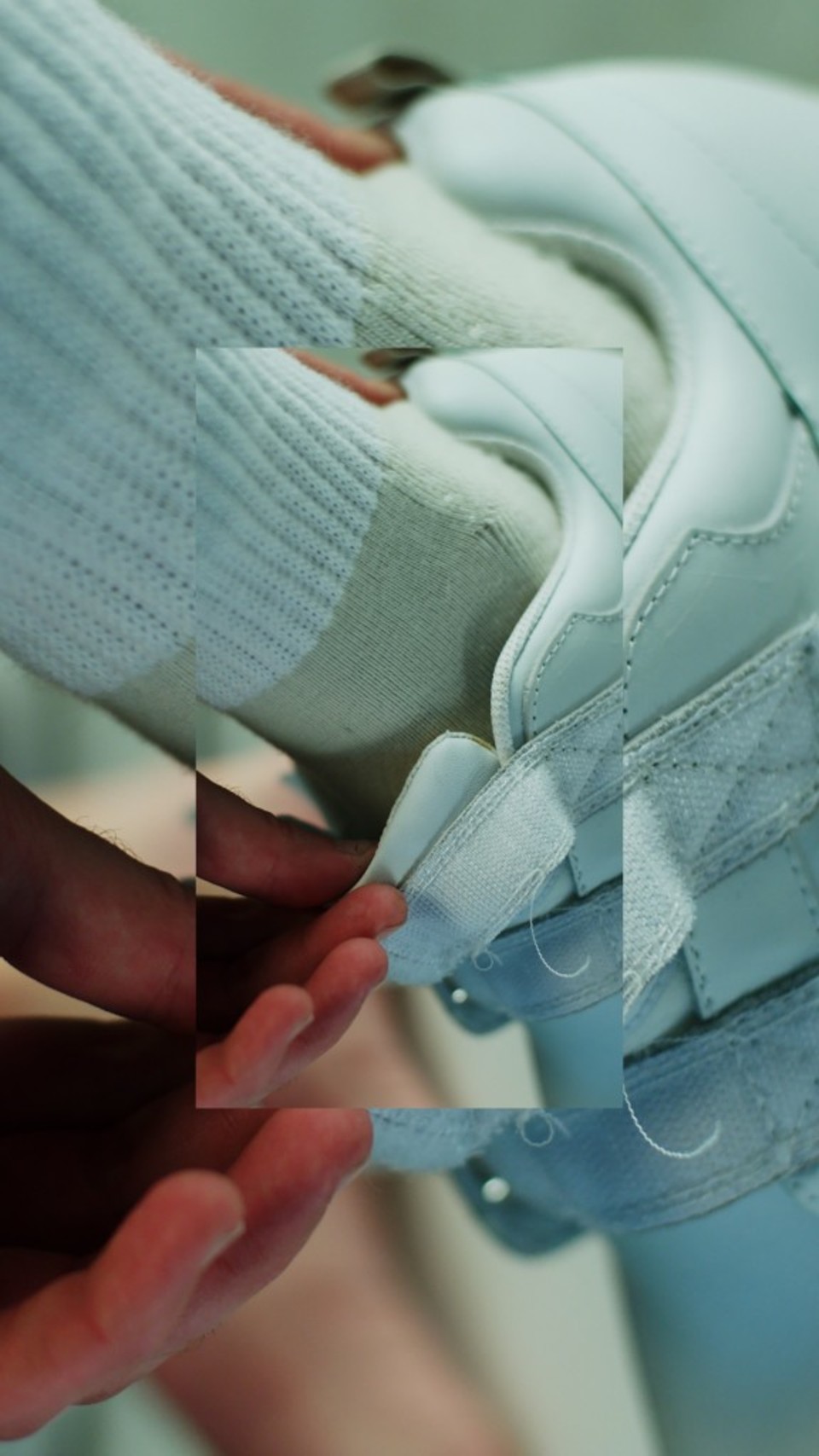
Shahryar Nashat, Present Sore, 2016, video.
SCHÖNEICH: How did you film Present Sore? Tell us about the overlayering of images throughout the video.
NASHAT: The layering was an accident that I ended up keeping. I have been relying on software bugs and my own technical mistakes a lot lately.
LEAVER-YAP: Your work is so carefully choreographed and edited that it’s really interesting to hear about the importance of accident within your practice. Accident seems to me to be such a human quality, while being attentive to accident is something very digital—a quality of being watched or surveilled. I was struck by something Moyra Davey said to me about shooting video last year. Moyra shoots mostly analogue photographs, and now she shoots digital video. She told me she liked how “video hangs onto accident” in a way that is particular to the form. The digital captures physical vulnerabilities as much as it can augment or erase those very qualities in post-production. I was wondering if you could speak to the notion of error, mistake, and accident in your work a bit more?
NASHAT: In Hustle in Hand, my editing program was interrupting the playback of my video. One frame from a completely different section of the video would intrude into the clips. I ended up keeping this glitch because it breaks the linear narrative of the timeline—it’s like a preview of the footage that is yet to come. In Present Sore, meanwhile, I brought the wrong resolution into the project, but then I decided to keep it as it complicates the view of the body. Capturing body limbs is such an ordinary image to do. You need these kinds of tricks to ramp up attention. Technological accidents are what make the work more vulnerable. If you keep them, you can of course normalize them, but I find it useful for them to remain as anomalies that serve the work.
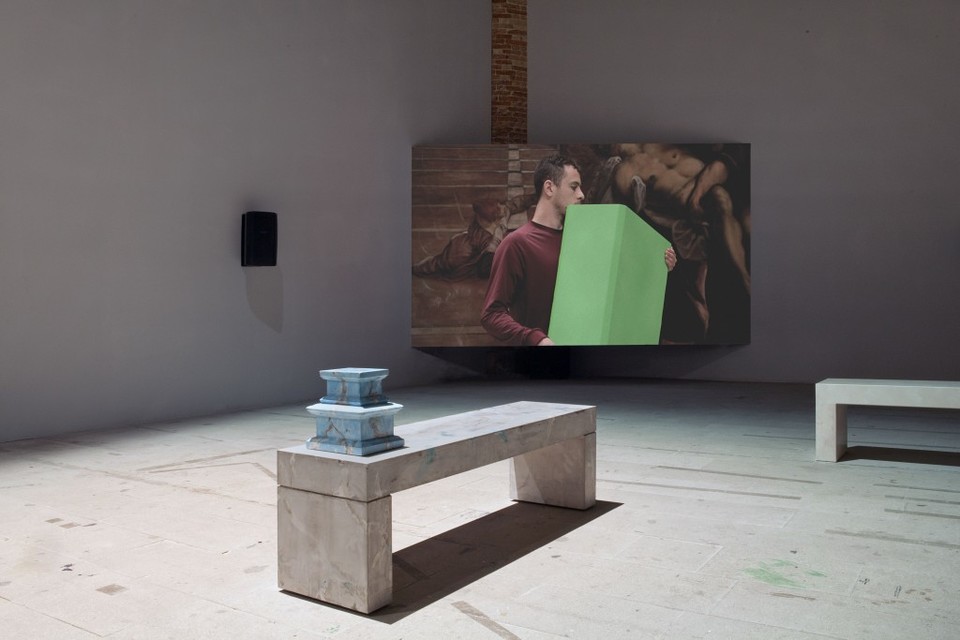
Shahryar Nashat, Factor Green, installation view, 54th International Venice Biennial, 2011
Courtesy Rodeo, London; Silberkuppe, Berlin. Photo: Gaëtan Malaparte.
SCHÖNEICH: Already in early works, like in Factor Green (2011), or in your exhibition at the Folkwang Museum in Essen, you investigated the meaning and the visual presence of the pedestal or plinth itself. At Portikus and the forthcoming Walker exhibition Question the Wall Itself, you present a series of sculptures—pedestal blocks—resting on chairs that you say are designed for them to “relax.”
NASHAT: Yes, the pedestal is to the artwork what the foot is to the body. It provides the support that allows the artwork to stand and be on display. It’s like a pair of crutches. Present Sore toys with the fact that high-definition imagery being now at the service of “supporting” the body. It makes the pedestal obsolete. Chômage technique is a French term used when, say, a factory lays off its workers but maintains their salary. In a world of bodies shown in pixels, pedestals are a kind of “chômage technique”—they have no one to support anymore. In my installation, they can retire and enjoy the viewing of the bodies they once would have supported. The pedestal has always been an underdog, or in the service of something else. But in this configuration it is as if it has won the lottery and is off to retire in Florida.
People are standing in the shade of a petrol station. Dark smoke is rising. A young man waves a slingshot in a circle over his head. It is 1:45 pm on May 15, 2014 in the West Bank. A male wearing a backpack enters the picture. A few seconds later, a bullet hits him from behind. He falls to the ground. Helpers rush to his aid. It is 2:58 pm on May 15, 2014. More gray smoke is billowing upwards. From the right, a man enters the picture. He is shot in the chest and falls to the ground. People rush to help him. This footage by a security camera shows the killings of Nadim Siam Nawara, age 17, and Mohammad Mahmud Odeh Abu Daher, age 16, which were committed during the demonstrations on Nakba Day near Ofer Israeli military prison by Ramallah.
“The images captured on video show unlawful killings where neither child presented a direct and immediate threat to life at the time of their shooting. These acts by Israeli soldiers may amount to war crimes, and the Israeli authorities must conduct serious, impartial, and thorough investigations to hold the perpetrators accountable for their crimes,” Rifat Kassis, the spokesperson of the human rights organization Defence for Children International, declared soon thereafter to the public. In addition to the surveillance videos, there are also audio recordings taken by a television crew at the scene of the crime that will be used as evidence in an audio-ballistic analysis to clarify how and from what direction the two unarmed Palestinian teens were fatally shot. The key question here is whether the soldiers and border police officers fired live ammunition or rubber bullets, as the Israeli security forces stated in their own defense. An investigation now aims to solve the murders.
Two years later, artist Lawrence Abu Hamdan develops Rubber Coated Steel, an extensive video installation at Portikus that reconstructs the events and makes the sounds recorded at the crime scene visible as images. His mixed media work consists of visualized frequency bands of the tracks and found video materials which, arranged within the architecture of a shooting range, also document the course of events. However, before the video work Rubber Coated Steel was created, Hamdan’s findings and the reports drawn up together with the London Institute of Forensic Architecture were used as legal evidence against the Israeli soldiers to prove their violation of the arms agreement with the United States before Congress in Washington, D.C.
The interpretative force of the auditory material in this particular case can also be found in the significance Hannah Arendt ascribed to listening and seeing for the process of comprehension. In 1961, she wanted to personally witness the trial of SS Obersturmbannführer Adolf Eichmann before the Jerusalem district court and thus proposed to The New Yorker that she serves as an observer of the court proceedings. She justified this decision in a letter to her former teacher Karl Jaspers, writing, “I would never be able to forgive myself if I didn’t go and look at this walking disaster face to face in all his bizarre vacuousness, without the mediation of the printed word. Don’t forget how early I left Germany and how little of all this I really experienced directly.”1 In Jerusalem, Arendt was prepared to encounter a vicious monster. During the trial, however, her expectations were not met, instead she experienced a person who followed and issued instructions from behind his desk and seemed barely conscious of the consequences of his actions. Therefore, in her final report Arendt developed the mental figure of the “banality of evil” 2 , for which she was criticized sharply from many sides, but which today largely influences our understanding of the brutality of the crimes committed against the Jews.
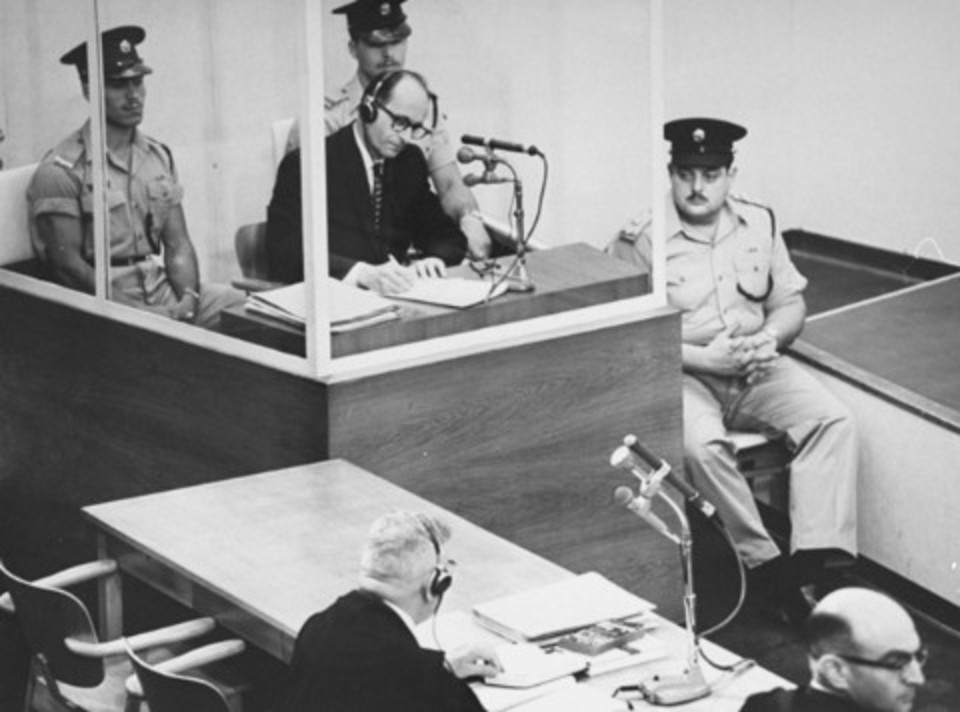
Adolf Eichmann, Photo: United States Holocaust Memorial Museum, Washington, D.C., Photograph #65268, Courtesy of Israel Government Press Office
Similar to Arendt, for Hamdan, precise observation and analysis are the keys to comprehending the inconceivable. His examination of the audio material and precise evaluation of the results are an attempt to actually prove that live ammunition was fired to shoot the teenagers and to justly solve the crimes. As Arendt clearly defined the subjectivity of her report, Hamdan, too, reflects the conditions of his analysis by exhibiting the technological apparatus operating between the incident and the judgment. At Portikus, he shows the visualized frequency bands, presents the relevant video clips, and makes the shots audible over and over again. The situation that we experience in the exhibition is not only a meticulous reconstruction of the incident, but it also offers the chance to understand how the available body of evidence was analyzed, evaluated, and interpreted. Rubber Coated Steel seeks justice while reflecting, as legal reports can never do, on how fragmentary pieces of proofs are shaped to form a conclusion.
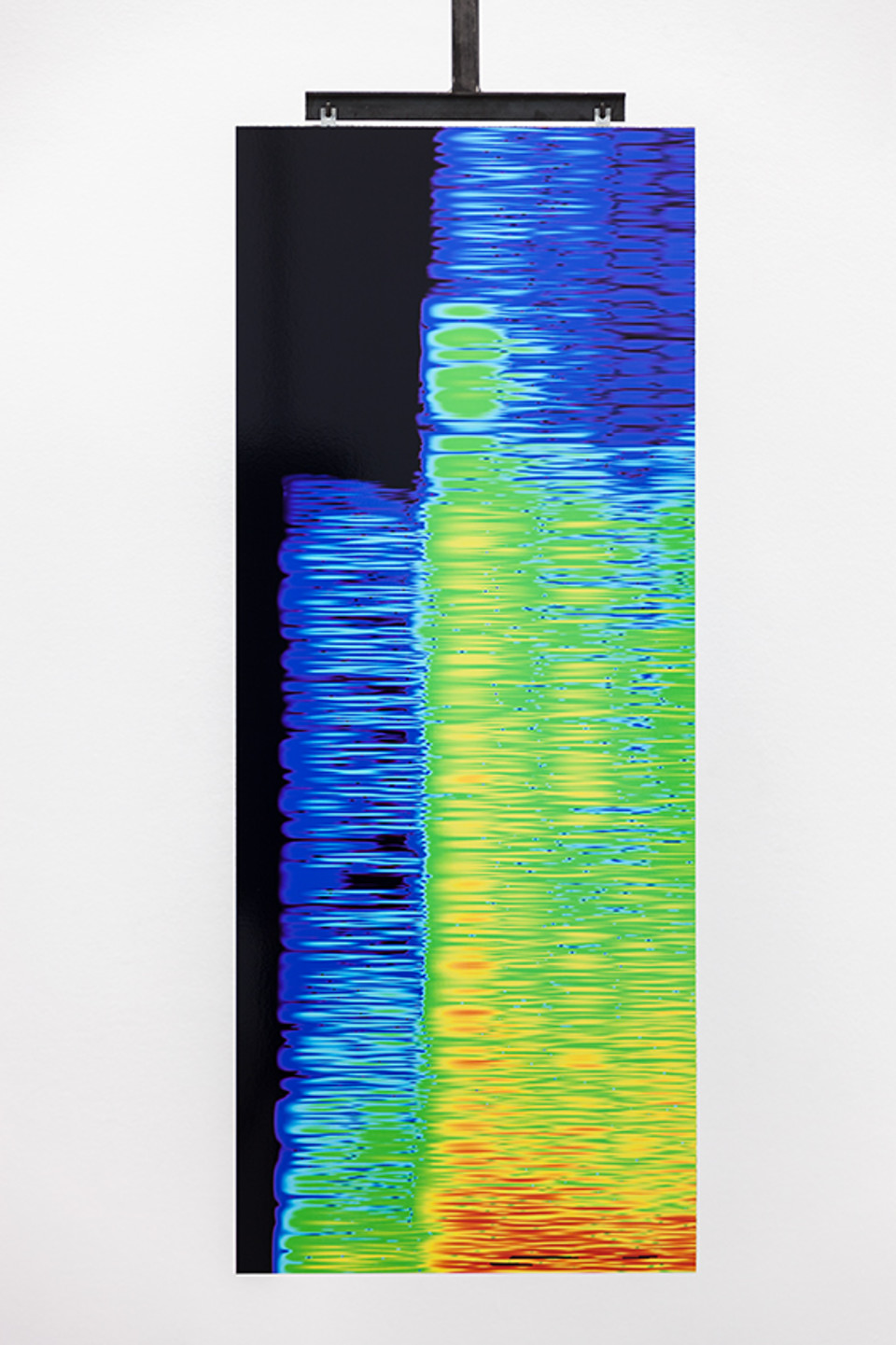
Translated by Faith Ann Gibson